Early Views of Pasadena
Historical Photos of Early Pasadena |
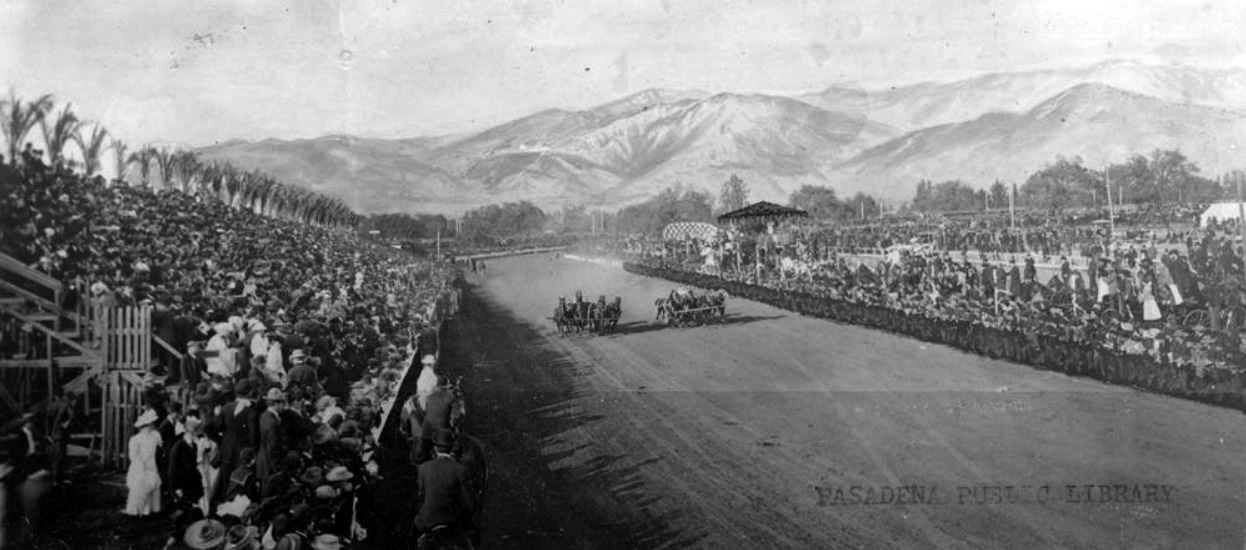 |
|
| (Early 1900s)* - View showing a couple of four-horse-drawn chariots racing in front of thousands of spectators at Tournament Park. Chariot racing was a feature of the Rose Parade in the early 1900s. |
Historical Notes For many years the main attraction in Tournament Park (the predecessor of the current Rose Bowl stadium) was chariot races, although polo matches attracted equally large crowds. |
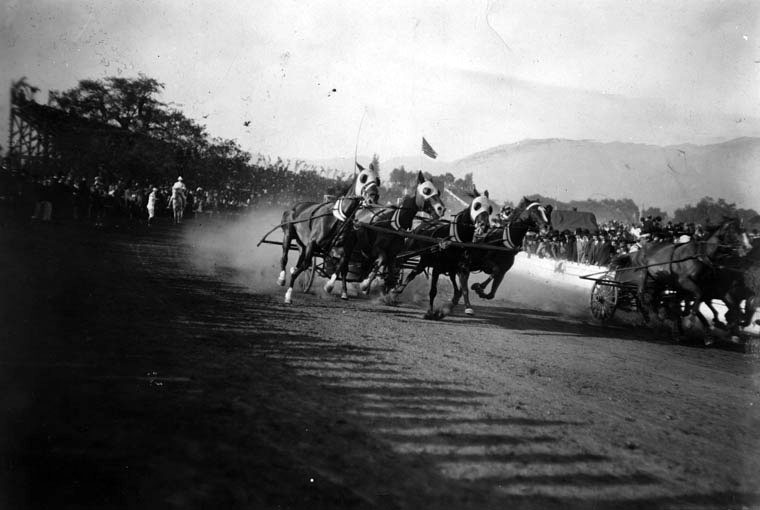 |
|
| (Early 1900s)* - A furious chariot race at the Tournament of Roses at Tournament Park. |
Historical Notes In 1902 football was substituted for chariot racing as the midwinter attraction. The first game was played between Michigan (49) and Stanford (0). The game was so lopsided that it didn't go over well with the fans and the Tournament organizers decided to revert back to the chariot races. |
* * * * * |
1st Rose Bowl (Tournament East-West Football Game)
 |
|
| (1902)* - First Tournament East-West football game, January 1, 1902, Michigan vs. Stanford. Note the crowd of people standing in foreground, and to the right side of the football field. Horse-drawn carriages are lined along a fence beyond the crowds of people. |
Historical Notes Originally titled the "Tournament East-West football game," the first Rose Bowl was played on January 1, 1902, starting the tradition of New Year's Day bowl games. The football game was added in 1902 to help fund the cost of the Rose Parade. The inaugural game featured Fielding H. Yost's dominating 1901 Michigan team, representing the East, which crushed a previously 3-1-2 team from Stanford University, representing the West, by a score of 49–0 after Stanford quit in the third quarter. Michigan finished the season 11–0 and was crowned the national champion. Yost had been Stanford's coach the previous year. The game was so lopsided that for the next 13 years, the Tournament of Roses officials ran chariot races, ostrich races, and other various events instead of football. On New Year's Day 1916 football returned to stay as The State College of Washington (now Washington State University) defeated Brown University in the first annual Rose Bowl with that explicit name. |
* * * * * |
Construction of the Rose Bowl
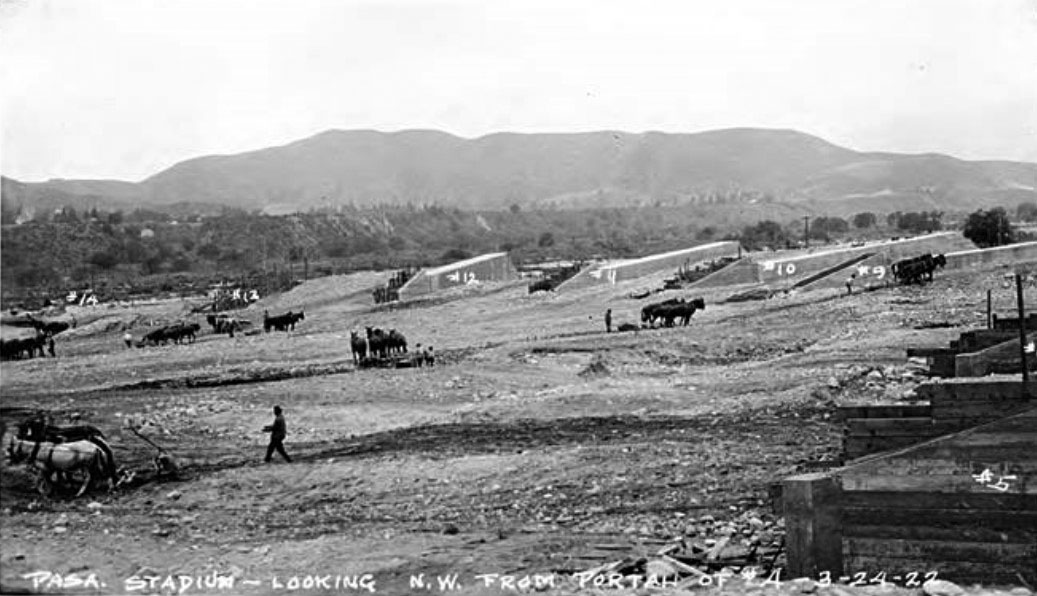 |
|
| (1922)* – View showing the early stages of construction of the Rose Bowl. The numbered structures are the tunnels, which were completed first. |
Historical Notes The idea for the Rose Bowl stadium emerged from the growing popularity of the annual Tournament of Roses football game. On March 20, 1920, the Tournament of Roses Association decided to build a stadium in Pasadena that could accommodate up to 100,000 spectators. Architect Myron Hunt, a member of the Association and respected local designer, was chosen to create the stadium's plans. In 1920, City officials declared the football facilities at Tournament Park unsafe for the growing New Year’s Day crowds. Ten-year $100 box seats were sold to raise funds for construction of a new facility. |
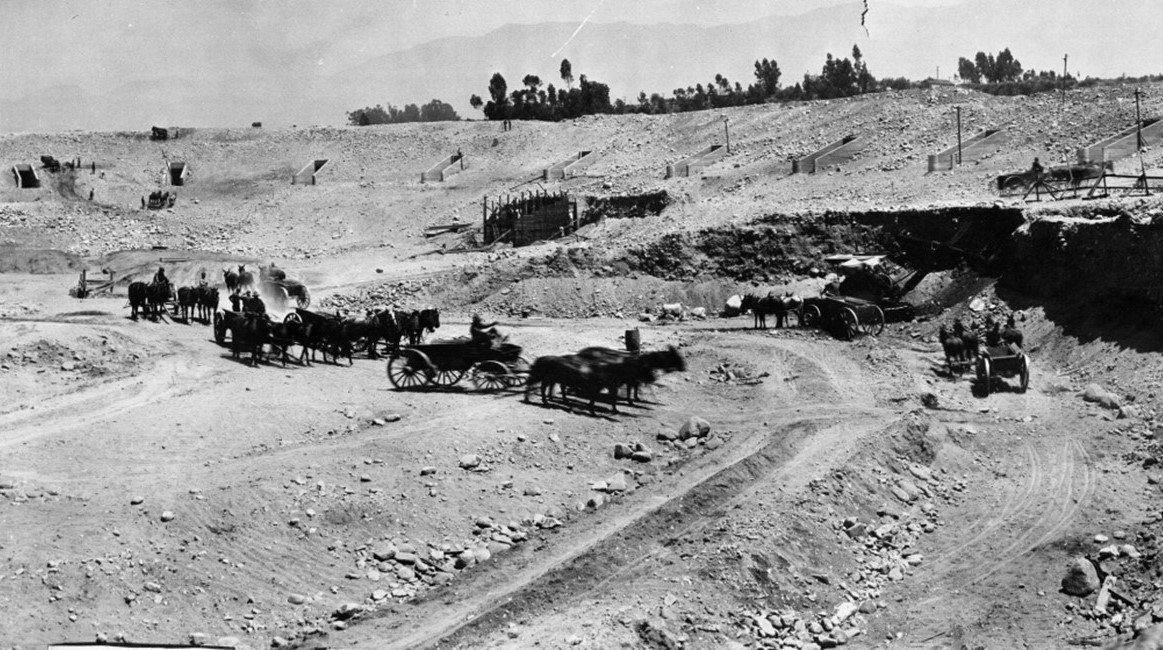 |
|
| (1922)* – Horse-drawn wagons haul off dirt during construction of the Rose Bowl Stadium. |
Historical Notes Construction of the Rose Bowl began on February 27, 1922, and was completed in just nine months, finishing in October 1922. The project employed a team of men and donkeys to dig and haul dirt, as well as to transport local river rock for the foundation. The stadium was built in the Arroyo Seco area of Pasadena, selected for its natural bowl-like topography. |
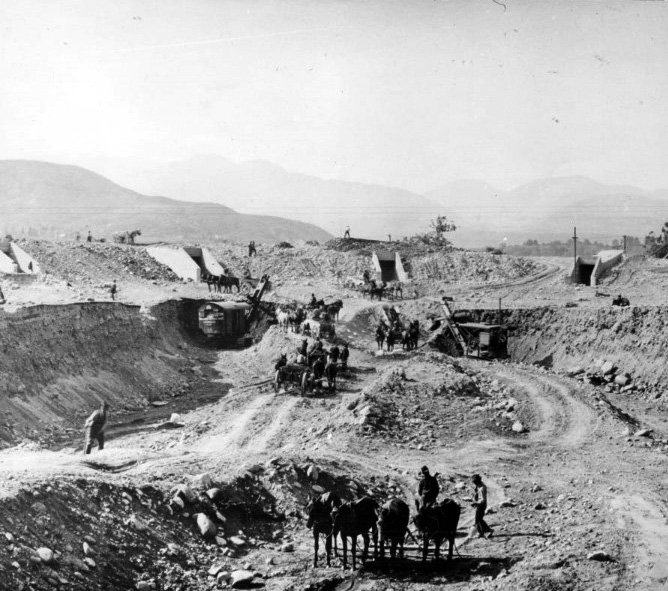 |
|
| (1922)* - The Pasadena Rose Bowl under construction in the Arroyo Seco. Construction began on February 27, 1922, following planning and design work completed in 1920 and 1921. |
Historical Notes The stadium was designed by architect Myron Hunt in 1921. His design was influenced by the Yale Bowl in New Haven, Connecticut, which was built in 1914. The Arroyo Seco dry riverbed was selected as the location for the stadium. |
 |
|
| (1922)* – View showing the Rose Bowl seats being assembled in the early stages of construction. |
Historical Notes Early construction focused on forming the concrete seating sections, tunnels, and access points. When completed in 1922, the stadium had an initial seating capacity of approximately 57,000 and was open at the southern end, forming a horseshoe shape. |
 |
|
| (1922)* - View looking west toward the San Rafael Hills showing horse-drawn wagons removing dirt and rock during construction. |
Historical Notes The rugged terrain of the Arroyo Seco required careful grading and planning. Roads, drainage systems, and utilities were integrated into the uneven canyon floor during construction. |
.jpg) |
|
| (1922)* - Another view showing the construction work on the Rose Bowl. |
Historical Notes Despite these environmental and structural challenges, the construction team successfully transformed this natural canyon into one of the most iconic sports venues in the United States. The Rose Bowl not only became an architectural marvel but also preserved the natural beauty of its original setting. |
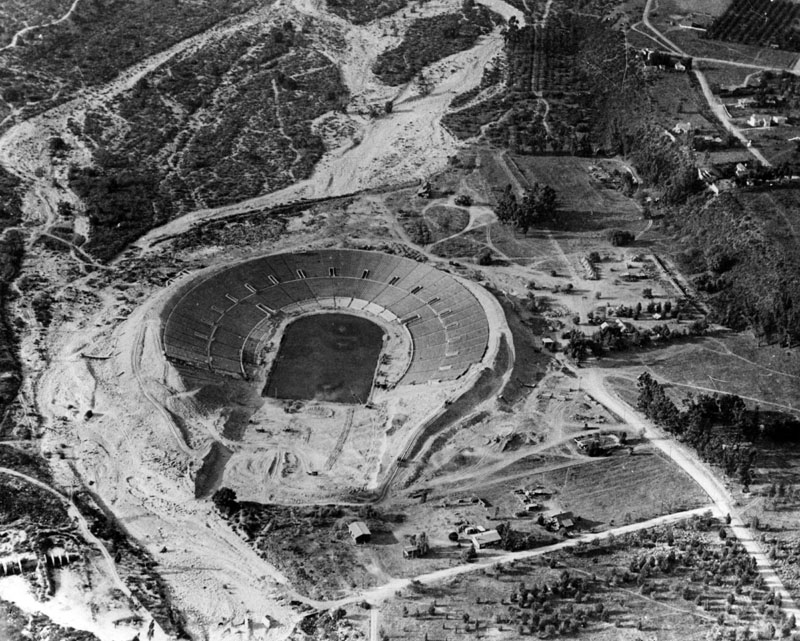 |
|
| (1922)* - Aerial view showing the Rose Bowl taking on its original horseshoe shape. |
Historical Notes The Rose Bowl was under construction for about a year. The stadium was designed to bring spectators close to the field while maximizing capacity within the natural bowl. Construction costs came in under budget, allowing funds to be reserved for future expansion. |
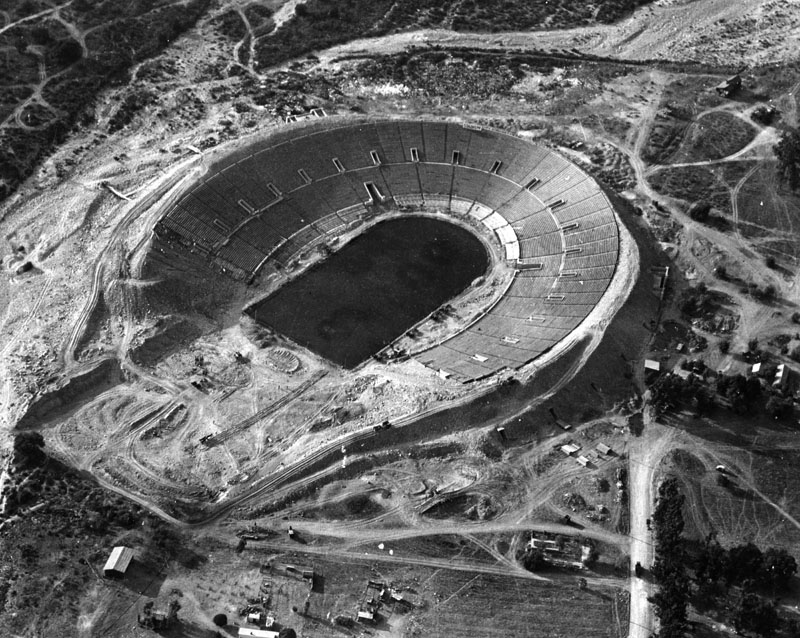 |
|
| (1922)* - A closer aerial view of the Rose Bowl under construction. |
Historical Notes The Rose Bowl was completed in October 1922, just several months prior to the completion of the nearby Los Angeles Memorial Coliseum, May 1923. The first game was a regular season contest on October 28, 1922 when Cal defeated USC 12–0. This was the only loss for USC and California finished the season undefeated. California declined the invitation to the 1923 Rose Bowl game and USC went in their place. |
Then and Now
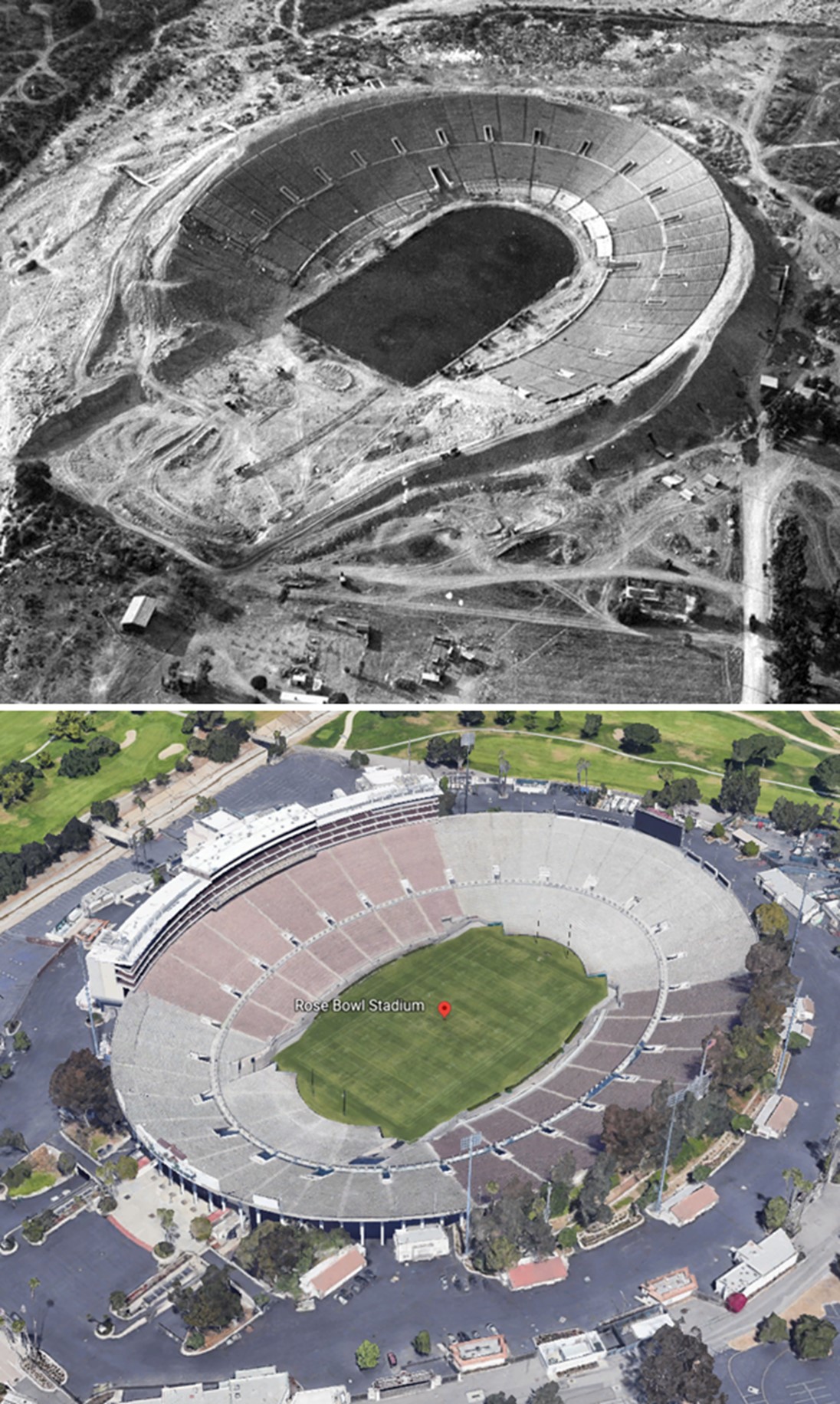 |
|
| (1922 vs. 2022)* - Then and Now. Photo comparison by Jack Feldman. |
Historical Notes The Rose Bowl stadium has undergone significant changes since its original construction in 1922, evolving from an open horseshoe into a complete bowl. Major renovations, including work completed in 2016, modernized the facility while preserving its historic character. |
 |
|
| (1923)* - Panoramic view of the 1923 Rose Bowl Game between Penn State University and the University of Southern California at the Rose Bowl Stadium in Pasadena. The stands are almost filled, with the exception of some of the higher areas on the far side of the stadium. Small groups of what appear to be military men are seated on chairs on the track surrounding the field. The game is in progress, with the two teams in the middle of a series near midfield. There are men positioned at several places along the near sideline with photographic cameras, and one man near midfield has a motion picture camera. There is a very tall flag pole on the far right with a large American flag. A large number of automobiles are parked on the far right, beyond the open part of the stadium, where there are also a couple hundred people watching the game over the stadium fence. |
Historical Notes January 1, 1923 was the first time that the Rose Bowl Game was held at the Rose Bowl Stadium. The game featured Penn State University and the University of Southern California. Start of play was delayed more than an hour when Penn’s team was stuck in traffic. USC would go on to defeat Penn State 14 to 3. The name of the stadium was alternatively "Tournament of Roses Stadium" or "Tournament of Roses Bowl", until being settled as "Rose Bowl" before the 1923 Rose Bowl game. Click HERE to see more in Early Views of USC. |
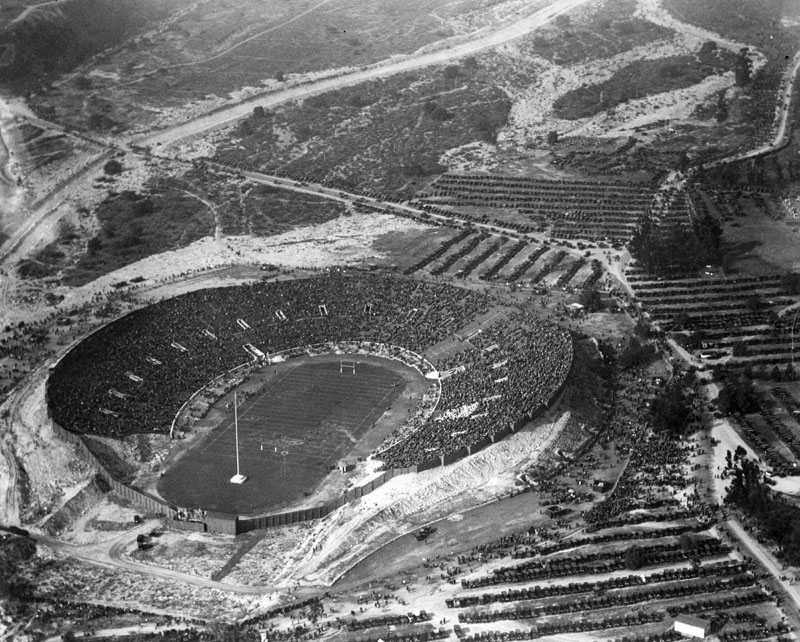 |
|
| (1925)* - Aerial view of the Rose Bowl on New Years Day, January 1, 1925. The stadium is almost full, yet crowds of people are still walking in. The football score that day was: Notre Dame, 27 vs Stanford, 10. |
Historical Notes Originally built as a horseshoe, the stadium was expanded several times over the years. The southern stands were completed in 1926, making the stadium a complete bowl. |
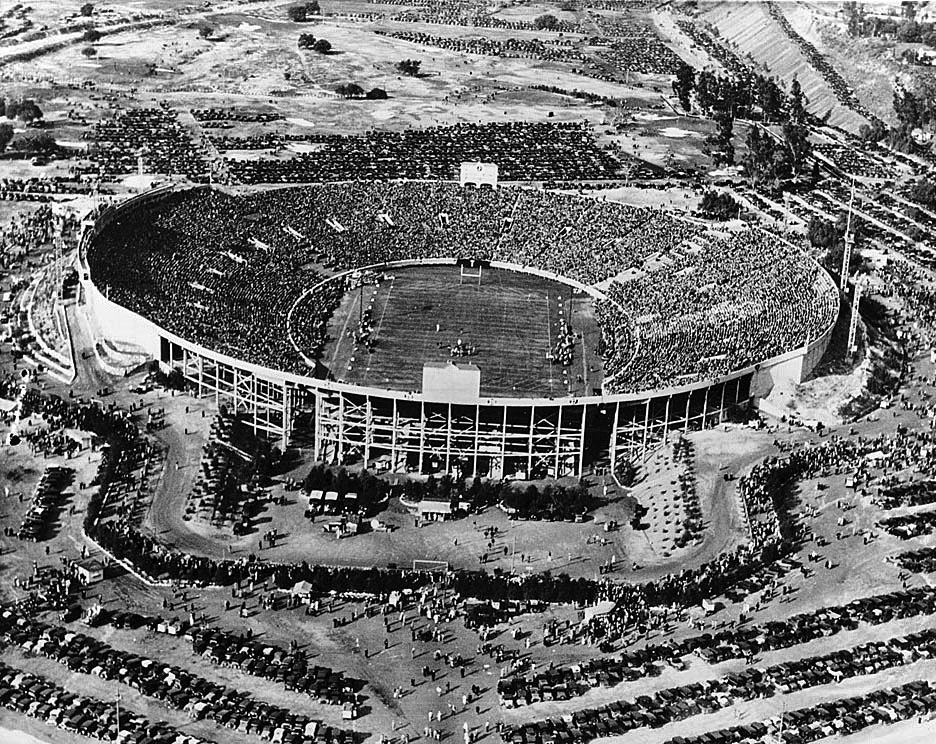 |
|
| (1926)* - Aerial view looking north showing the 1926 Rose Bowl game. |
Historical Notes The 1926 Rose Bowl Game is commonly referred to as "the game that changed the south." The game featured the Alabama Crimson Tide, making their first bowl appearance, and the Washington Huskies. Alabama was victorious 20–19, as they scored all twenty points in the third quarter. With the victory, the Crimson Tide was awarded its first National Championship. The game made its radio broadcast debut, with Charles Paddock, a sports writer and former Olympian track star, at the microphone. Alabama’s coach, Wallace Wade, was later inducted into the Rose Bowl Hall of Fame (1990). |
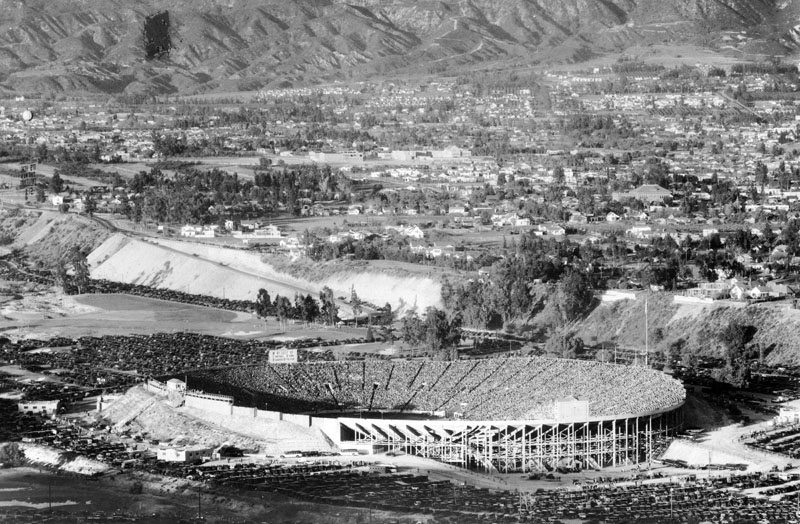 |
|
| (ca. 1928)* - Aerial view of the Rose Bowl after the southern stands were constructed making it a complete bowl. Though the stadium appears to be filled to capacity, people are still trickling in, and row upon row of automobiles can be seen neatly parked in the lots. View also shows the residential homes surrounding the stadium, as well as the mountains in the background. |
Historical Notes For many years, the Rose Bowl had the largest football stadium capacity in the United States. From 1972 to 1997, seating capacity reached 104,594. The current official seating capacity is 92,542. The stadium was designated a National Historic Landmark in 1987. |
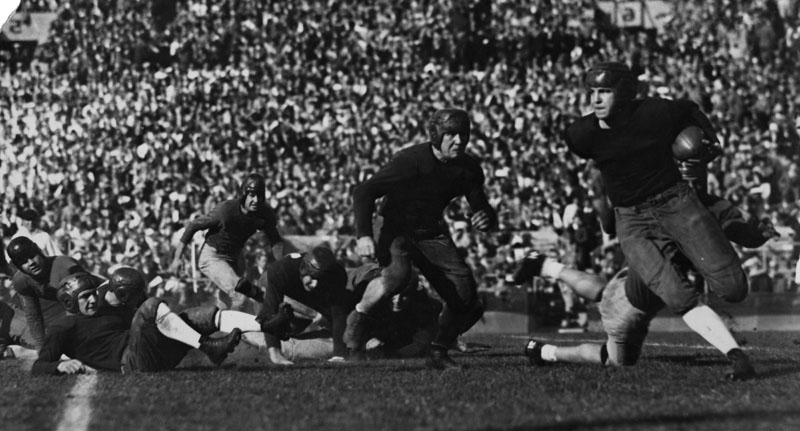 |
|
| (1929)* - Georgia Tech player Mizell carries the ball during the Rose Bowl Game, January 2, 1929. |
Historical Notes The January 2, 1929 Rose Bowl Game featured Georgia Tech and the University of California. Georgia Tech won the closely contested game by a score of 8 to 7. |
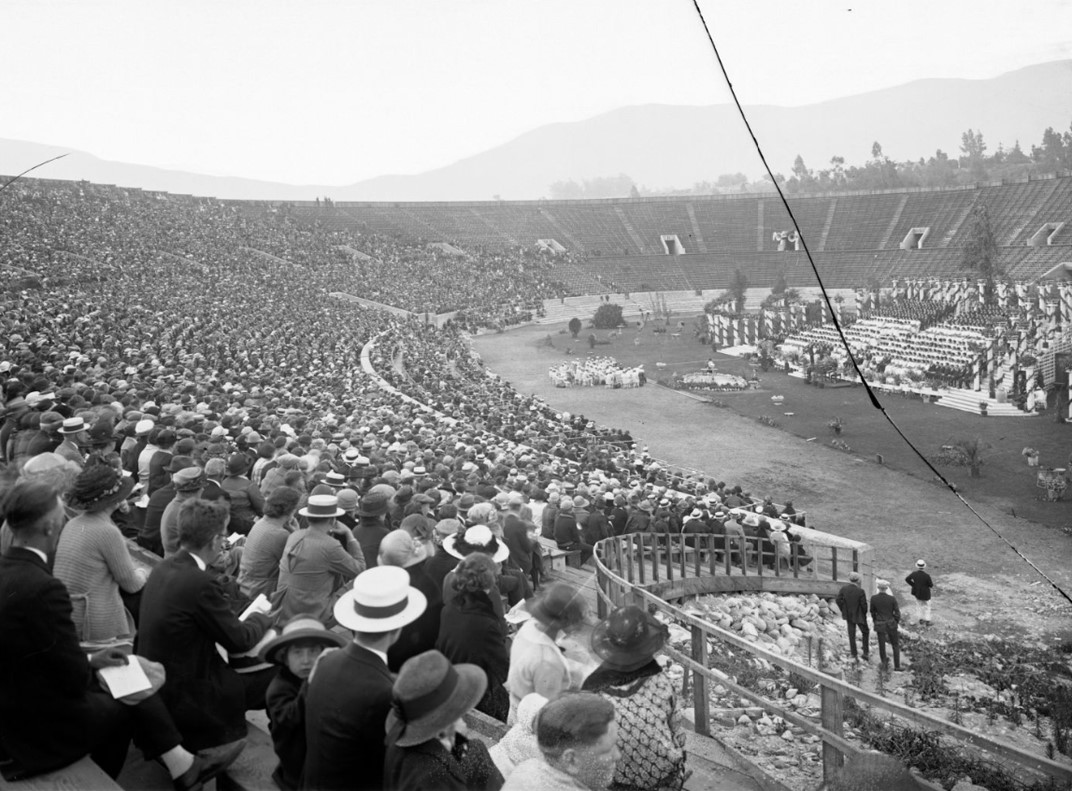 |
|
| (ca. 1924)* - A view of the Pasadena High School commencement ceremony at the Rose Bowl. A large crowd of spectators fills about half of the stadium. There are freestanding white bleachers on the far side which are occupied by the students, and a band is on the field in front of them. |
Historical Notes Today, the stadium still hosts commencement ceremonies for John Muir High School and Pasadena High School. It also hosts the annual football homecoming game, called the Turkey Tussle, between Pasadena High School and John Muir High School, in mid-November. Click HERE to see more Early Views of the Rose Bowl (1930s & 1940s). |
* * * * * |
Tournament of Roses Parade
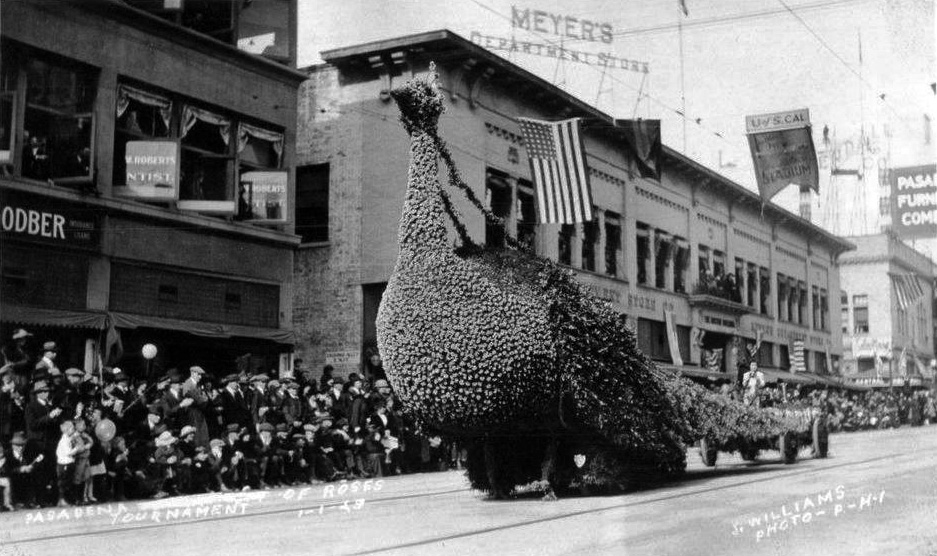 |
|
| (1923)^ – Postcard view showing the City of Glendale’s prize winning peacock float at the 1923 Tournament of Roses Parade, with Meyer’s Department Store in the background. |
Historical Notes Click HERE to see early Tournament of Roses Parades. |
* * * * * |
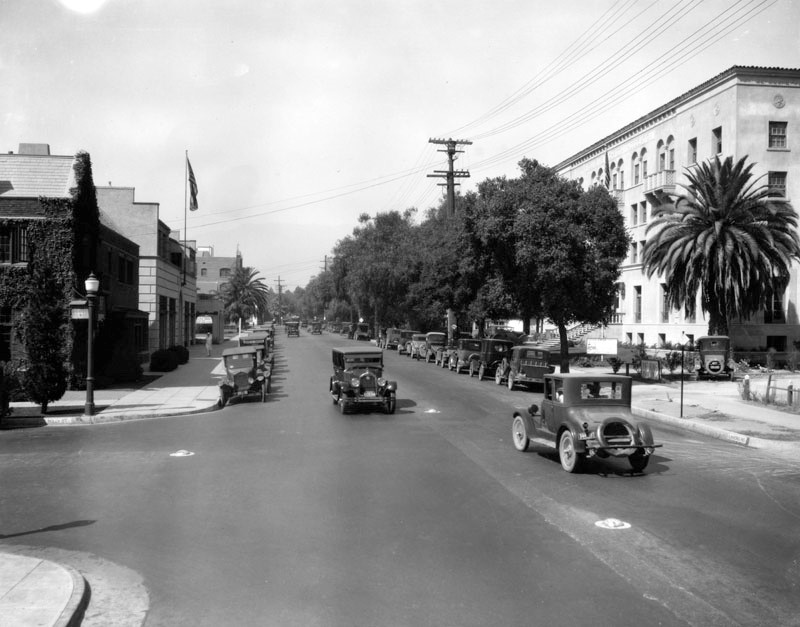 |
|
| (ca. 1923)* - View looking north on Marengo Avenue in Pasadena. The building on the left with the flag is the American Legion Post No. 13, located at 131 N. Marengo Avenue. |
Historical Notes The American Legion is an organization of U.S. war veterans formed in Paris on March 15–17, 1919, by delegates from all units of the American Expeditionary Forces. Their main mission is to sponsor programs that improve veterans communities, such as scholarships, veterans help programs (i.e. ending veterans homelessness), and youth sports. They also promote national security, patriotism, and devotion to veterans.*^ |
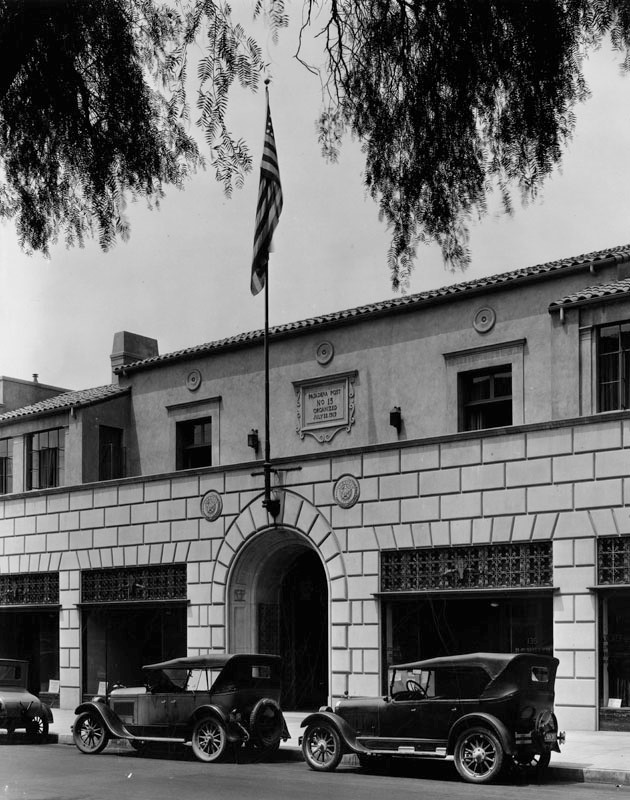 |
|
| (ca. 1926)* - Close-up view of the entrance to the American Legion Post No. 13 on Marengo Avenue, Pasadena, showing iron work over the windows and dedication carved into stone over the entrance. |
Historical Notes The Pasadena Post No. 13 was organized July 22, 1919. Architects Marston and Van Pelt designed the building, which was built in 1925.* |
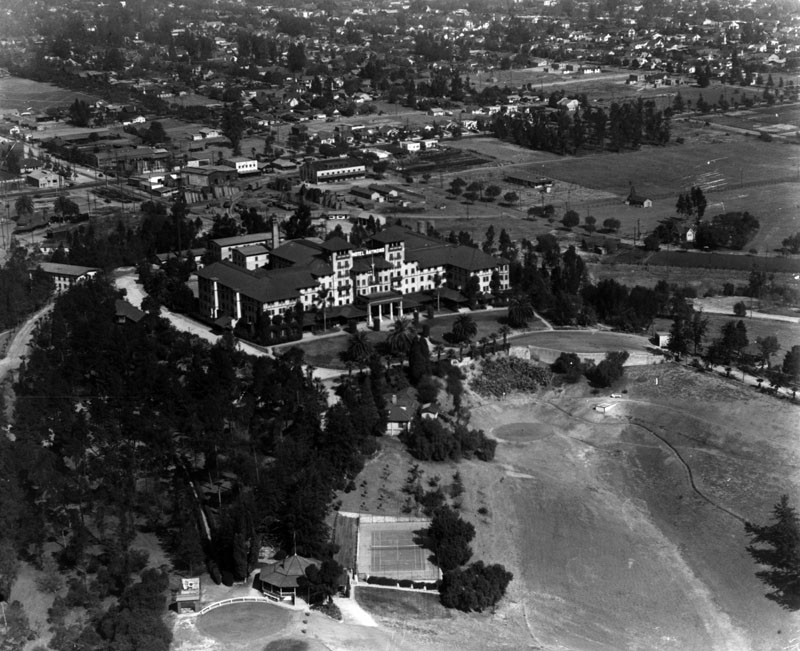 |
|
| (1924)* - Aerial view of the second Raymond Hotel looking across the grounds at the western facade, the main entrance to the hotel. Extensive urban development can be seen in the background. |
Historical Notes Located atop Bacon Hill, renamed Raymond Hill, which lies between Pasadena and South Pasadena, the first Raymond Hotel burned down in 1895 and was replaced by a second in 1903. The architect was T. W. Parkes. In 1934 the hotel was torn down for residential development due to fallout from the Great Depression.* |
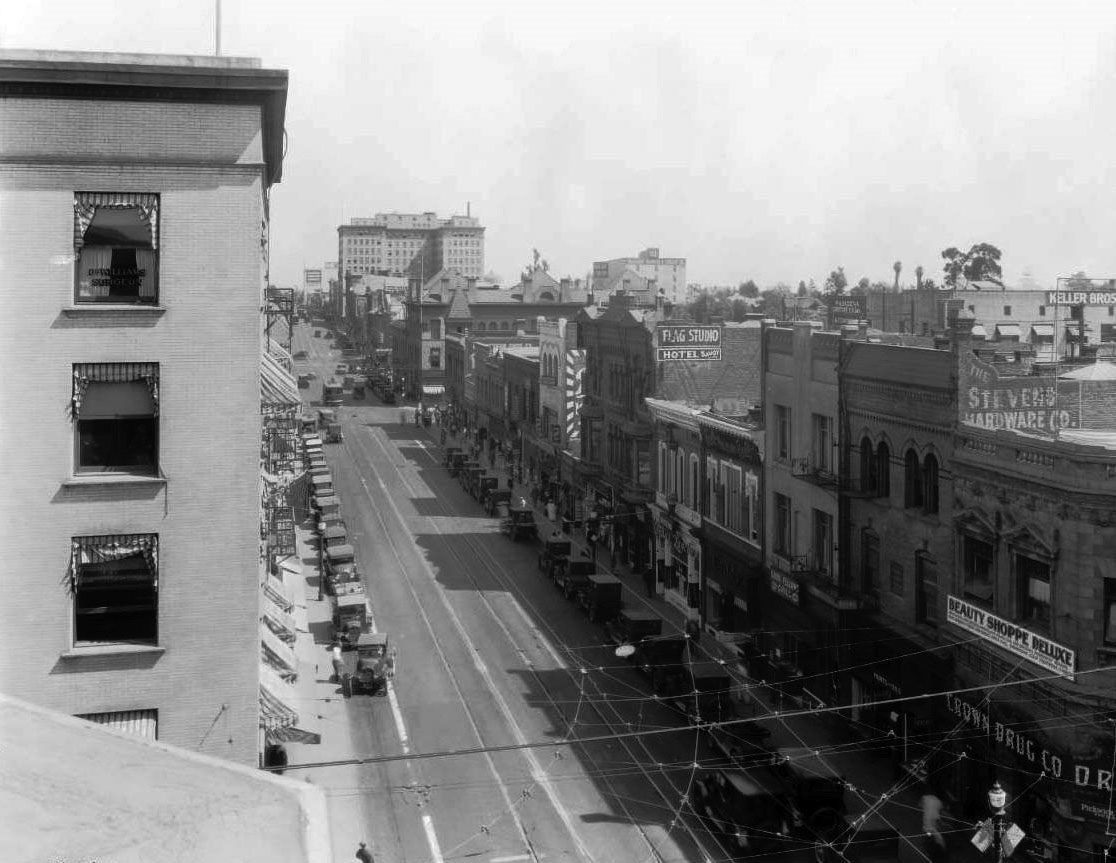 |
|
| (1925)++# - View looking east from the rooftop of building at the northwest corner of Fair Oaks Avenue and Colorado Boulevard. The large building in the distance is the Pacific Southwest Trust and Savings Bank Building. |
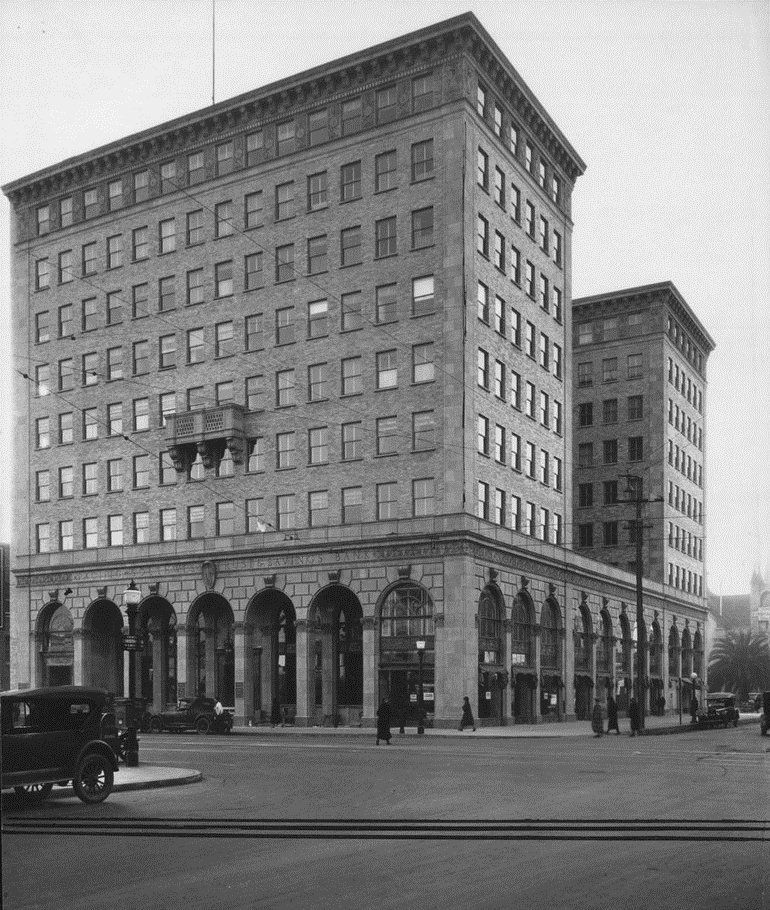 |
|
| (1925)^ - View of the Pacific Southwest Trust and Savings Bank Building at 234 East Colorado Boulevard, at the corner of Marengo and Colorado. |
Pasadena Furniture Company Building (later Sears)
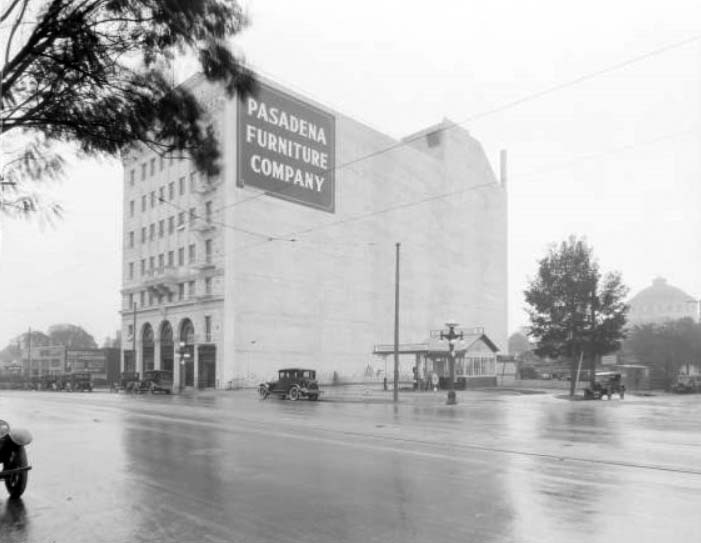 |
|
| (1924)**- Rainy day view of the Standard Oil Station at 520 East Colorado and the multi-story Pasadena Furniture Company next door. |
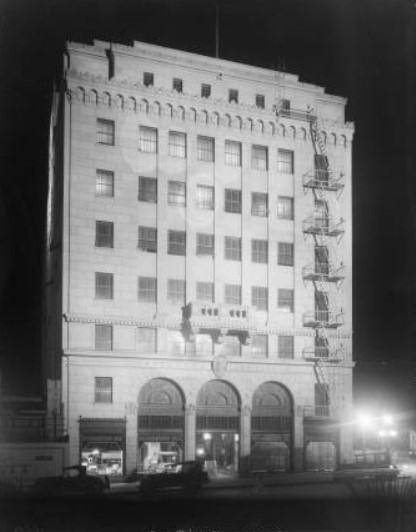 |
(1925)**- Night view of the exterior of the Pasadena Furniture Company at 530 East Colorado.
|
 |
|
| (1926)**- A street view of the newly completed Singer Building at 520 East Colorado, next to the Pasadena Furniture Company building. Displays of sewing machines visible in the windows. Note the ornate streetlight on the corner. |
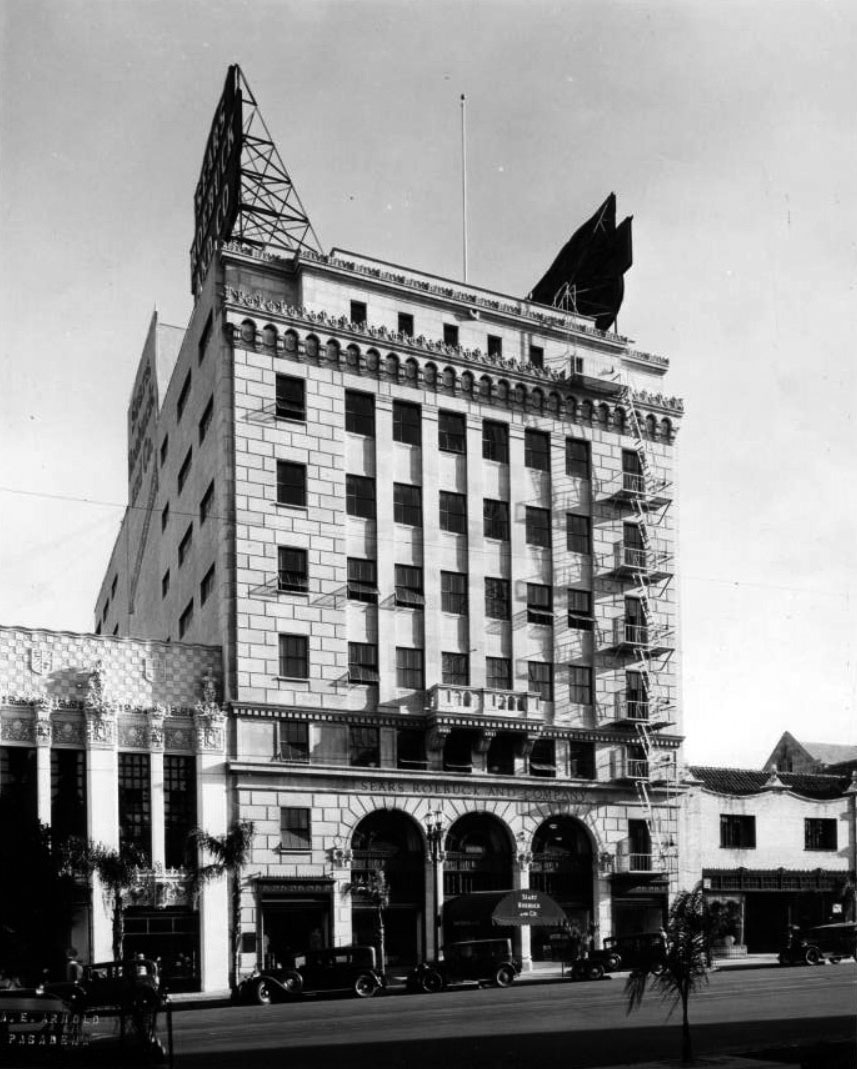 |
|
| (ca. 1930)** – View showing Pasadena's Sears, Roebuck and Company building, previously Pasadena Furniture Co Building. The Singer Building is seen to the right. Click HERE for contemporary view. |
Historical Notes Pasadena's Sears, Roebuck and Company was located at 532 East Colorado Street. Sears sold nearly everything one could want--from linoleum to sofas, trousers to electric refrigerators, washing machines to roofing materials, and building supplies to automobile accessories. The building was previously occupied by the Pasadena Furniture Company. Sears bought the building after the Pasadena Furniture Company went out of business. |
* * * * * |
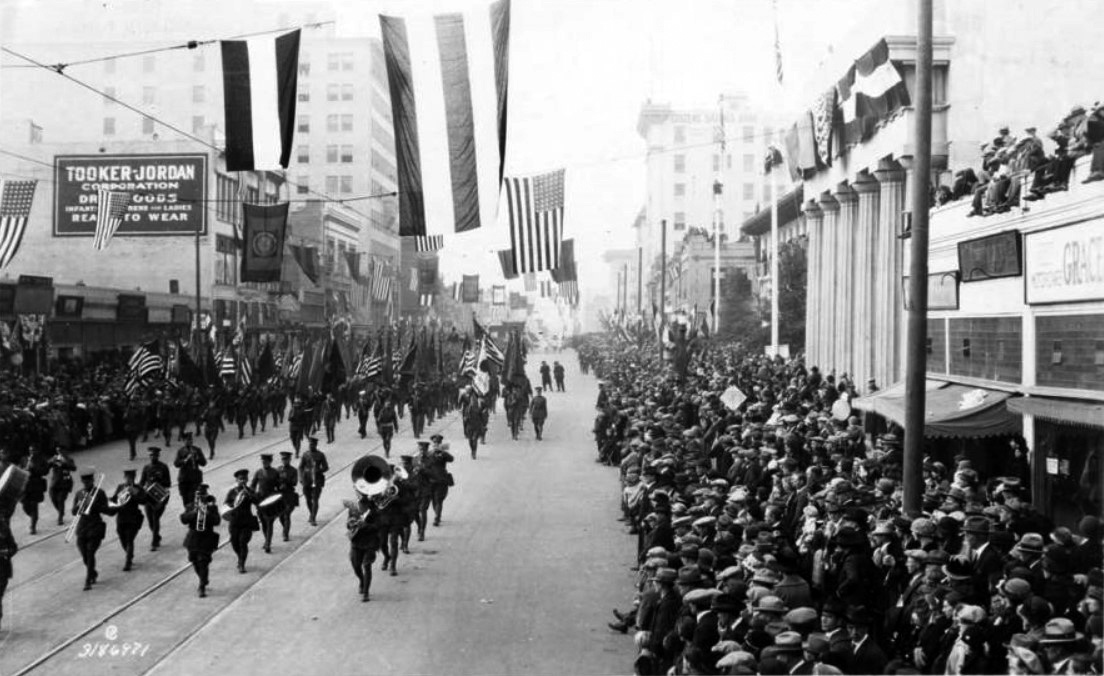 |
|
| (1925)** – People line the streets as the American Legion band marches by at the Tournament of Roses Parade. Note the spectators on the roof at right. |
 |
|
| (1925)*^* – View showing what appears to be the last float in the Rose Parade with hundreds of people all around. |
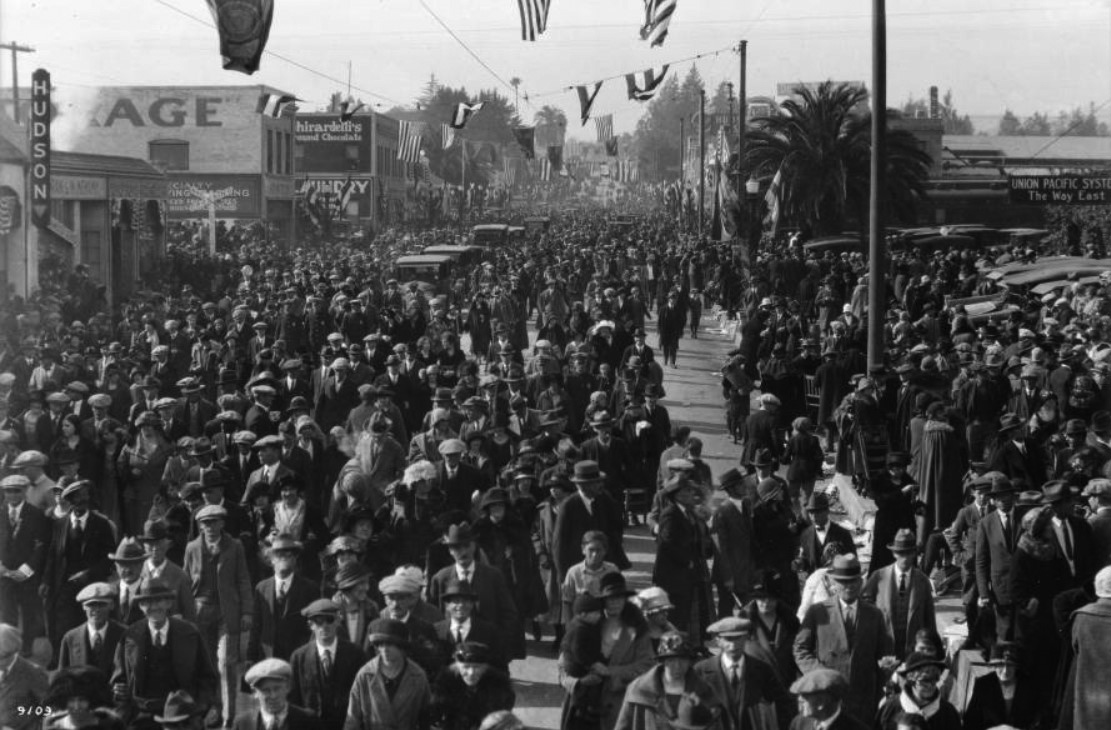 |
|
| (1925)^ – Throngs of people are filing down the street after the Tournament of Roses Parade. The Union Pacific Station's banner reading: "Union Pacific System, The Way East" can be seen in the right background. |
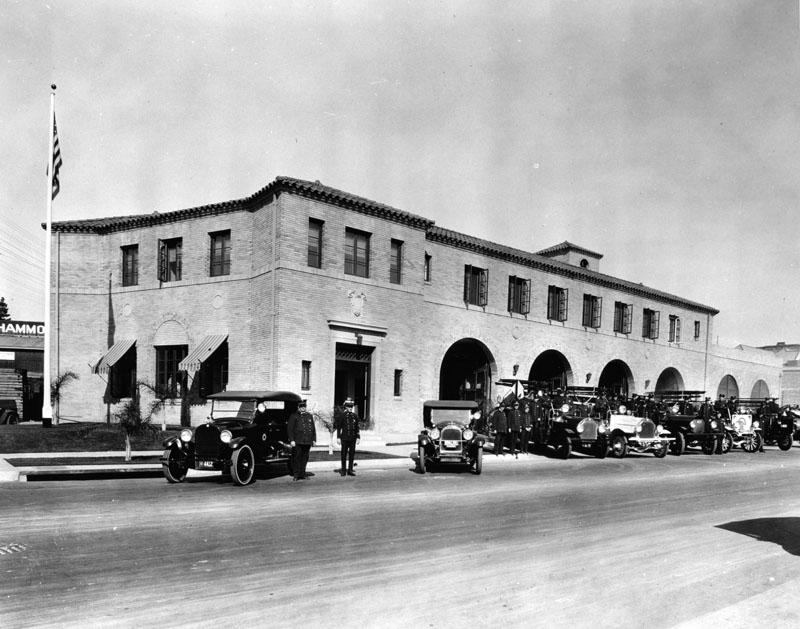 |
|
| (ca. 1925)* - Exterior view of the central fire house in Pasadena. View shows groups of firemen standing next to their fire engines outside of the building. |
 |
|
| (1929)* - Group photo of Pasadena's motorcycle policemen. |
 |
|
| (1926)^ - A couple and their Hudson sedan arrive at the Santa Fe Station on Raymond Avenue, Pasadena. The sign on the building to the right reads: Kerckhoff-Cuzner Mill & Lumber Co.*^^ |
Historical Notes William Kerckhoff, a German-American, began his career in Los Angeles with the Jackson Lumber Company. Later he and Guy Cuzner owned the Kerckhoff-Cuzner Mill and Lumber Company. To transport lumber, the company was the first to use oil for fuel in an ocean going vessel. In the 1890s, Kerchoff founded the San Gabriel Power Company. By the turn of the century, together with A.C. Balch, he owned half the stock of Henry E. Huntington Pacific Light & Power Company used to provide electricity to Pacific Electric, and he served as its President. In 1902, they purchased the San Joaquin Electric Company. They also founded Southern California Gas Corporation in 1910, and built a 120-mile pipeline from the San Joaquin Valley to Los Angeles.*^ |
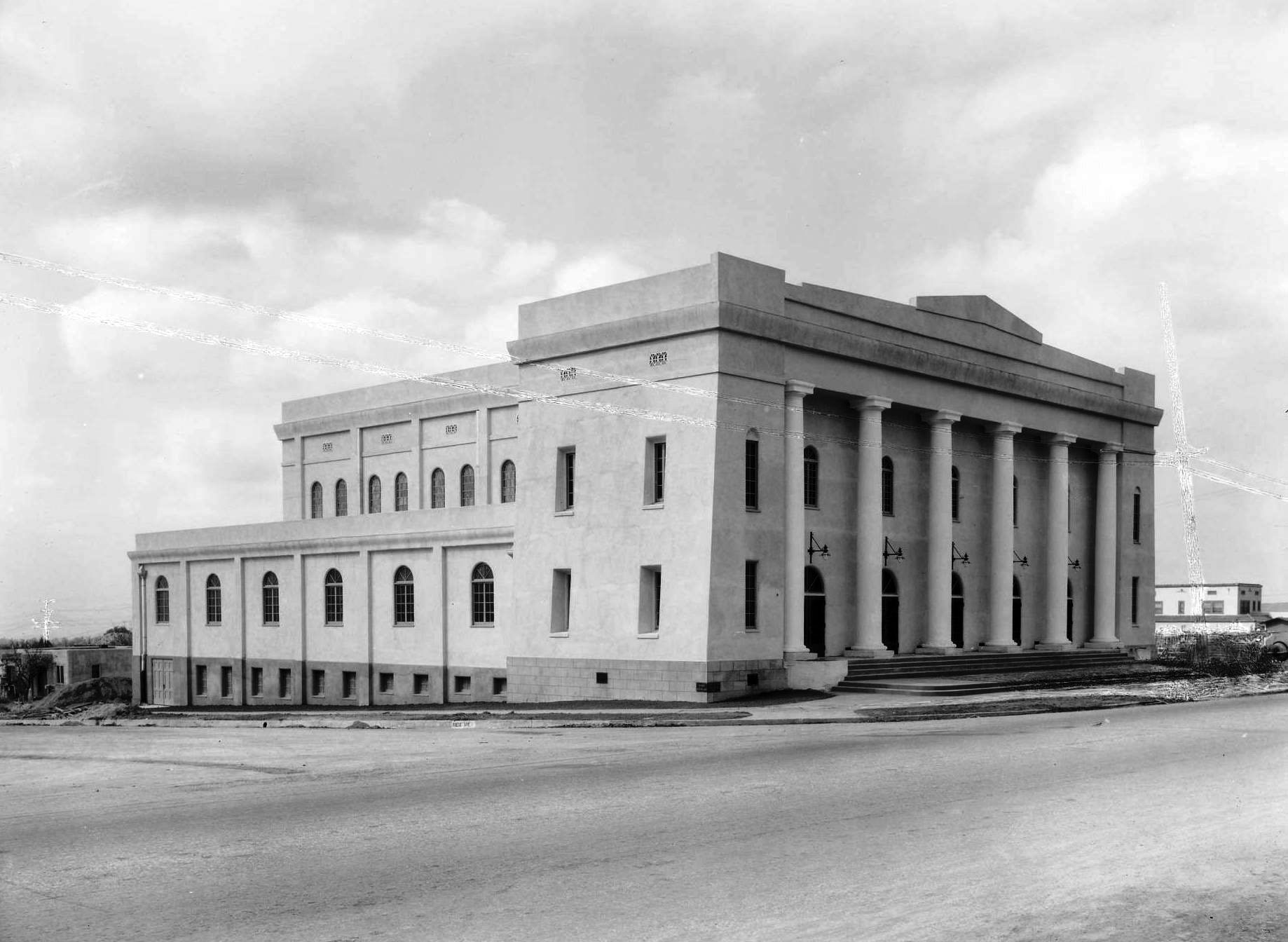 |
|
| (1926)*^* - Church of the Nazarene at 1565 East Washington, at the corner of Washington and Breese. Someone seems to have tried to conceal the presence of the power lines in the fore- and background. Today, the building is occupied by the The Armenian Church of the Nazarene. Click HERE to see a current view (2016). |
Historical Notes The Armenian Church of the Nazarene in Pasadena was founded in 1986. The church is one of a handful of other Armenian Nazarene churches in the Los Angeles area, including the original one in Glendale. |
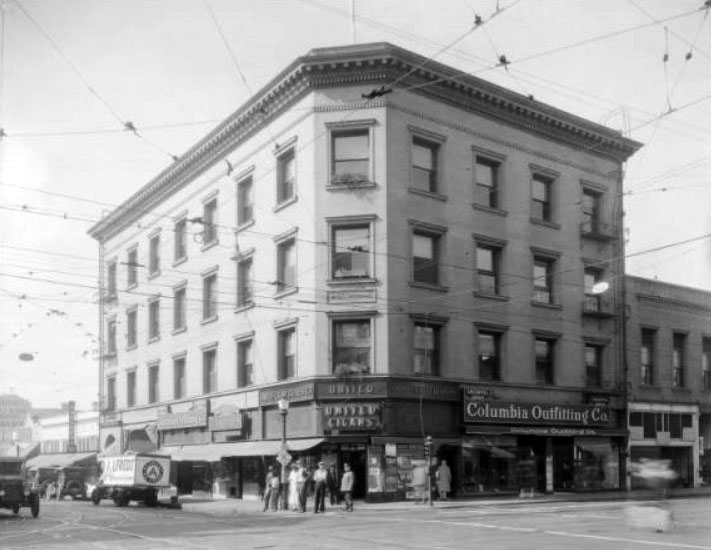 |
|
| (1926)#* - Street view of the Dodsworth Building at 1 South Fair Oaks, at the southwest corner of Colorado and Fair Oaks. The businesses in the building include United Cigars and Columbia Outfitting Co. Numerous overhead wires for streetcars are seen in front. |
Historical Notes United Cigar Stores was the largest chain of cigar stores in the United States. Though initially specializing in cigars, it eventually sold many other items, such as Mickey Mouse watches and shoe trees. The chain was founded in 1901 and represented the interests of the Consolidated Tobacco Company, the tobacco trust that controlled the American Tobacco Company and others. In September 1903 a settlement was reached with the chain's competitors and all competition ended. By 1926 the chain had close to 3000 retail stores.*^ |
 |
|
| (1926)#* - View of crowds filling the street at Colorado and Fair Oaks Ave., Rose Parade, Jan. 1, 1926. |
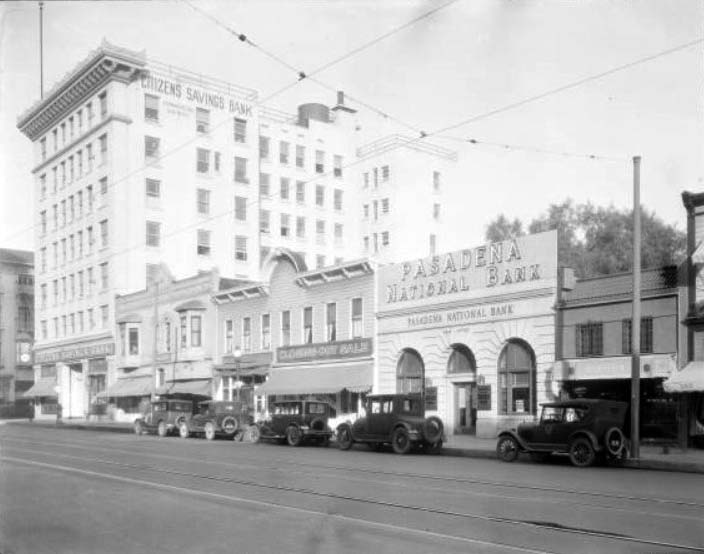 |
|
| (1927)** - Street view of the 200 block of East Colorado, centering on Pasadena National Bank and Citizens Bank at 249 East Colorado. Other businesses on the block include the Citizens Savings Bank, Daily Bread Shop, and Oriental Art Bazaar. Automobiles are parked along the street and wires run overhead for streetcars. |
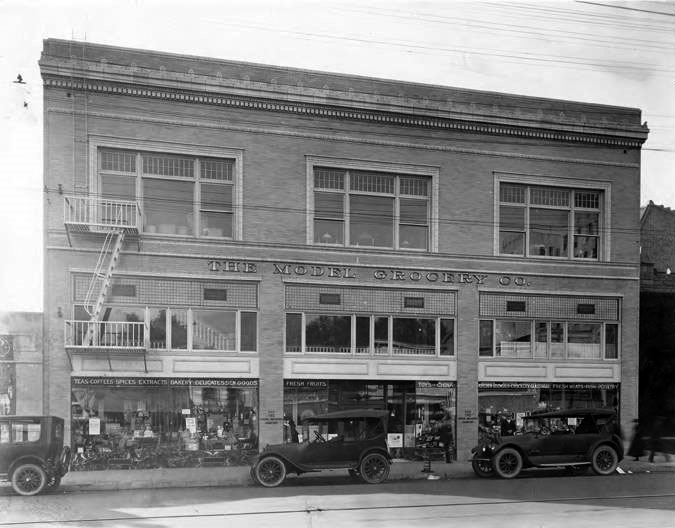 |
|
| (1926)^^*# - View showing three cars parked in front of The Model Grocery store located on Colorado near Fair Oaks Avenue. HISTORIC HEADLINE FROM June 23, 1926: Model Grocery to close for picnic: Employees and families to pass day at beach tomorrow. |
Historical Notes The Model Grocery was one of Pasadena’s best-known names in the local market business. The company got its start at a store located at 21-25 North Fair Oaks Avenue. By the 1920s it had more than 250 employees, as well as its own bakery, line of household equipment, a candy department, a post office, and other customer amenities.+^+ |
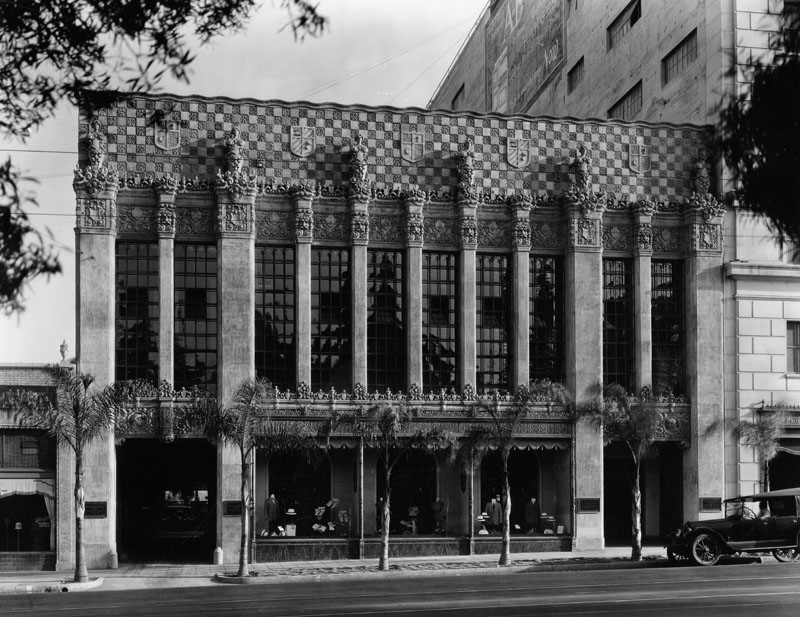 |
|
| (1927)* - Exterior view of I. Magnin store located in Pasadena. Note the architectural design on the pillars and front of the building. Placques outside of building reads, "Mullen & Bluitt..." |
* * * * * |
Don Lee Cadillac
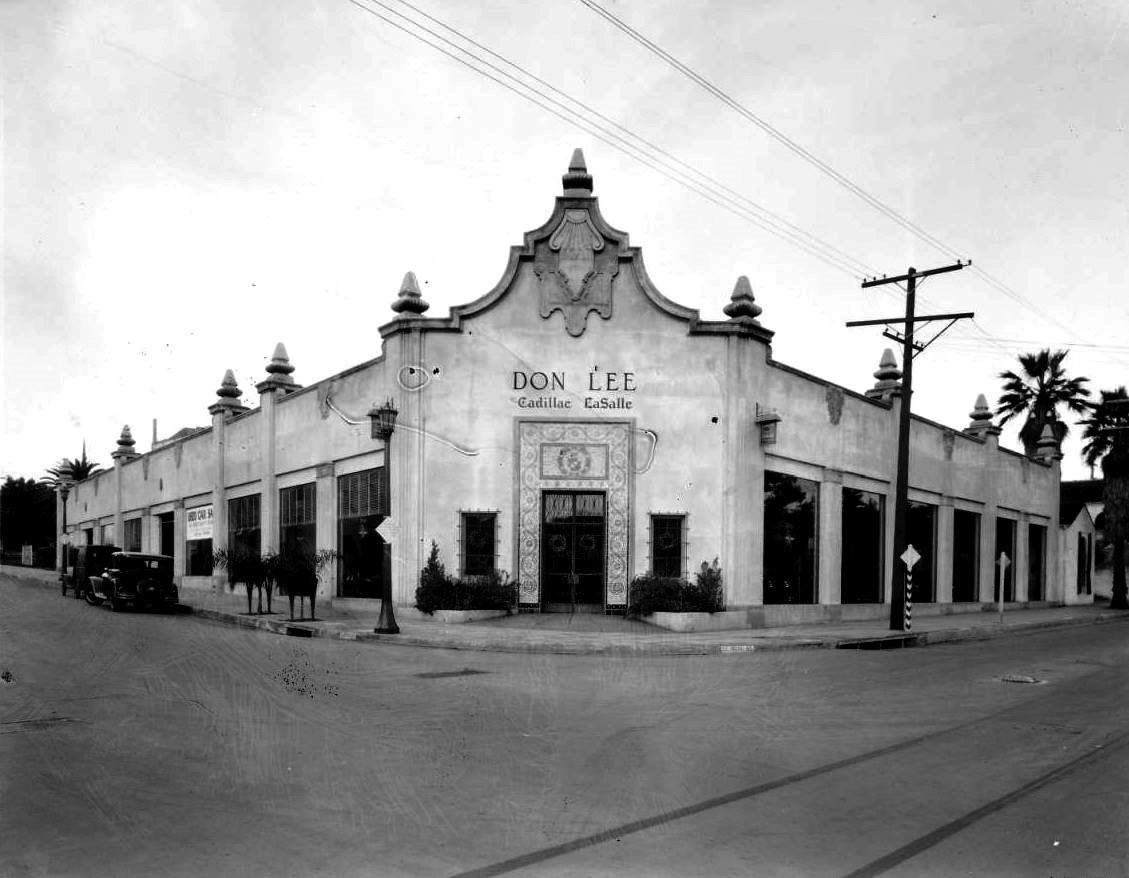 |
|
| (1927)* - View looking at the building located on northwest corner of Green and El Molino, home of Don Lee Cadillac & LaSalle. The Pasadena Playhouse is located futher north on El Molino, on the right by the palm trees. The architects of this structure were Marston and Maybury. |
Historical Notes Don Lee was the west coast's most successful Cadillac dealer. He held the franchises for California and Nevada Cadillac dealerships, fostered Los Angeles radio, and was a leading pioneer of television on the West Coast. He was also famous for his Don Lee Mutual Broadcasting Studio and Mt. Lee Tower in Hollywood. |
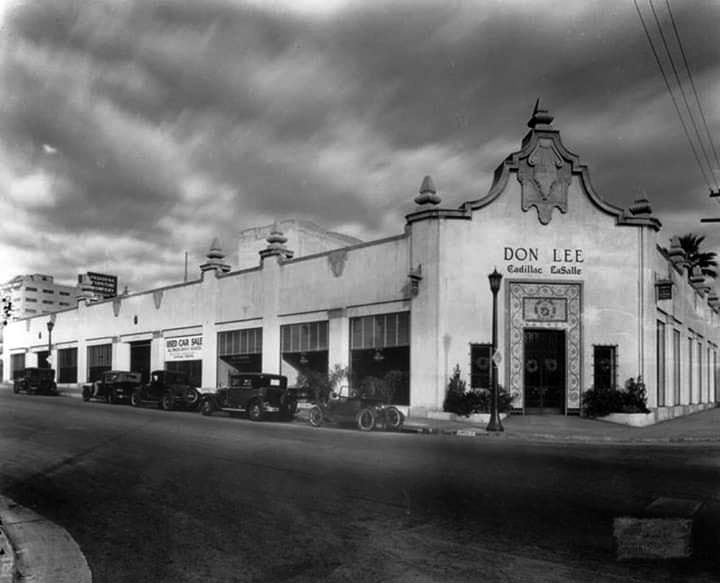 |
|
| (ca. 1927)^ - View looking at the NW corner of Green Street and El Molino Avenue showing the Don Lee Cadillac & LaSalle dealership. |
Historical Notes The building today is occupied by Jacob Maarse Florists. Click HERE to see contemporary view. |
Then and Now
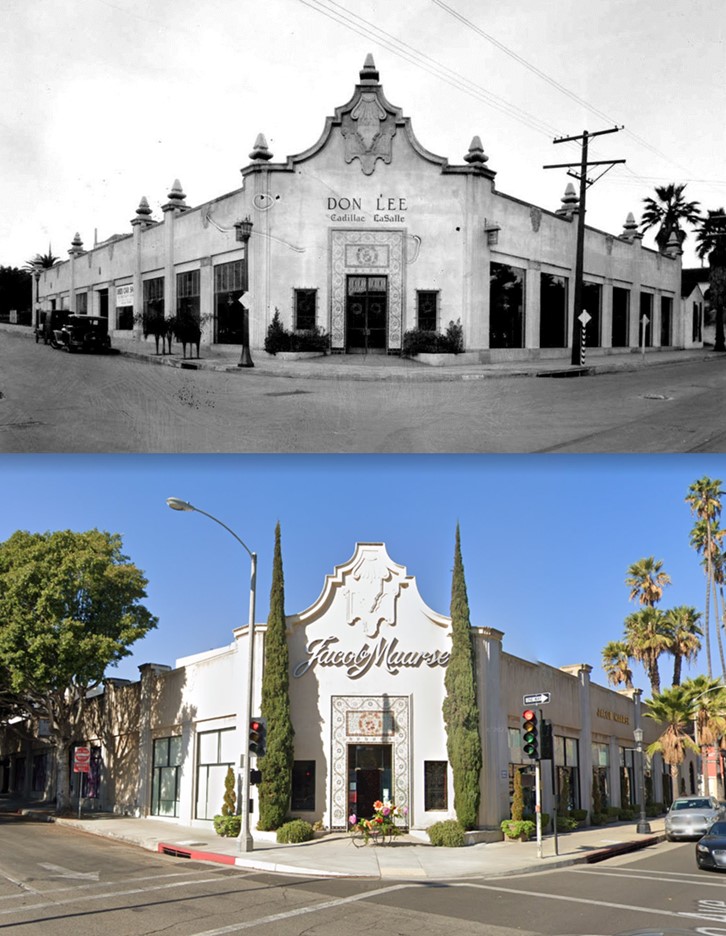 |
|
| Then and Now – Looking at the northwest corner of Green and El Molino in Pasadena. Originally home to Don Lee Cadillac, currently Jacoby Maarse Florists with Pasadena Playhouse to the right out of view (1927 vs. 2020)*. |
* * * * * |
Pasadena Star-News Building
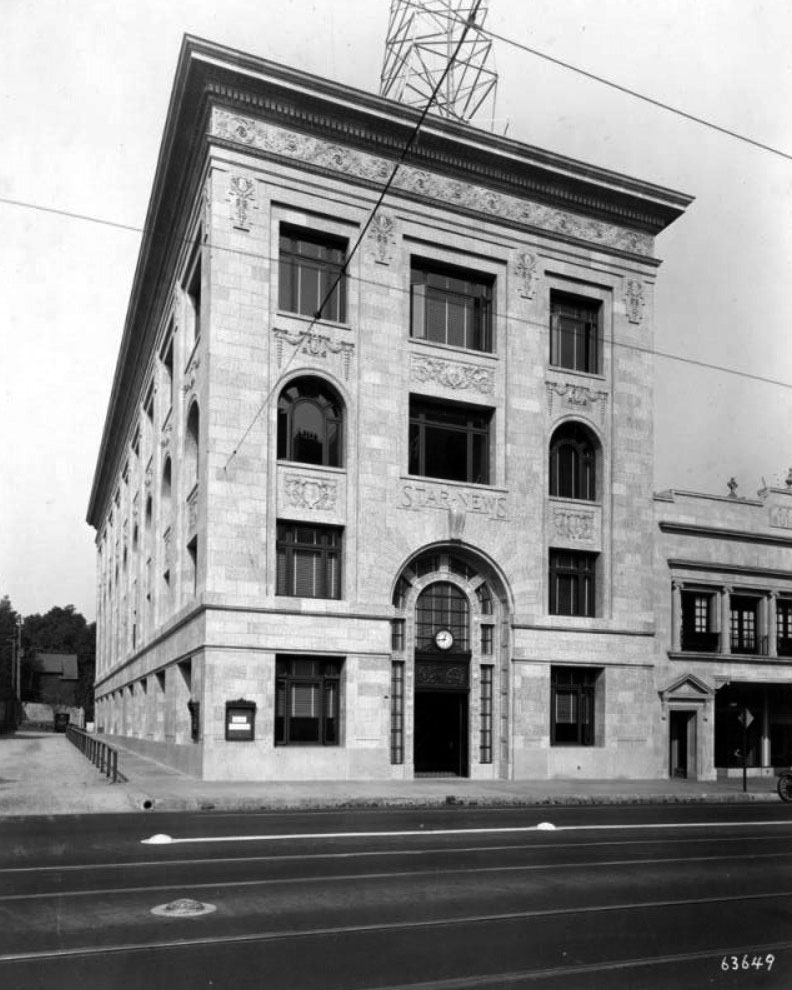 |
|
| (1925)* – View showing the recently completed Star-News Building located on the northeast corner of E. Colorado Blvd and N. Oakland Ave. There is a base of polished Original Raymond Granite with deep sills at the window openings. Architect: Joseph J. Blick. General contractors: W.A. Taylor & Sons. |
Historical Notes The Pasadena Star-News building was designed by Joseph Blick in 1924 in a Beaux-Arts style and completed in 1925. First published in 1884, the Pasadena Star-News moved into the building in 1925 and stayed until the 1990s. The building is now home to Technique at Le Cordon Bleu College of Culinary Arts and 24 Hour Fitness. Editors in the historical Star-News Building included Ed Essertier, Charles Cherniss, Bill Winter, Larry Wilson, and Frank Girardot. Publishers after Bernard J. Ridder included Bill Applebee. ^ |
 |
|
| (1927)*^* – View looking north on Oakland Avenue toward E. Colorado where the 4-story Star-News Building is seen on the NE corner. Note the ornate streetlights. |
Historical Notes The building has also played a role in the history of radio in Southern California, once hosting a pair of radio towers that broadcast Star-News programming under the call sign KPSN. The first radio broadcast of the Rose Parade aired on KPSN in 1926, and famed underground FM station KPPC also used the towers to transmit their signal from their studios in the basement of the adjacent Pasadena Presbyterian Church. ^ |
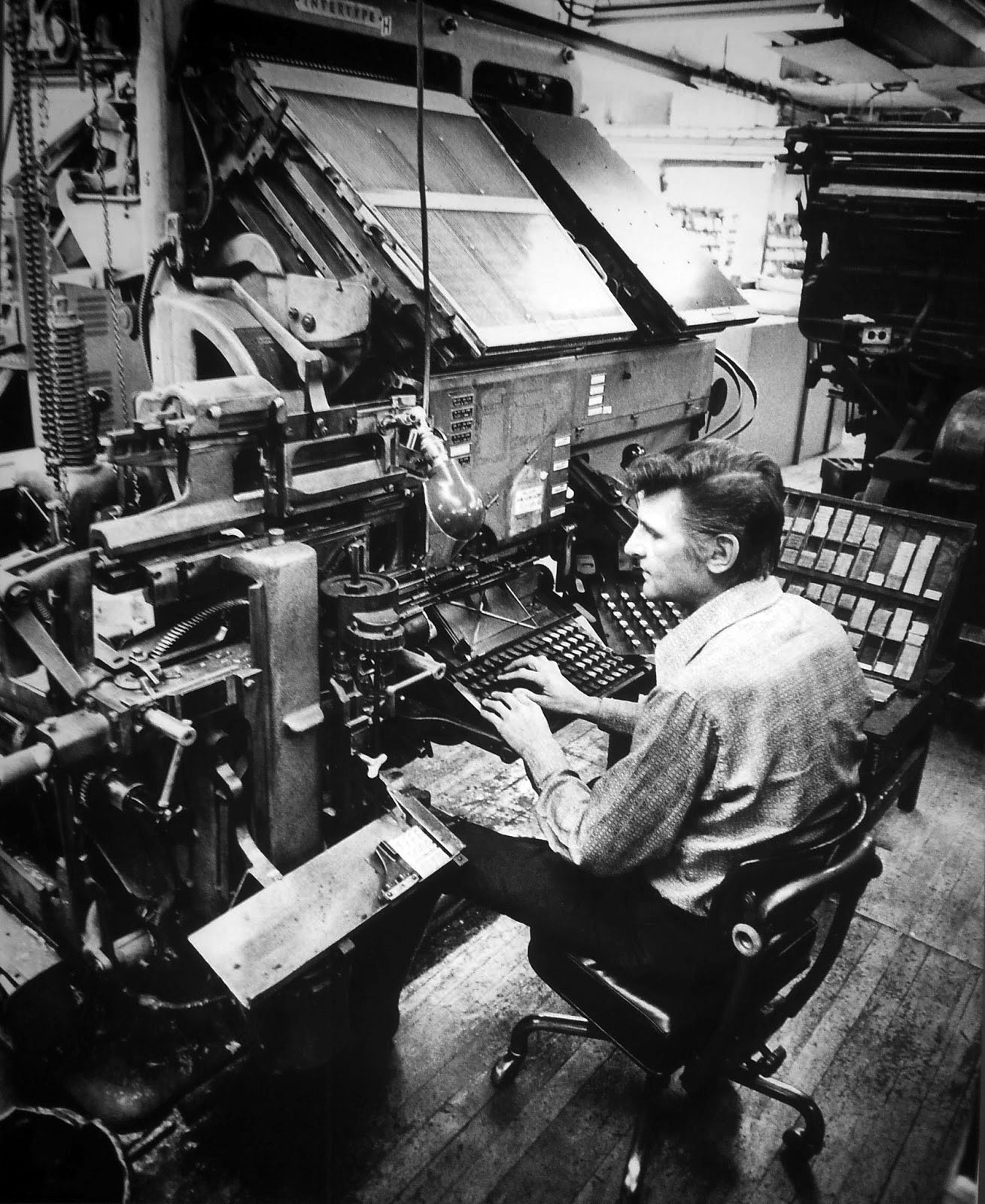 |
(1973)*# - Don Phillips operates a Linotype machine in the basement of the Pasadena Star-News Building at 525 E. Colorado Blvd. |
|
Historical Notes For decades just about every newspaper, magazine, publishing house and printing firm in the western world used Linotype machines, invented in 1884 by German watchmaker Ottmar Mergenthaler. Every time an operator touched a key on the typewriter-style keyboard, a matrix with the corresponding indented letter would drop into an assembler. When the matrices for an entire line were assembled, the line was automatically justified and molten metal cast "slugs" would be organized line by line into columns and pages for the purposes of printing. This could be done at a rate of 1,000 words per hour or 14 lines per minute. Thomas Edison called the Linotype machine the eighth wonder of the world because it revolutionized the printing industry. Prior to Linotype there was moveable type, invented by Johannes Gutenberg in 1436, that created a sea change in western civilization. Even as late as the 1930s moveable type was still in use at some newspapers where type was still being set by hand, one painstaking letter and punctuation mark at a time. These newspapers were limited to a maximum of eight pages -- the number of pages that could be typeset at a snail's pace in a day's time. By 2000 printing technology changed again, switching from mechanical hardware to digital software.* |
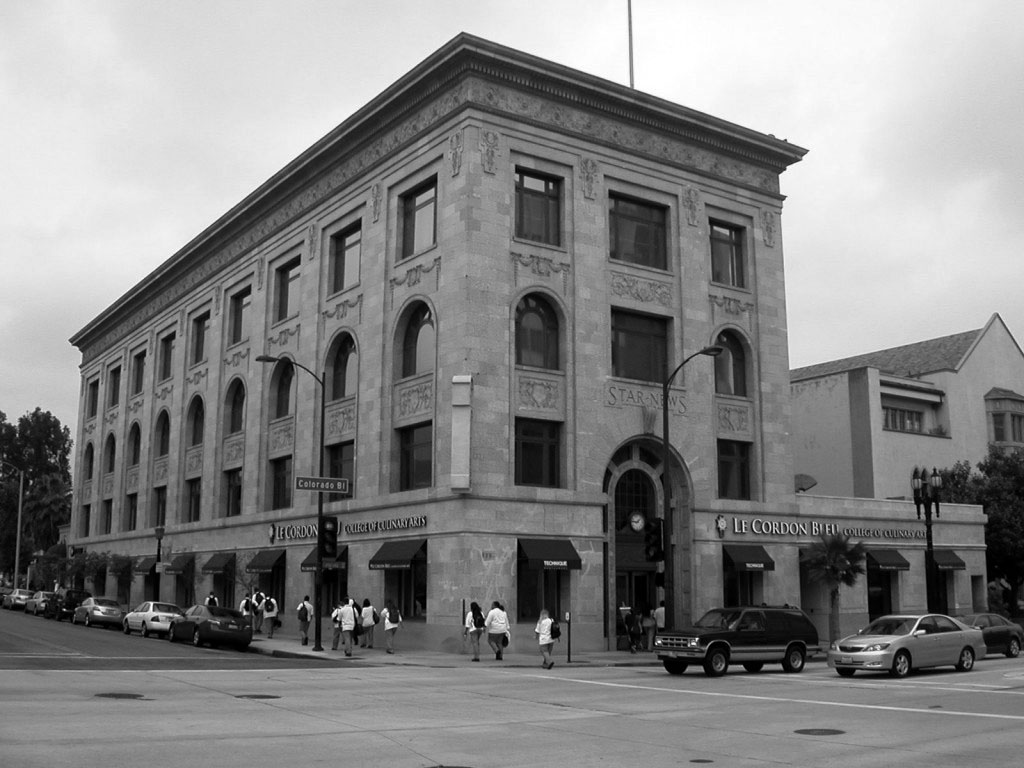 |
|
| (2011)#* – A group of people walk by the Star-News Building. The Le Cordon Bleu College of Culinary Arts, Technique Restaurant, 24 Hour Fitness, and medical offices occupy the building. Click HERE to see contemporary view. |
Historical Notes Ridder Newspapers bought the Star-News in 1956 and Bernard J. Ridder took over as publisher. Ridder merged with Knight to form Knight Ridder in 1974. The paper was sold off in 1989 to a company owned by William Dean Singleton; the Thomson Corporation bought majority control of the paper a year later. Thomson sold the Star-News to Singleton's MediaNews Group in 1996, which went on to become part of the Los Angeles Newspaper Group.*^ The newspaper also publishes the Rose Magazine which provide coverage of the Tournament of Roses Parade and the Rose Bowl Game. |
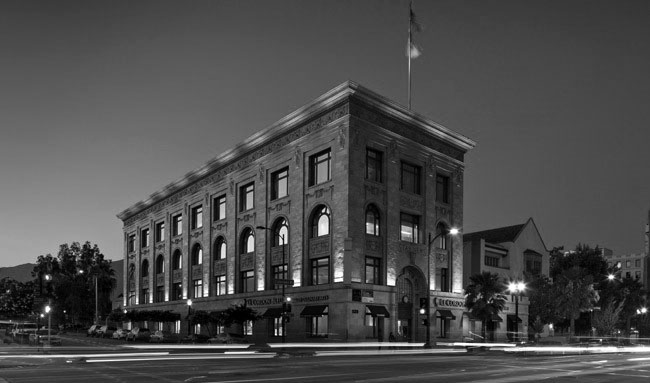 |
|
| (ca. 2018)* - Dusk view of the Star-News Building all lit up. Photo courtesy of Greenbridge Corp. |
Historical Notes The 4-story Beaux-Arts style building has a Penthouse. It also two levels below grade. The Star-News Building is listed in the National Register of Historic Places. |
* * * * * |
Pasadena Athletic Club
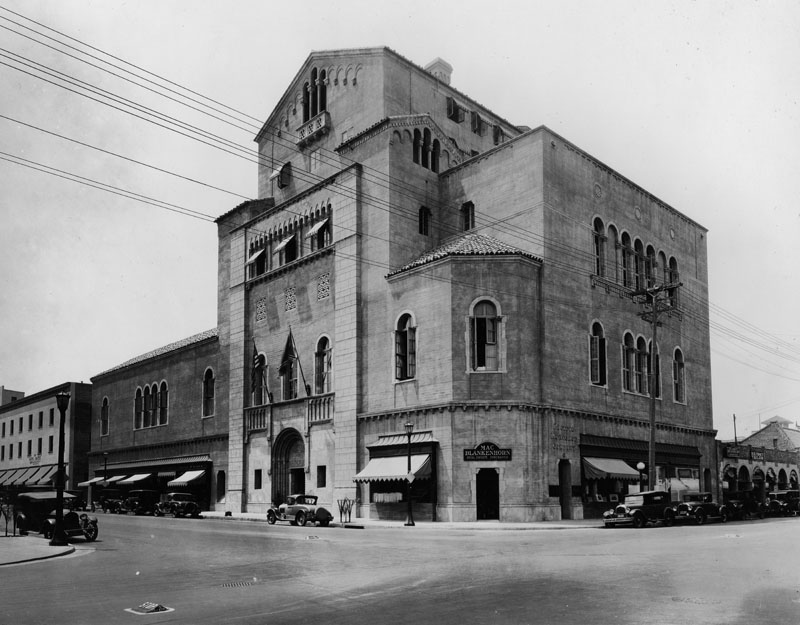 |
|
| (1927)* - Exterior view of the Athletic Club located in Pasadena. Several storefronts can be seen on both sides of the building. |
Historical Notes The Pasadena Athletic Club was located at 425 E. Green Street. The building was torn down in 1977 to make way for the Plaza Pasadena Mall. |
* * * * * |
Pasadena Public Library
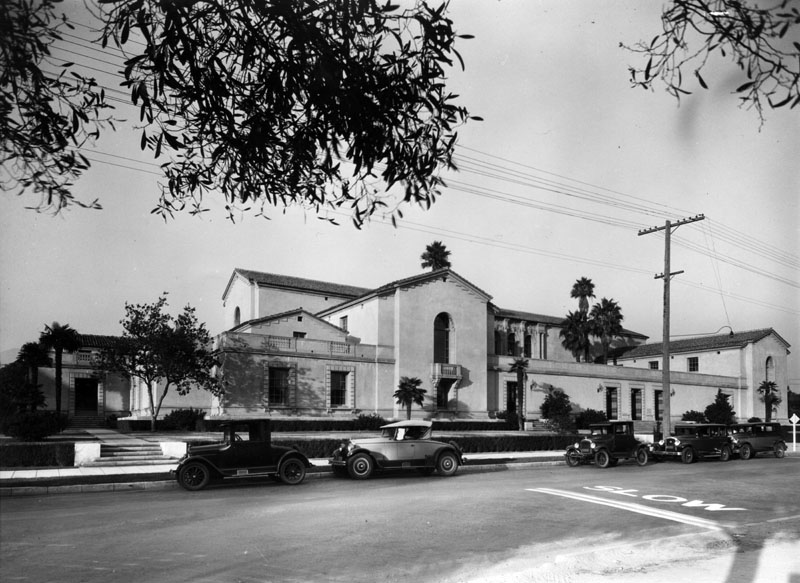 |
|
| (ca. 1927)* - Exterior view of the Pasadena Public Library, located at 285 E. Walnut Street in the Civic Center. View shows several automobiles parked along Walnut Street, where the front of the building is facing south on Garfield Avenue. |
Historical Notes The library was designed by architects Myron Hunt and H. C. Chambers in the Spanish Colonial Revival style and was built between 1925-27. Construction began May 19, 1925 . This is why the year 1925 is carved in Roman numerals over the front entrance of the building after "Public Library of the City of Pasadena." The Central Library was dedicated on Lincoln's birthday (February 12), 1927, and was the first building completed of the new Civic Center Plan. * This was Pasadena's 3rd Central Library Building. Click HERE to see Pasadena's 2nd Public Library Building. |
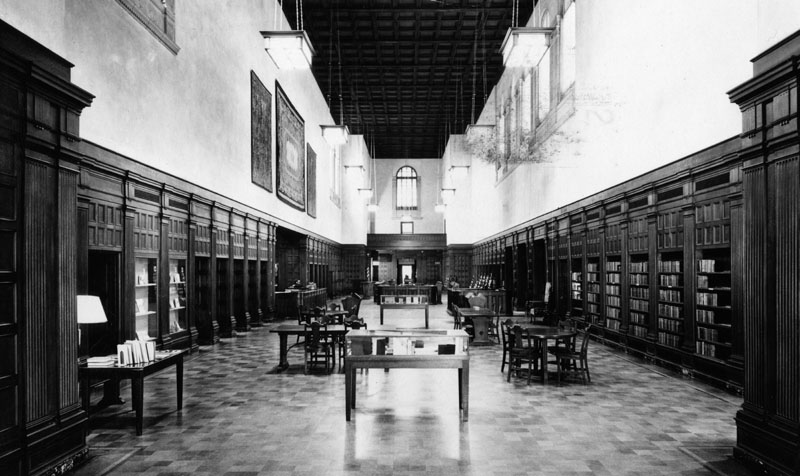 |
|
| (1927)* - Postcard view of the interior of the Pasadena Public Library. Writing on postcard describes view as the "main hall of the Pasadena Public Library, which has remained essentially the same since its construction". |
Historical Notes In the original plans for Central Library, Myron Hunt designed a four-level bookstack area, which could someday be finished to accommodate a growing collection. When this building was originally opened in 1927, only two levels were completed, the main level (with an immense open space above where more bookstacks could one day go) and one below at the basement level. By the 1980’s, the Library’s collection had grown to the point where it was necessary to complete Myron Hunt's visionary plan for a larger capacity bookstack.* |
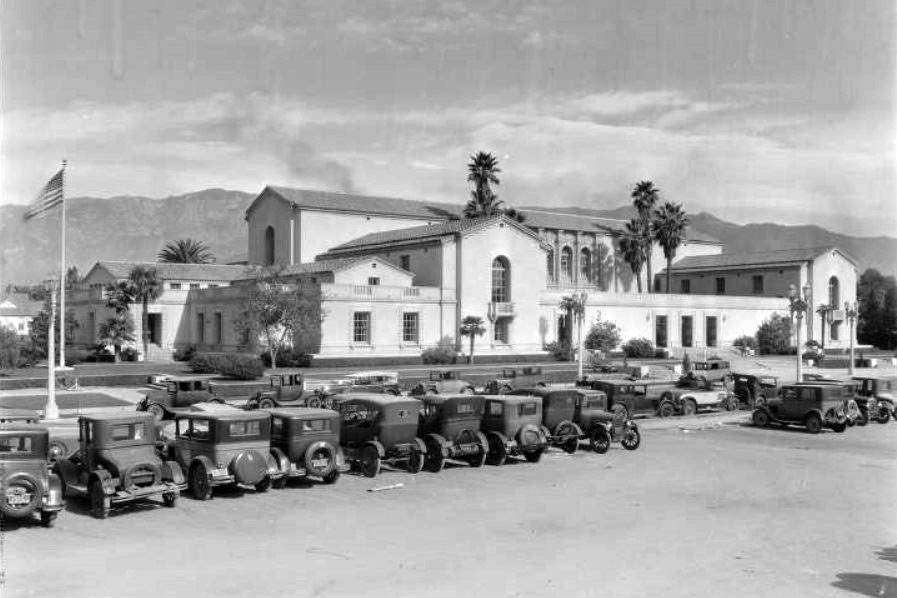 |
|
| (1930)#* - Street view of the Pasadena Public Library at 285 East Walnut, taken from the parking lot across the street. Automobiles line both the street and the parking lot. |
Historical Notes The Library, as well as the entire Civic Center, is listed on the National Register of Historic Places. Over the years, Central Library has been the location for some major motion pictures. * This was Pasadena's 3rd Central Library Building. Click HERE to see Pasadena's 2nd Public Library Building. |
* * * * * |
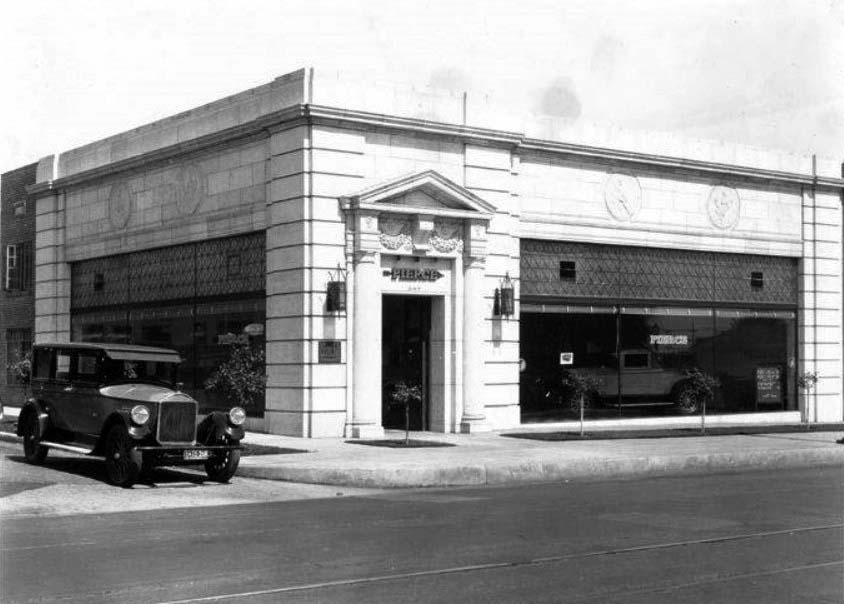 |
|
| (ca. 1927)** - View of the Hewson Motor Company showroom at 297 West Colorado. Architect: Frederick Kenedy Jr. |
Historical Notes The car at the curb with 1927 dealers' plates is most likely a 1927 Pierce-Arrow Model 80. In 1928 Studebaker took over Pierce-Arrow and in 1930 local Studebaker dealers Keller Brothers and Marcy Auto operated at this location. In 1935 is was called Earl Lundy Motor Company. Currenly (2014) it is Rusnak/Pasadena.** |
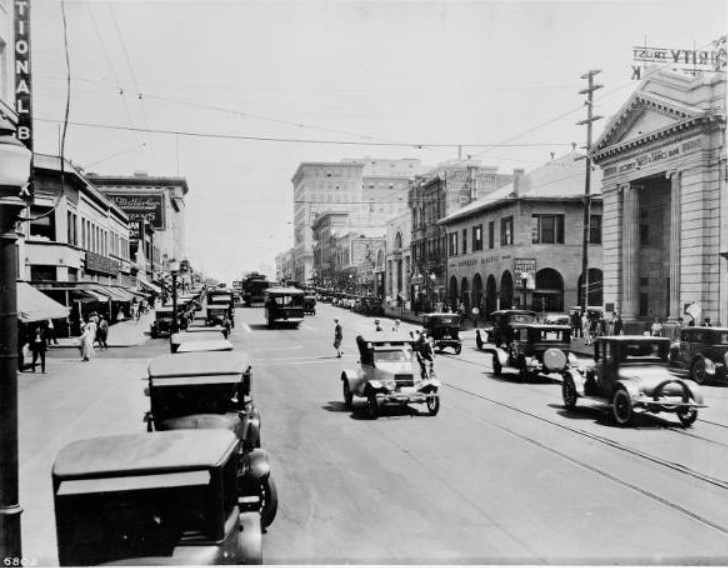 |
|
| (1927)#* - View looking east on Colorado Blvd. in Pasadena. The Security Pacific Bank can be seen on the right. |
Santa Fe Crossing - Colorado Blvd.
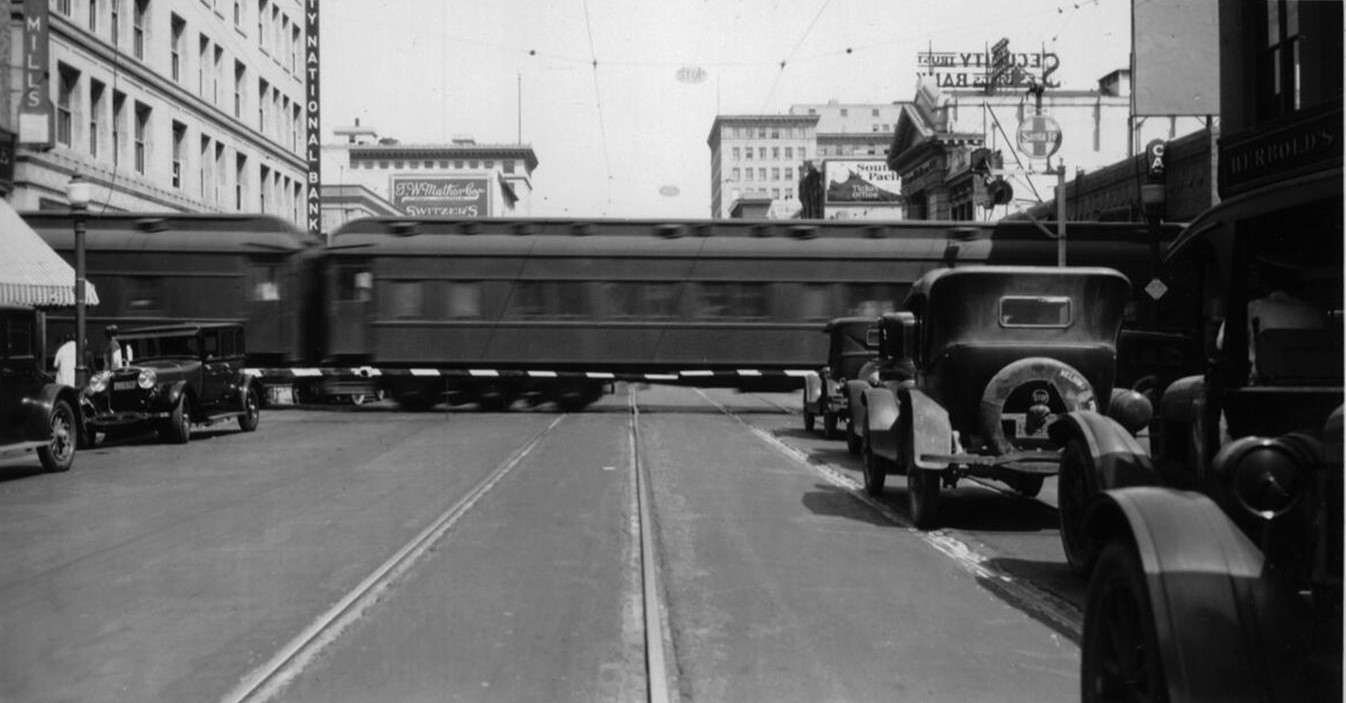 |
|
| (1928)*- Photo of Santa Fe passenger train inbound to LA crossing Colorado Blvd., between Raymond and Broadway [Arroyo Pkwy]. The view is to the east with the Security Pacific Bank building on the right behind the train. |
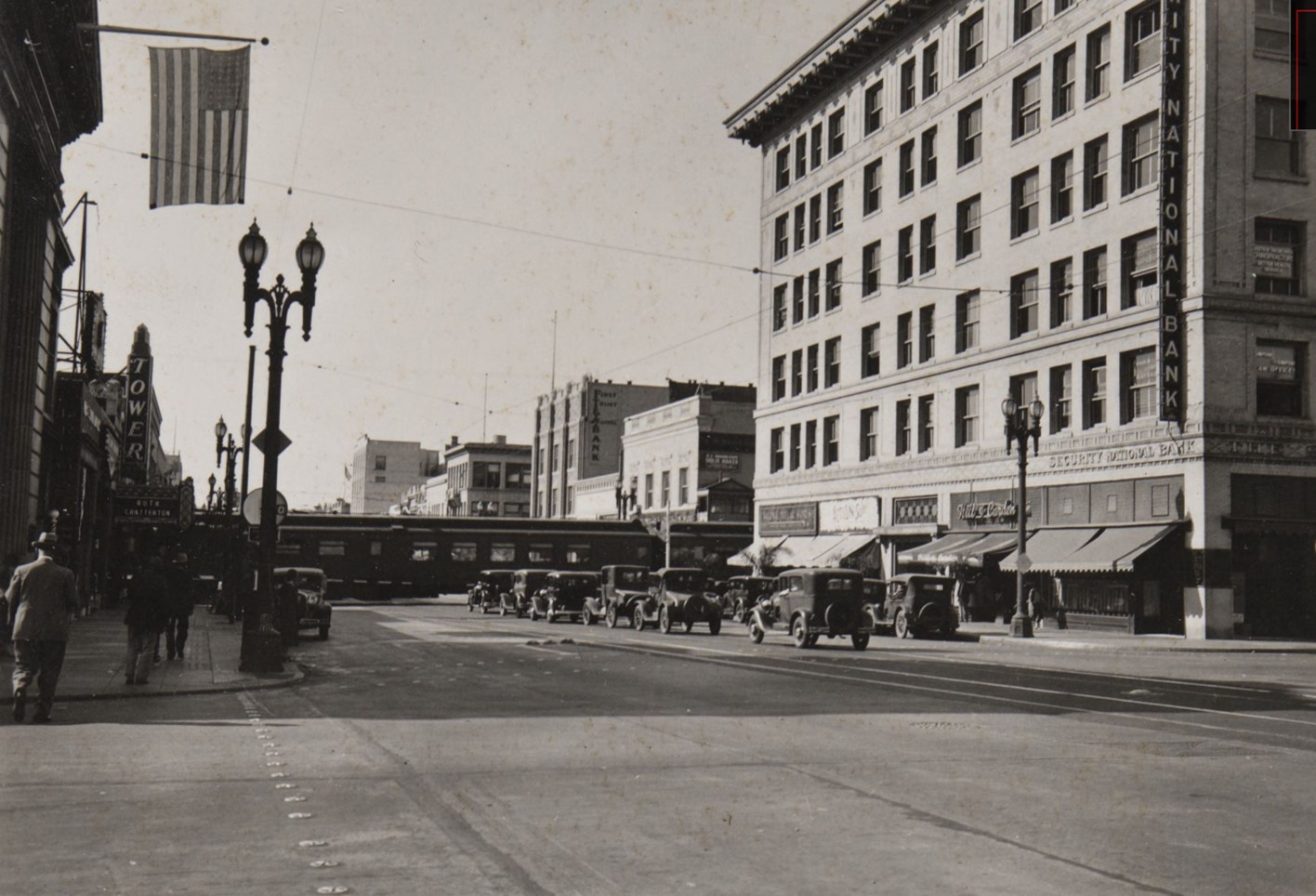 |
|
| (1932)* - Santa Fe train passing through Colorado Boulevard. View is looking west from Arroyo Pkwy. The Tower Theatre can be seen on the left. |
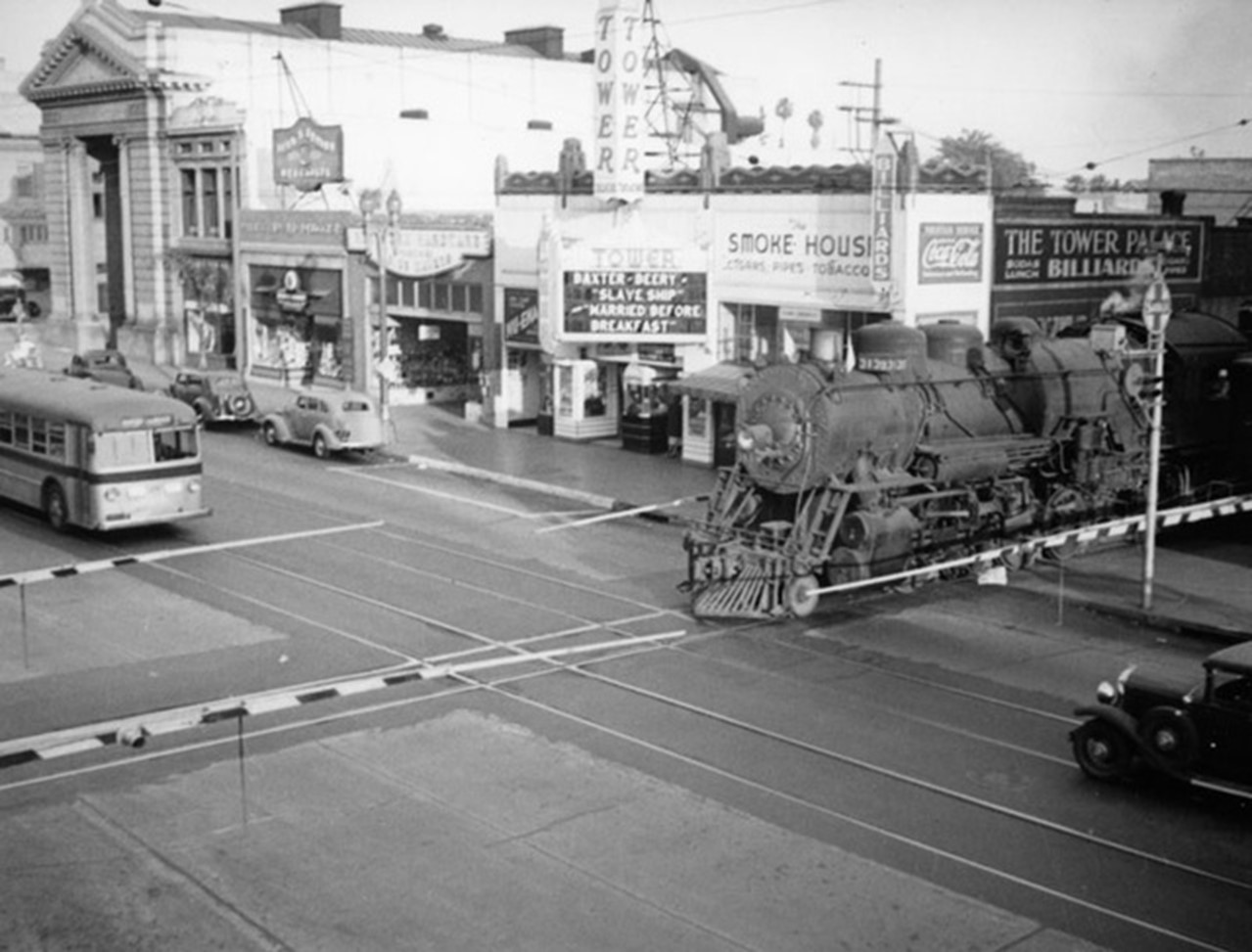 |
|
| (1937)* - Santa Fe train crossing Colorado Boulevard with the Tower Theater and Smoke House seen in the background. The Security Pacific Bank can also be seen on the left. |
Historical Notes The Tower Theatre was a movie palace located at 114 E. Colorado Blvd. in Pasadena, California. It opened on December 28, 1929 with the film "General Crack" starring John Barrymore. After closing as a movie theater in 1951, it had a brief stint as a church starting on October 4, 1952. However, by 1954 the Polk city directory listed the address as vacant, indicating the Tower Theatre had been demolished by that point. Today, there is just a parking lot on the site where the theater once stood. |
 |
|
| (ca. 1950)* – View looking east on Colorado Boulevard from just west of the Santa Fe crossing in Pasadena. PE Interurban 1125 is inbound to LA by way of the Oak Knoll line but is held up by the Santa Fe Chief passing in front. Note also the Tower Theater at right. Photo by Stan Kistler. Click HERE to see contemporary view. |
Historical Notes The Chief was one of the named passenger trains of the Atchison, Topeka and Santa Fe Railway. Its route ran from Chicago, Illinois to Los Angeles. The Chief was inaugurated as an all-Pullman limited train to supplement the road's California Limited, with a surcharge of $10.00 for an end-to-end trip. The heavyweight began its first run from both ends of the line, simultaneously, on November 14, 1926, scheduled 63 hours each way between Chicago and Los Angeles, five hours faster than the California Limited. |
Then and Now
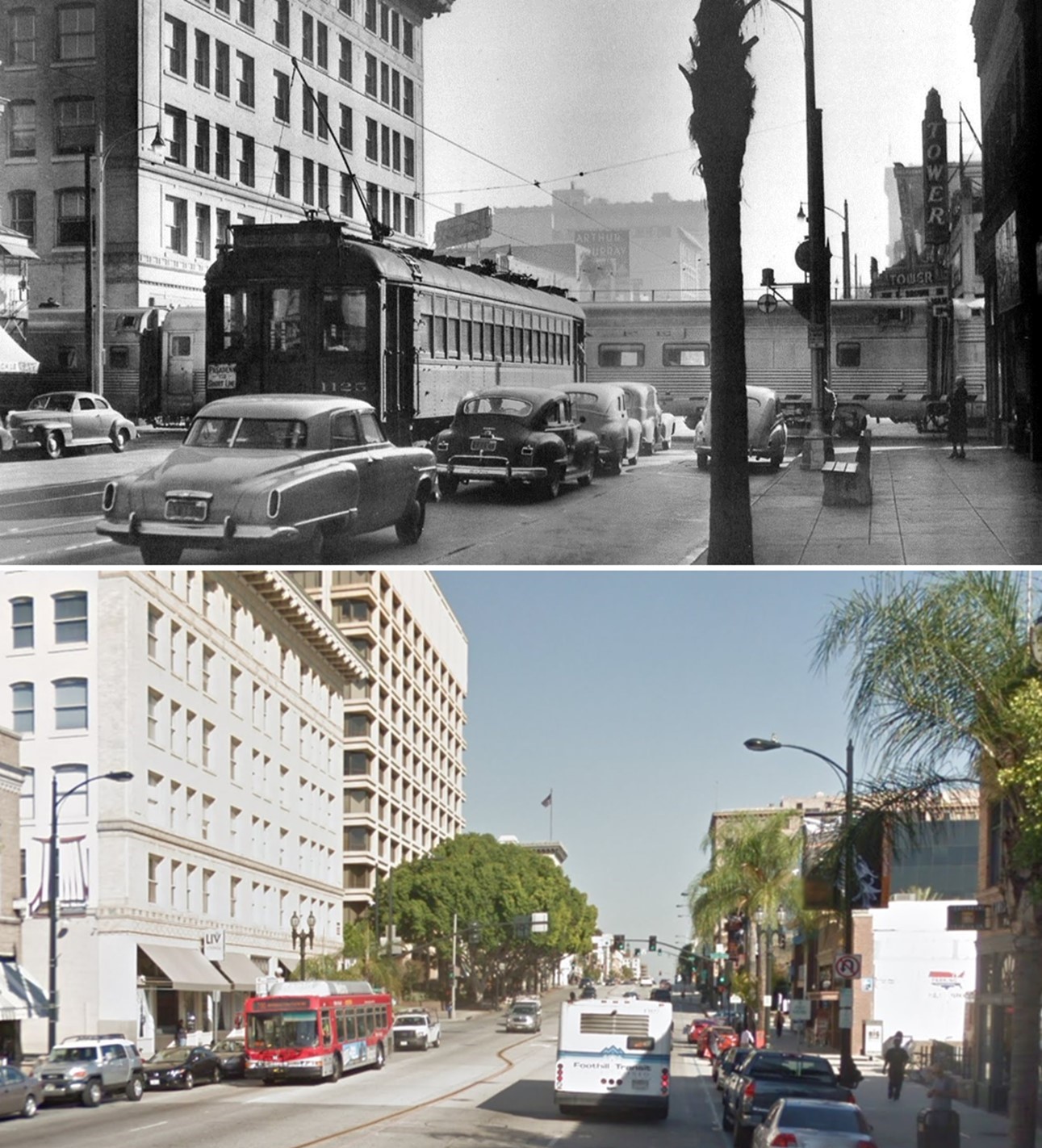 |
|
| Then and Now – View looking east on Colorado Boulevard from just west of the Santa Fe crossing in Pasadena. |
Historical Notes Click HERE to see more Early Views of the Santa Fe 'Chief'. |
* * * * * |
 |
|
| (ca. 1928)* – View looking west showing the Rose Parade processing down Colorado Boulevard; the cross-street is Catalina. Note onlookers perched on cornice of Bard's [later Colorado and Academy] Theater. Photo courtesy of Paul Ayers |
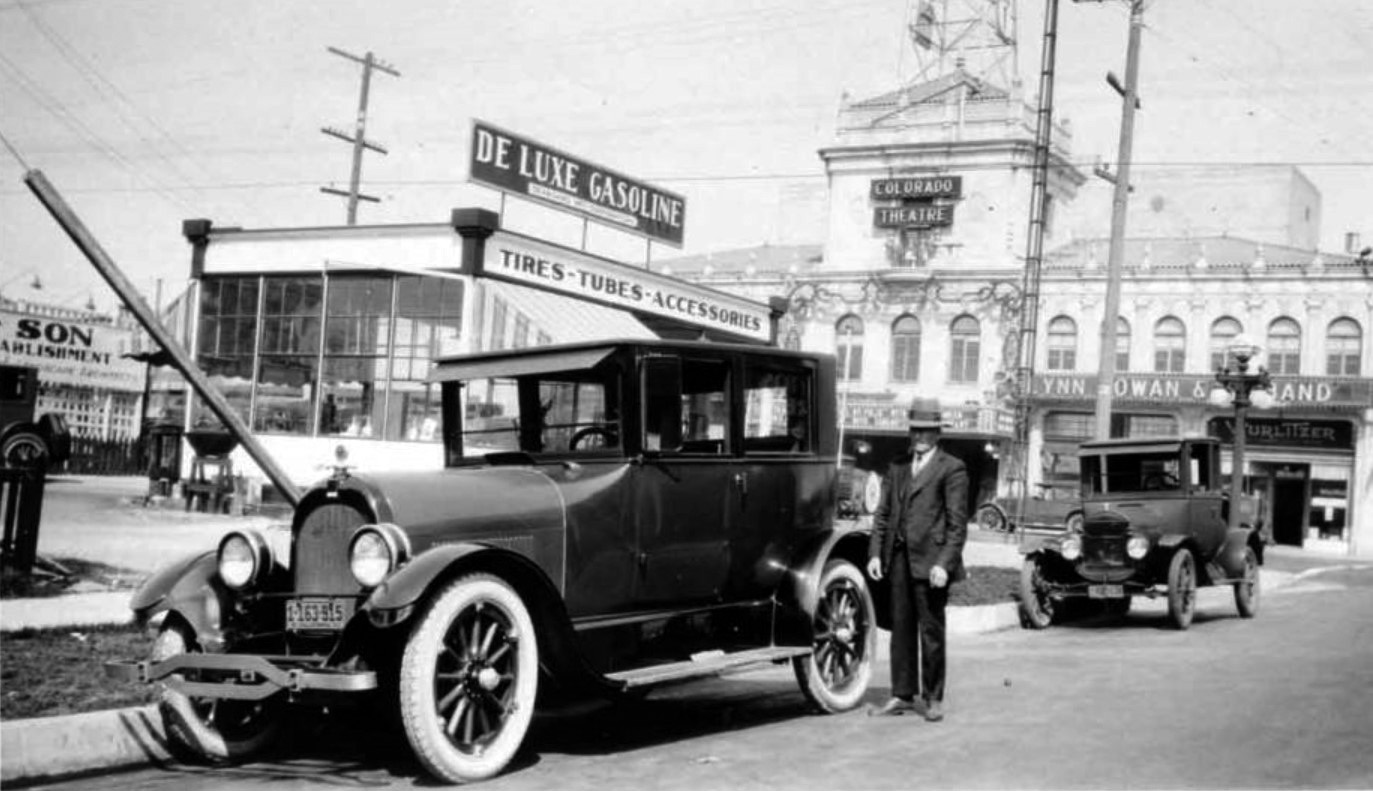 |
|
| (1927)*^* - View showing De Luxe Gasoline which was located at 1010 E. Colorado at Catalina on the southwest corner. Charles E. Fagan owned the service station. Featured in the background is the Colorado Theatre, now the Academy Theatre, and the Wurlitzer Rudolf Company, which specialized in musical instruments. |
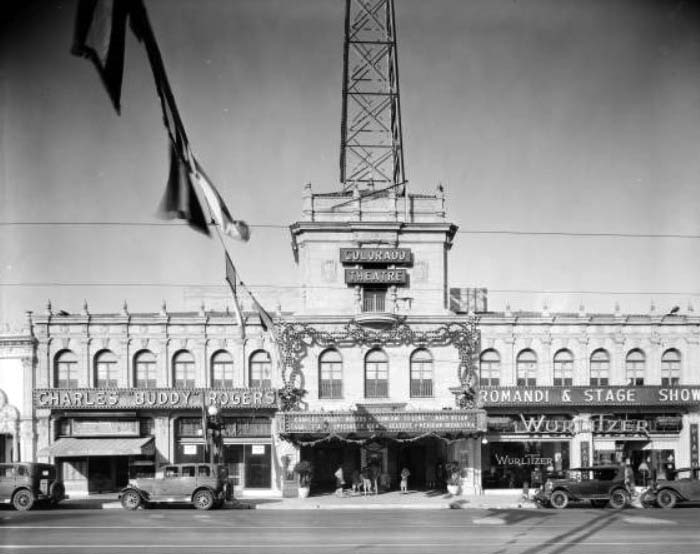 |
|
| (1928)** - Street view of the Colorado Theatre at 1003 East Colorado. The marquee reads "Charles "Buddy" Rogers in "Someone to love" with Mary Brian. Stage - F & M "Specialty Idea" - Celeste and Mexican Orchestra". Several adults and children stand outside the theater, near the ticket office. Adjacent businesses include the Albert Sheetz Mission Candies and Ice Cream and a Wurlitzer store. |
Historical Notes Opened in 1925 as Bard's Egyptian, the 1709-seat theater was designed by Lewis A. Smith. Later it was Bard's Colorado and by 1931 Fox West Coast had acquired the house and it became the Fox Colorado.*## |
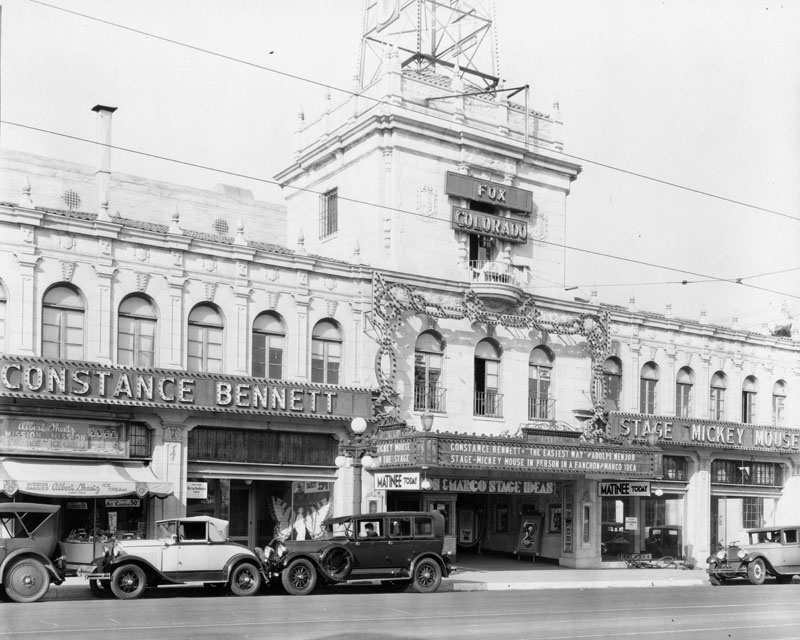 |
|
| (1931)* - Facade and marquee of the Colorado Theater, later the Academy Cinemas, located at 1003 E. Colorado Street. Parked cars are on the street. |
Historical Notes The theater got a moderne makeover in the 1940s and was renamed the Academy. In the 1980s it got turned into a 6-plex and is now operated by Regency Theatres.*## |
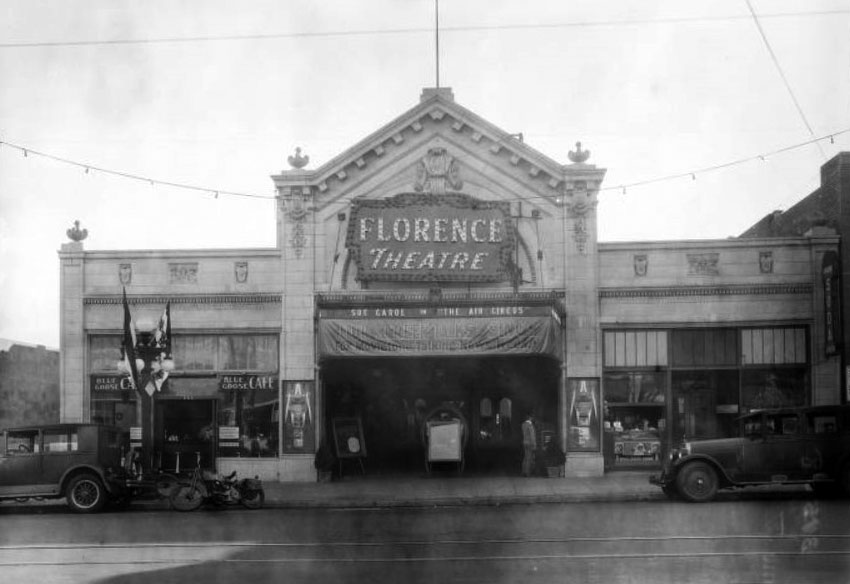 |
|
| (1928)#* - Street view of the Florence Theatre (later State Theatre) at 770 East Colorado. The marquee reads "Sue Carol in "The Air Circus", and a sign below the marquee reads "Our screen talks and sings. Fox Movietone Talking News Weekly". Adjacent businesses include the Blue Goose Cafe and a soda shop. |
Historical Notes Opened in 1918 as the Florence Theatre. This former Fox house closed and was later operated by Pussycat Theatres, in the 1970’s and 1980’s. It became an independent theatre, closing in 2000 and gutted afterward for a conversion to retail and office use.**^^ |
 |
|
| (Early 1900s)**^^ - Interior view of the Florence Theatre (later State Theatre) located at 770 East Colorado. |
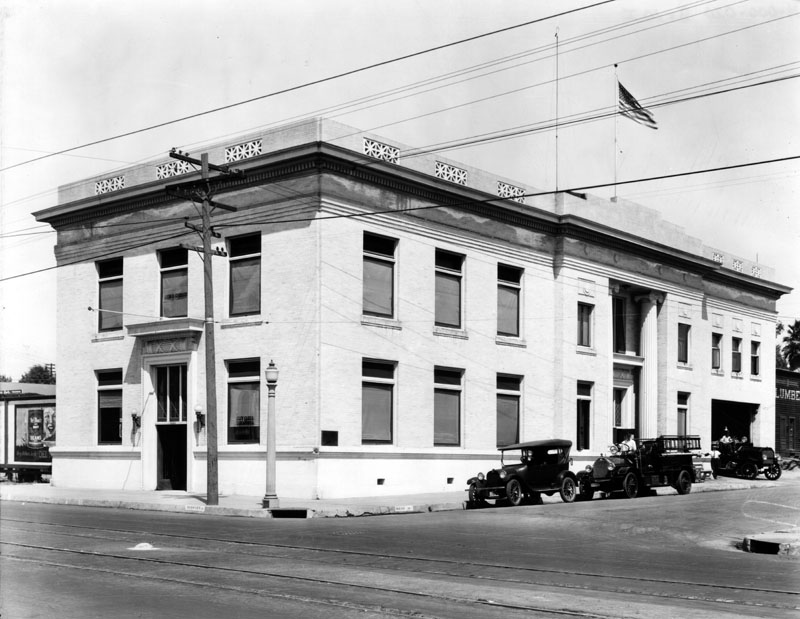 |
|
| (ca. 1928)* - This large building, located on the corner of Mission Street and Mound Avenue, houses the South Pasadena Council Chamber and City Clerk Treasurer, as well as South Pasadena Fire Department, Engine Company #81. The entrance to the City offices can be seen at the left of the building with an address of 1424 Mission Street; the fire department is located at the rear, at 817 Mound Ave. |
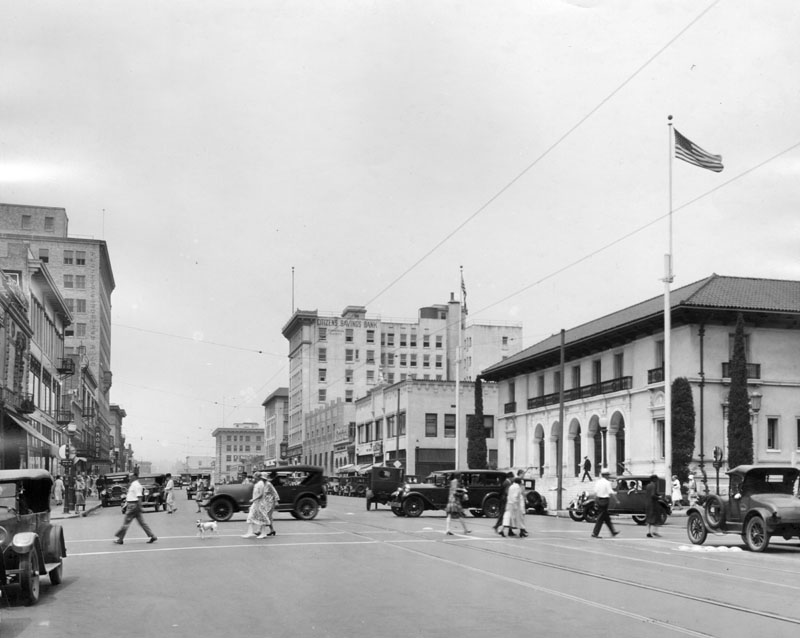 |
|
| (ca. 1928)* - View of Colorado Street and Garfield Avenue in Pasadena, facing west. The original Italian Renaissance Post Office is visible in the forefront on the right; formerly the only Post Office in Pasadena, it is now a branch. The main building was designed by Oscar Wenderoth and was built in 1913. Citizens Savings Bank can be seen farther back on the right, and across the street from it the Pacific Southwest Bldg. is on the left. Several automobiles and pedestrians, as well as a dog, can be seen crossing the street. |
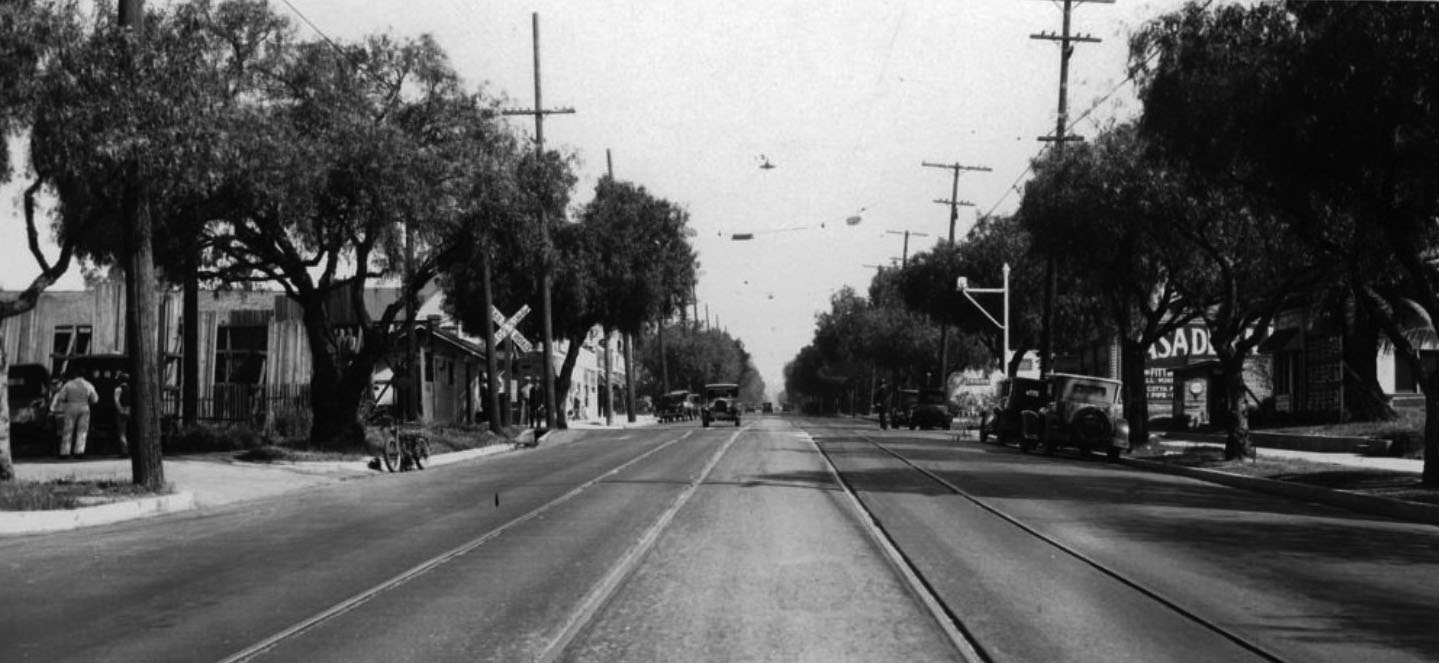 |
|
| (1928)^ – View looking north on Lake Avenue at the Santa Fe right-of-way. Today, this section of Lake Avenue crosses over the 210 Freeway. Click HERE for contemporary view. |
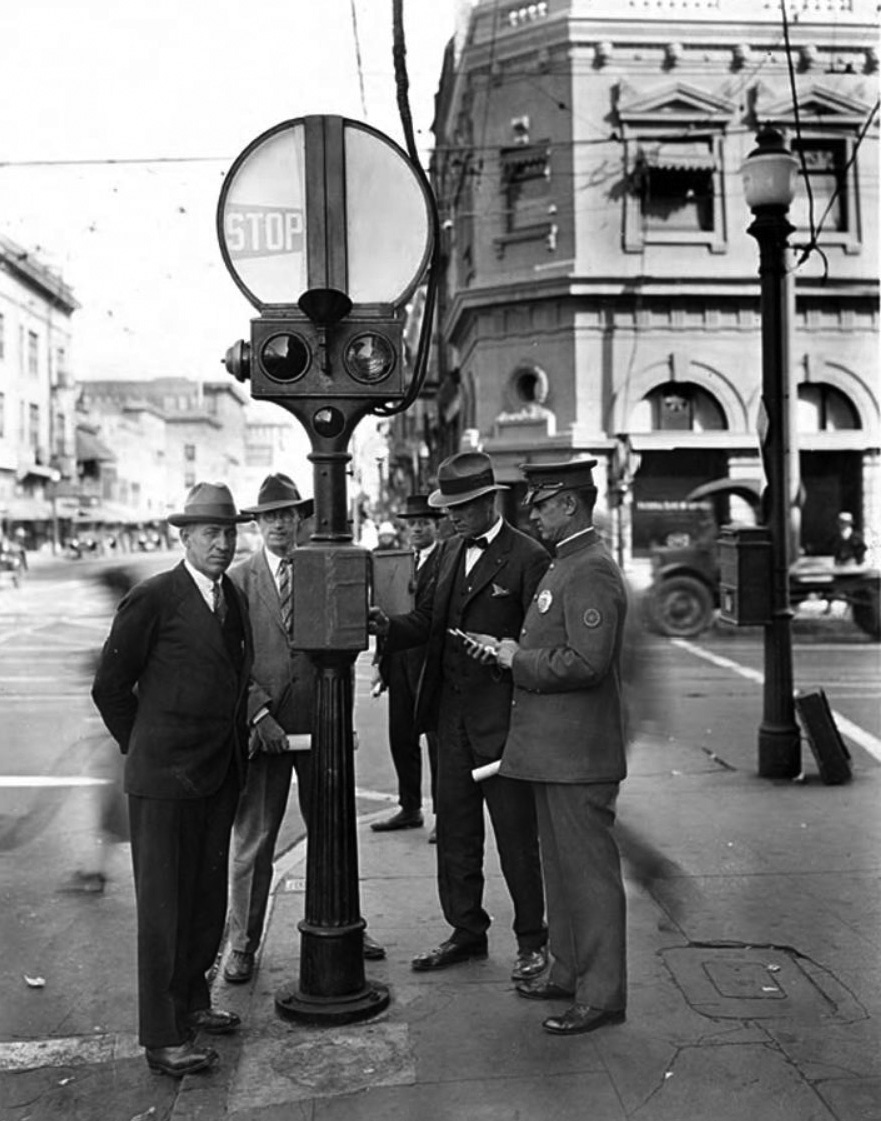 |
|
| (1928)** - View showing three men in suits and one police officer standing by a new traffic signal installation in Old Town Pasadena. |
Historical Notes The above photo was taken for the Pasadena Water and Power Department (then called the Power Department), most likely to record the installation of new traffic signals.** |
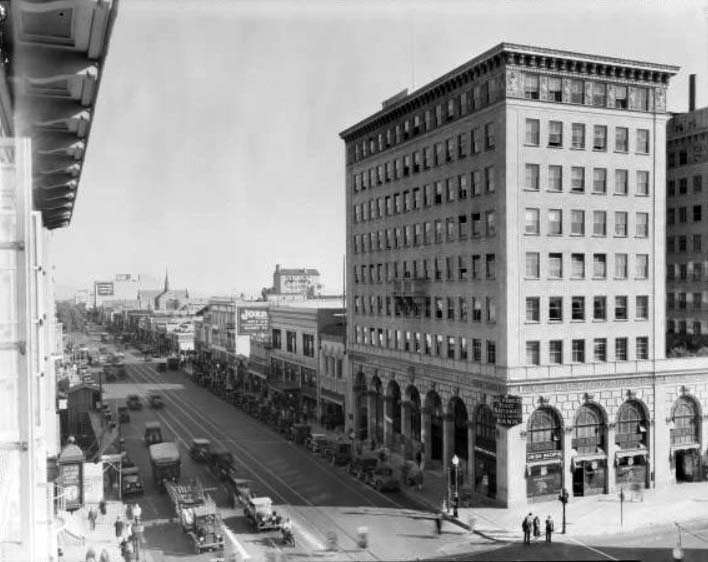 |
|
| (1928)**- Elevated view of East Colorado looking east from South Marengo, from the fourth floor of Mather's Department Store. The street below is busy with traffic and lined with parked automobiles. The Los Angeles First National Trust & Savings Bank is immediately across the street. Businesses visible in the distance include the Model Grocery Co. and the Pasadena Furniture Company. |
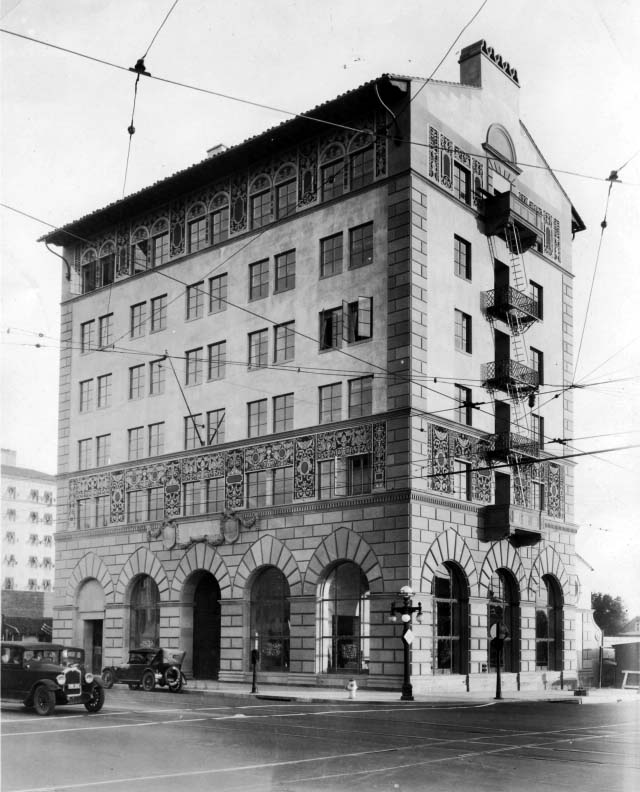 |
|
| (1928)^ - Photograph of the newly opened Oak Knoll Branch of the Los Angeles First National Trust and Savings Bank located on the southeast corner of East Colorado Street and Lake Avenue. Click HERE for contemporary view. |
Historical Notes "What Common Cents Did: Formal dedication of Oak Knoll branch of Los Angeles First National Trust & Savings Bank at Colorado and Lake, Pasadena, was held Thursday." -- Examiner clipping attached to verso, date January 8, 1928.^ |
 |
|
| (1928)**- Street view of the Constance Hotel at 940 East Colorado. The hotel is a multistory building decorated with red, white, and blue bunting. The retail space on the ground floor is occupied by the Pasadena Syndicate. There is a street lamp and a mailbox at the corner, and automobiles parked in front of the main entrance. |
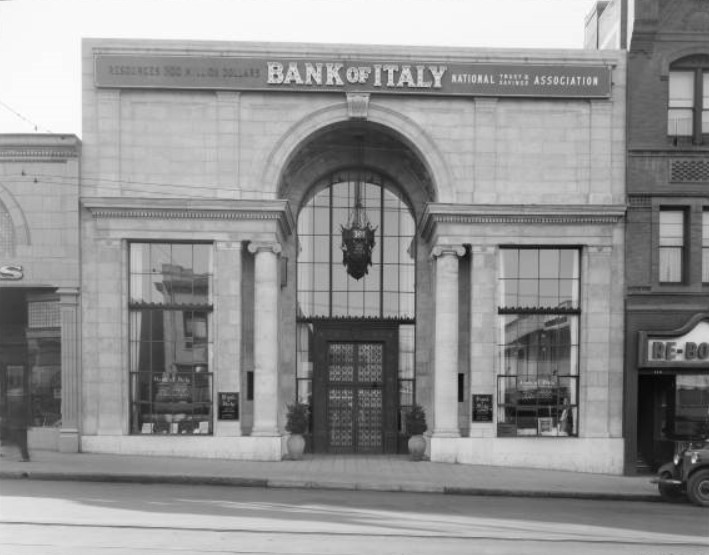 |
|
| (1928)** - View of the Bank of Italy at 160 East Colorado. Plaques on either side of the door identify this as the main office in Pasadena. |
Historical Notes The Bank of Italy was founded in San Francisco, in 1904 by Amadeo Giannini. It grew by a branch banking strategy to become the Bank of America, the world's largest commercial bank with 493 branches in California and assets of $5 billion in 1945. It was also the first state-wide branch banking system. The Bank of Italy merged with the smaller Bank of America, Los Angeles in the 1928. In 1930, Giannini changed the name "Bank of Italy" to "Bank of America." As Chairman of the new, larger Bank of America, Giannini expanded the bank throughout his tenure, which ended with his death in 1949.*^ |
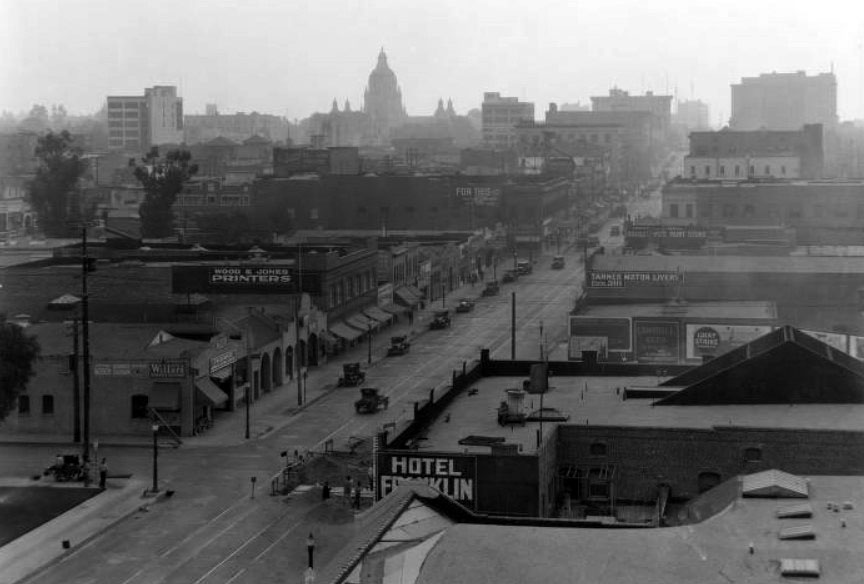 |
|
| (1928)#* - Elevated view of West Colorado looking East from the Orth Storage Building (about Pasadena Avenue). Colorado is lined with businesses, including Wood & Jones Printers, Hotel Franklin, and Tanner Motor Livery. There is construction on the street in the foreground, with numerous cars parked and in motion farther on. The recently completed (December 27, 1927) City Hall building can be seen in the background. |
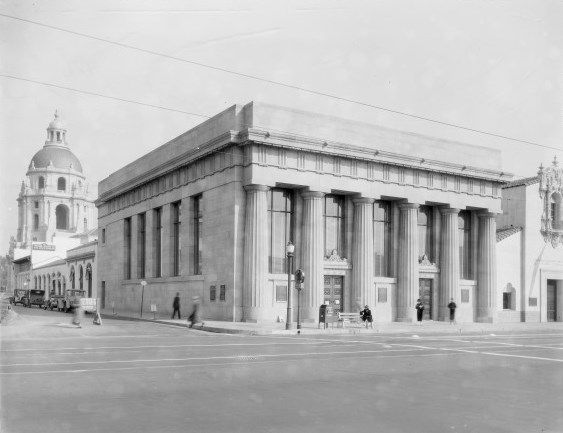 |
|
| (1928)*^* - View of First National Bank located at 301 East Colorado Boulevard with City Hall in the background. Six half columns/pilasters adorn the side of the building facing Colorado. |
Pasadena City Hall
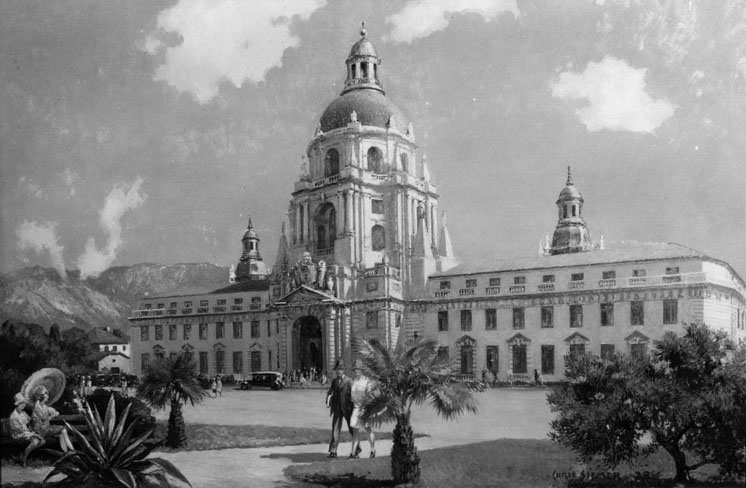 |
|
| (1927)* - Rendering showing Pasadena City Hall as it appeared shortly after it opened. Painting by Chris Siemer |
Historical Notes In 1923, the people of Pasadena approved a bond measure issuing $3.5 million towards the development of a civic center. City Hall was to be the central element of this center. The San Francisco architecture firm of Bakewell and Brown designed City Hall, which has elements of both Mediterranean Revival Style and Spanish Colonial Revival Style architecture.^ |
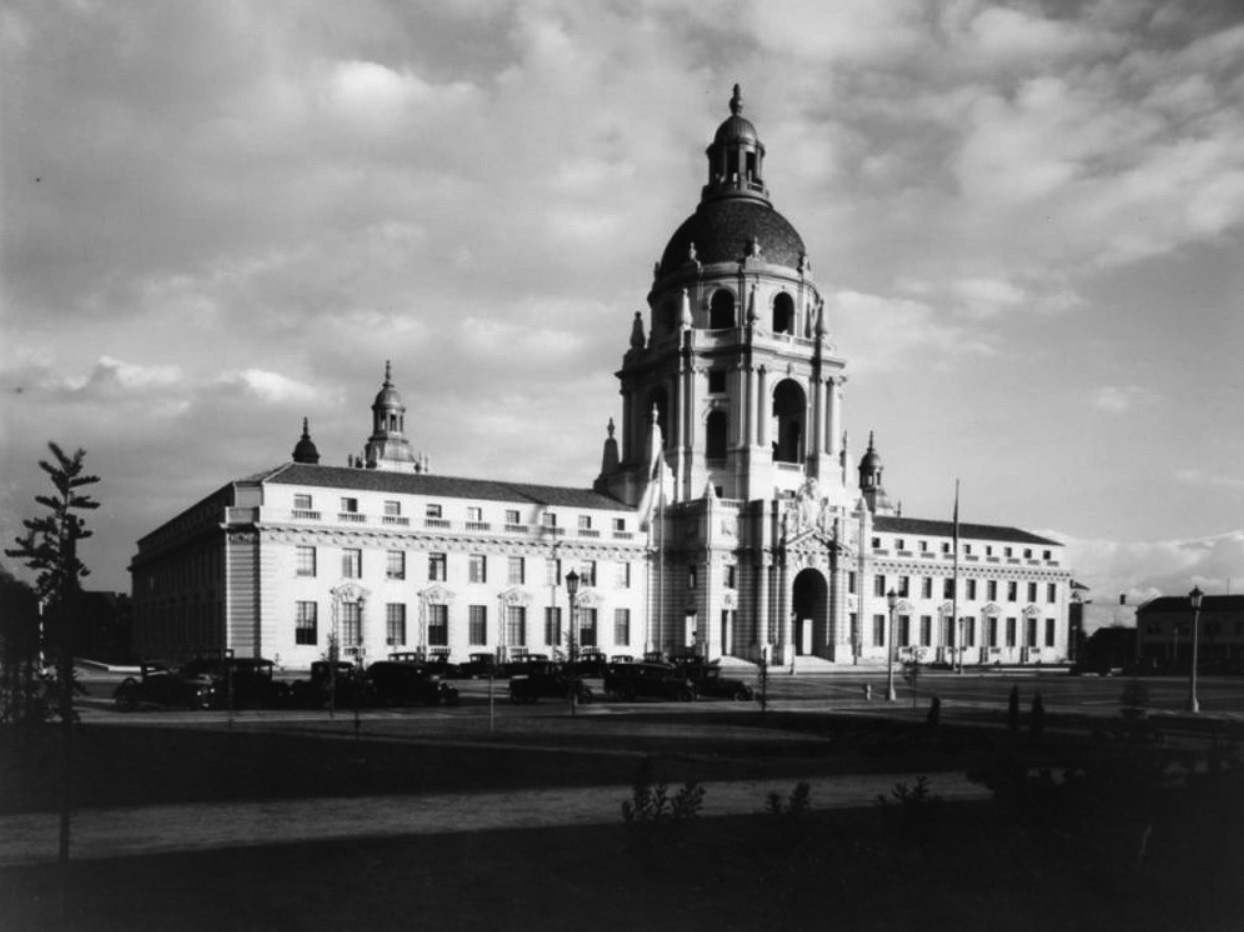 |
|
| (1930)* – View showing Pasadena's City Hall before it was surrounded by buildings. Note the architectural designs on the tower. Date built: 1925-27. Architects: Bakewell & Brown. Photo dated: January 17, 1929. |
Historical Notes Completed on December 27, 1927, the massive circular structure rises perpendicularly for six stories. The fifth story is 41 feet high and pierced with four huge round arches and four smaller ones. The next story, set back a little, is 30 feet high and is also pierced with arches. Above it rises the dome 26 feet high and 54 feet across. On top of the dome is the lantern, a column-supported cupola 41 feet high, surmounted by an urn and ball. The highest point is 206 feet above the ground.* |
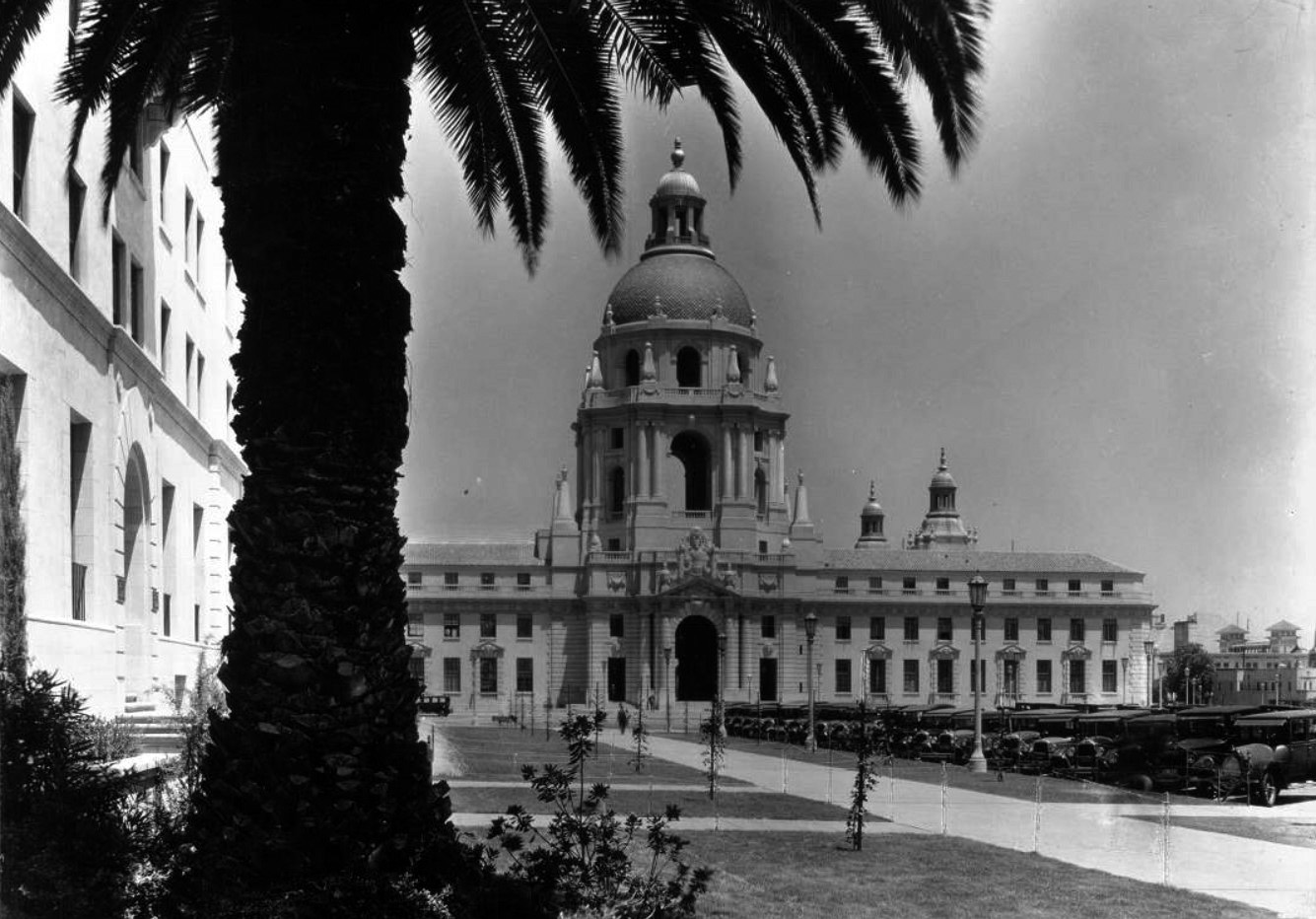 |
|
| (ca 1930)* - Not a parking space to be had in front of City Hall. |
Historical Notes For the final design, the San Francisco architectural firm of Bakewell and Brown turned to the style of 16th century Italian architect Andrea Palladio, who had studied and admired the Roman architect Vitruvius, as did the California mission-building padres. Palladio represented the simple, serene, classical style of the early Renaissance, in contrast to the Gothic style of medieval times and the rococo style of the later Renaissance. Three famous European domed structures show Palladio’s influence: the church of Santa Maria della Salute in Venice, the Hotel des Invalides in Paris and St. Paul’s Cathedral in London. Without being a direct imitation, Pasadena City Hall is related to them all.* |
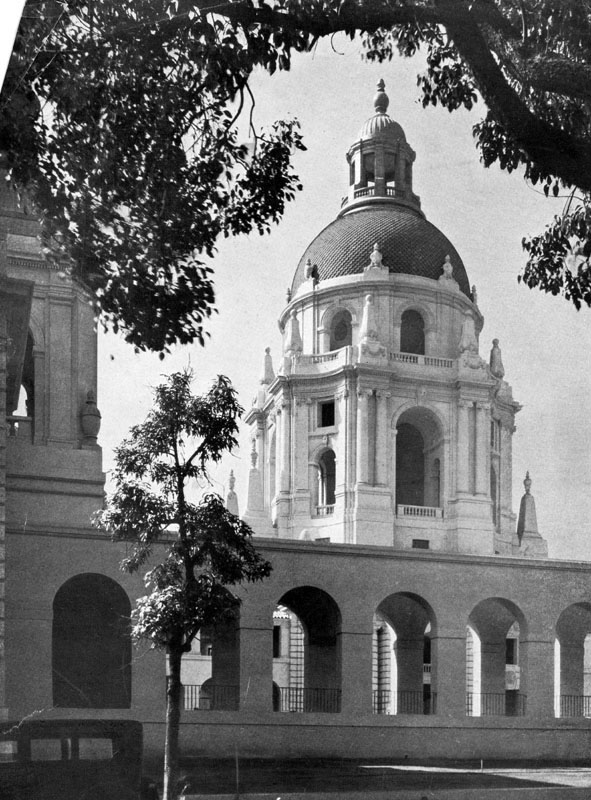 |
|
| (1928)* - Close-up view of the west facade showing the rotunda at Pasadena's City Hall, 100 North Garfield Avenue. |
Historical Notes The massive circular tower structure rises perpendicularly for six stories. The fifth story is 41 feet high and pierced with four huge, round arches and four smaller ones. The next story, set back a little, is 30 feet high and is also pierced with arches. Above rises the dome, 26 feet high and 54 feet across. On top of the dome is the lantern, a column-supported cupola 41 feet high, surmounted by an urn and ball. The highest point is 206 feet above the ground.* |
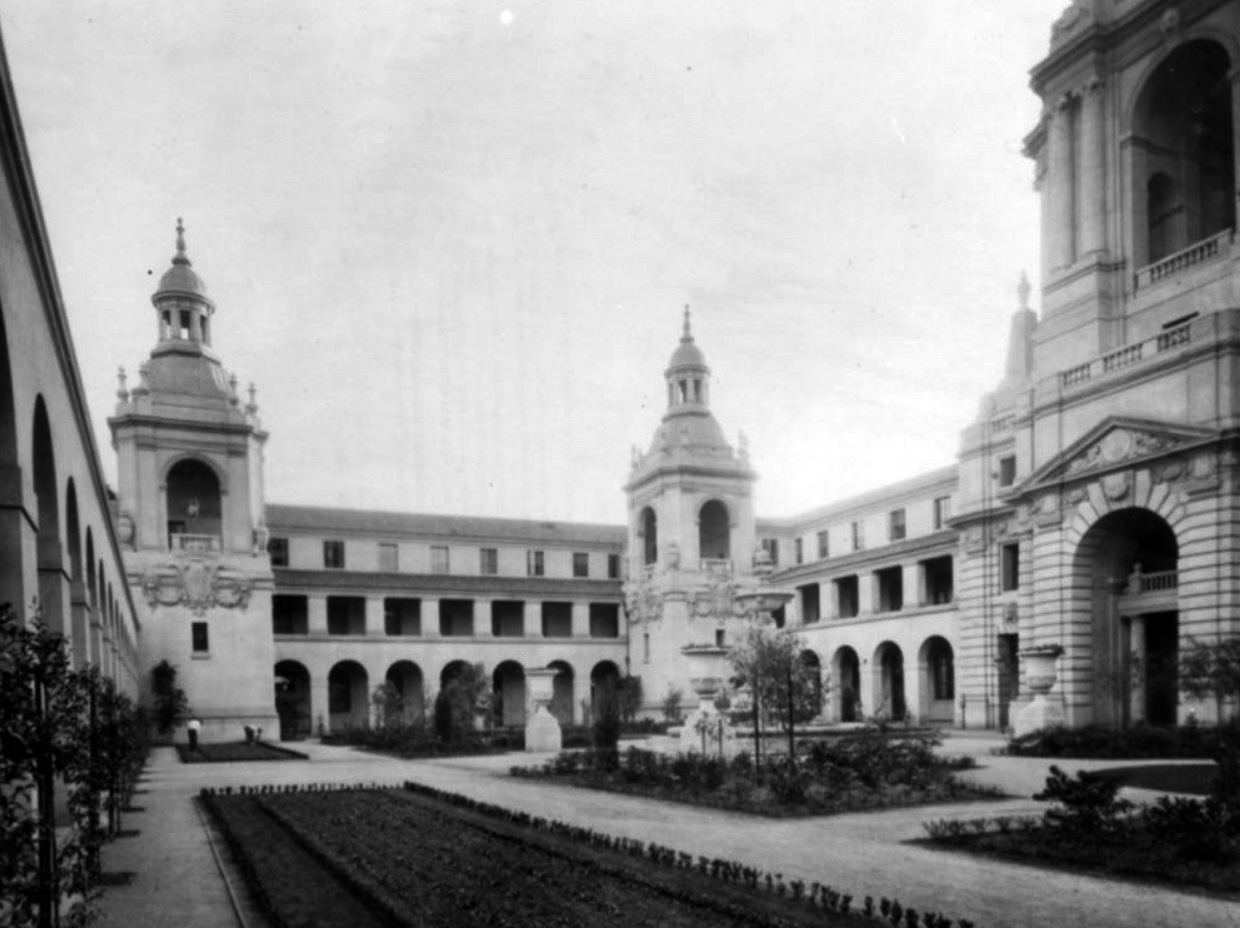 |
|
| (1930s)* - Overall view of the courtyard at Pasadena City Hall. Note the architectural designs on the two towers and the building. Architects: Bakewell & Brown. |
Historical Notes Pasadena City Hall has long been a favorite shooting location for filmmakers. The courtyard was used in the 1995 movie "A Walk in the Clouds" to portray a Napa Valley town square. It has also been used as an embassy in the "Mission: Impossible" television series, and a villa in Charlie Chaplin's Oscar-nominated 1940 film "The Great Dictator."^ |
 |
|
| (2020)^.^ - Pasadena City Hall courtyard. Photo courtesy Sonia Morin |
Historical Notes The courtyard has a strong Spanish Colonial atmosphere. The focal point is the cast stone Baroque fountain. 22.5 feet tall with a basin 25 feet in diameter. Paths of crushed granite define the flower beds and cloistered arches paved with red Padre tile surround the courtyard. California live oak trees provide shade for the azaleas, hydrangeas, rhododendron and beds of annuals that are planted on a rotational basis.* |
 |
|
| (1930)* - Scenic view of Pasadena City Hall and its surrounding area, with mountains in the background. Building on left of photo (past the tall pine tree) is the Y.W.C.A., located on the southeast corner of Marengo Avenue and Holly Street. It is a 3 story, plain, boxy building with long horizontal windows. Date built: 1920-1922. Designed by Julian Morgan in Mediterranean style. |
Historical Notes The way had been prepared in 1923, when the people of Pasadena passed a bond issue of $3.5 million to establish a civic center. The Chicago firm of Bennett, Parsons and Frost was commissioned to draw up a civic center plan. The planners established Garfield Avenue as an axis, on which City Hall was to be the central element, with the Pasadena Public Library to the north and the Pasadena Civic Auditorium to the south. Also included in the original design were the Pasadena Police Department, Pasadena Municipal Court, YMCA, YWCA, Southern California Gas Company and United States Post Office. Over the years the new police building and county court house have been added. The YMCA building is now Centennial Place, a single-room-occupancy residential complex, and the Southern California Gas Company building now serves as the city's Permit Center. The YWCA building is unoccupied because of seismic and other issues.^ |
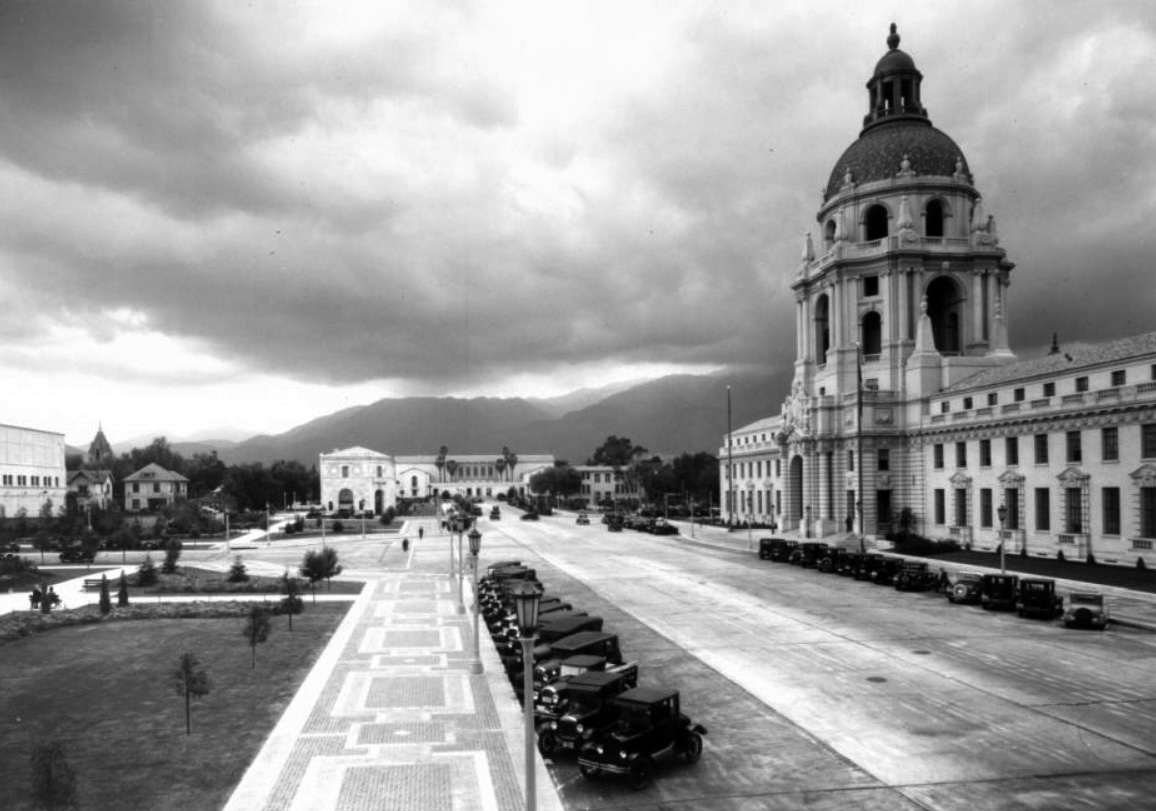 |
|
| (ca. 1936)^ - The Pasadena City Hall seen along with other buildings on the Civic Center. Photo by Dick Whittington |
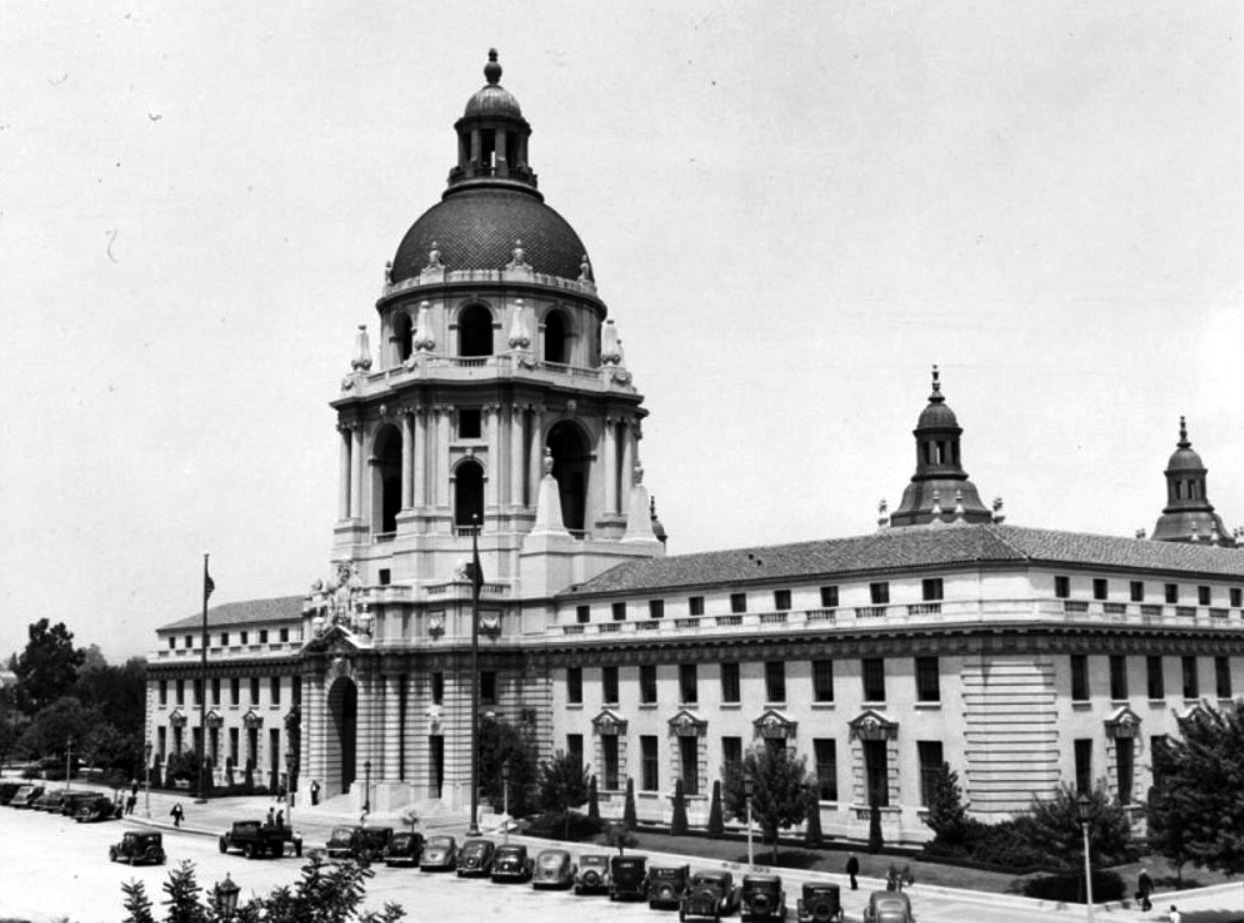 |
|
| (1937)* - Exterior view of Pasadena City Hall at 100 North Garfield Avenue, in Pasadena. Note the architectural designs on the rotunda and building. |
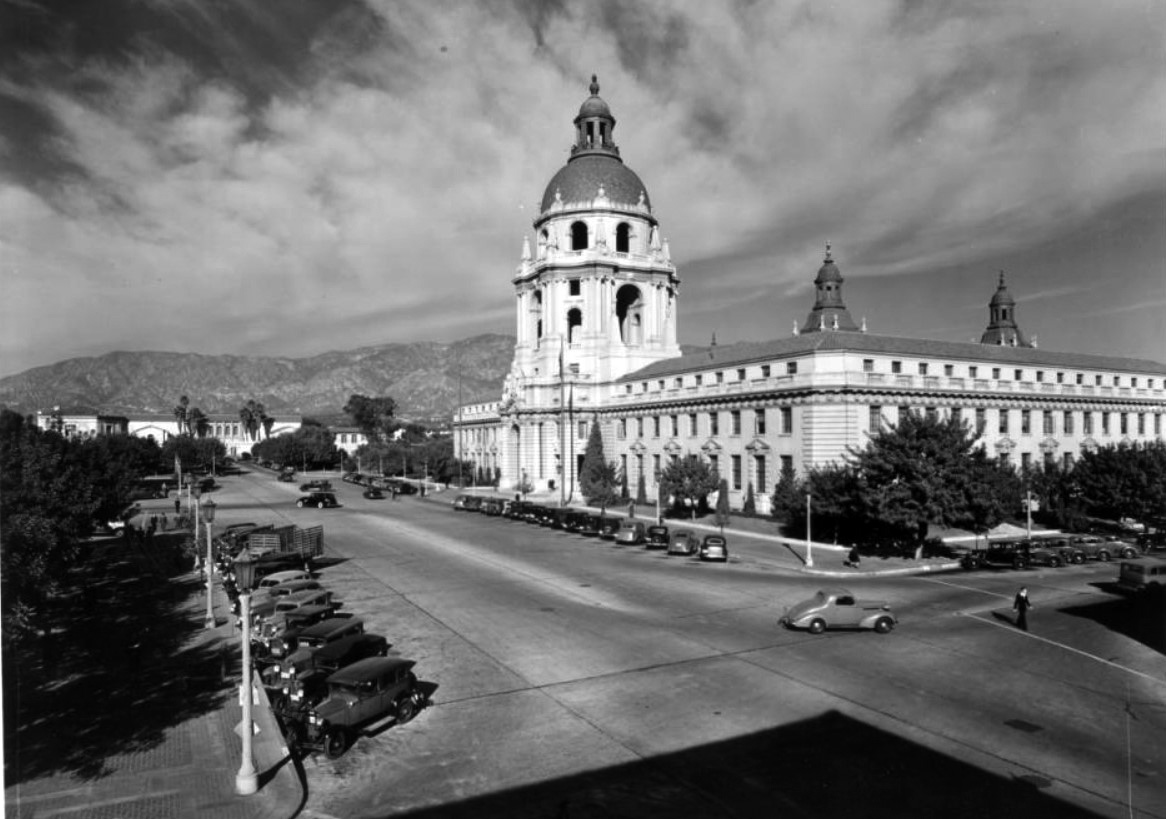 |
|
| (ca. 1938)^ - A corner view of the Pasadena City Hall with the mountains in the background. Photo by Dick Whittington |
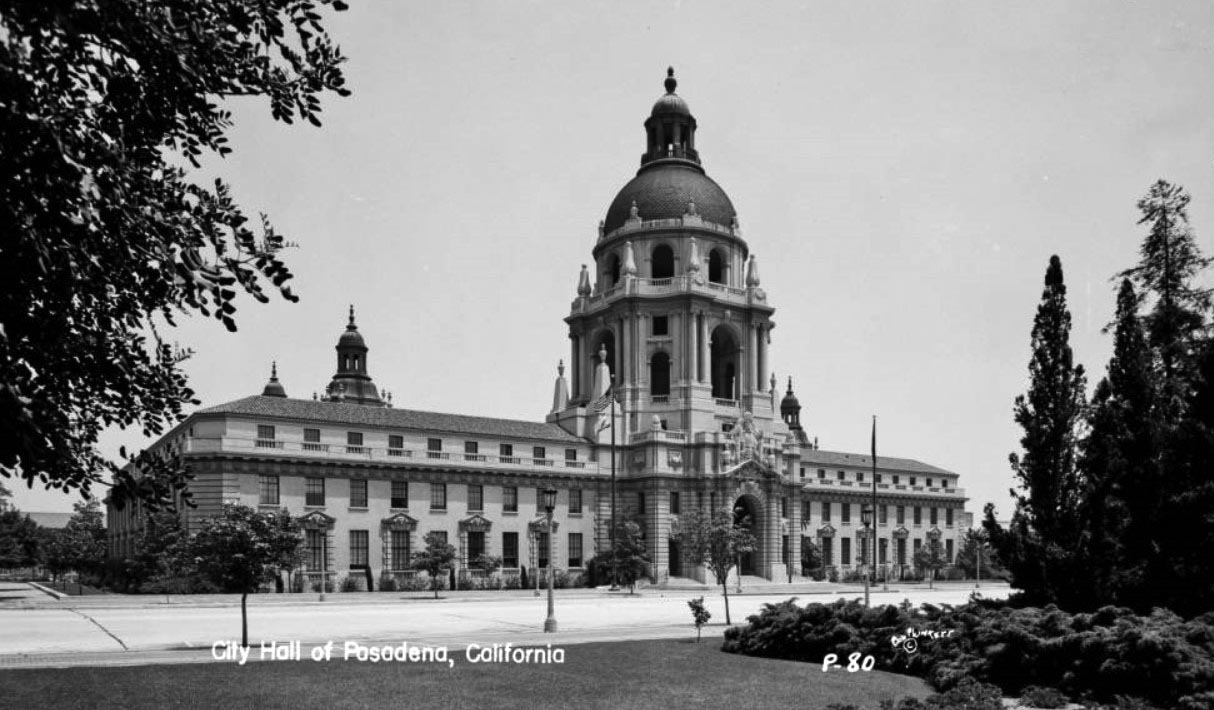 |
|
| (ca. 1948)#* – Postcard view showing the Pasadena City Hall building and lawn as seen from across Garfield Street. |
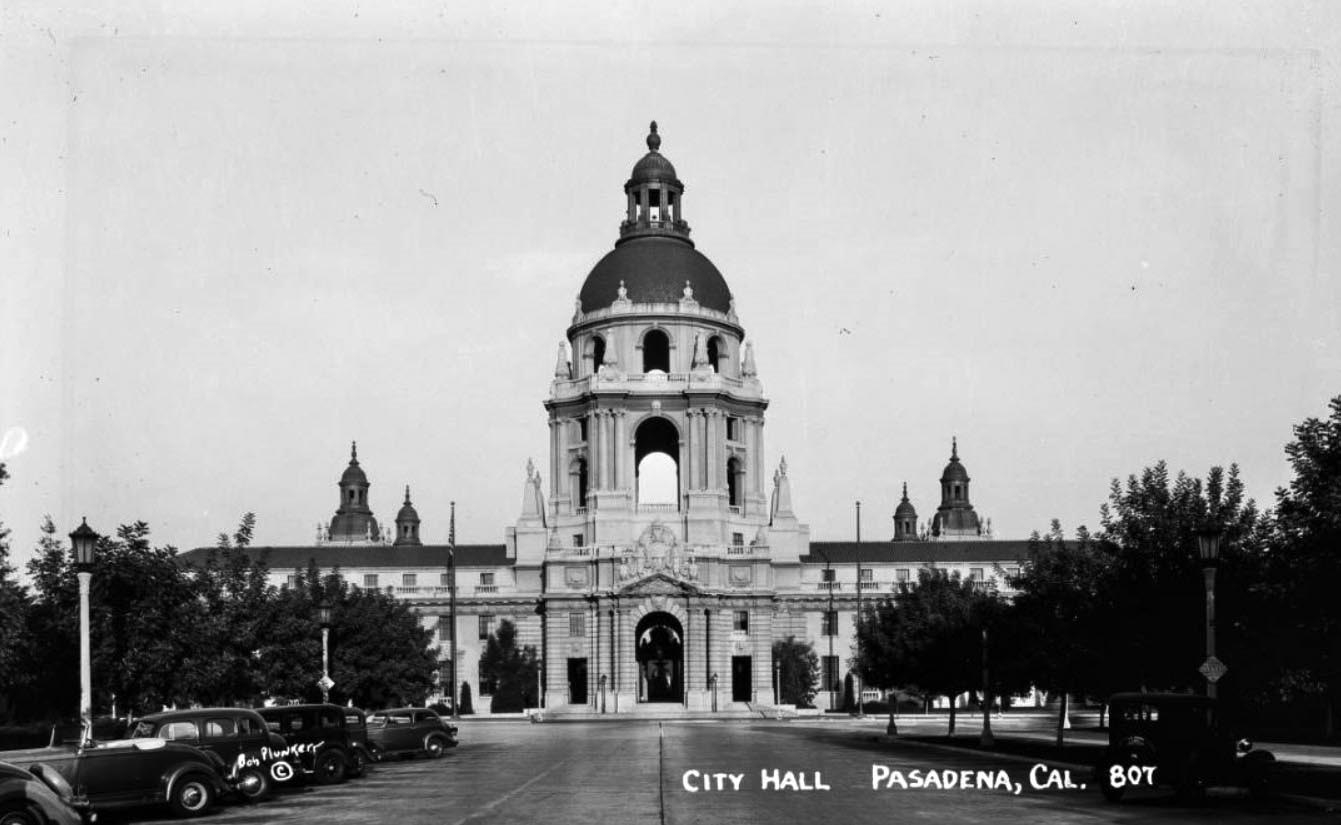 |
|
| (1940s)#* - Postcard view of Pasadena City Hall as seen looking down East Holly Street, with automobiles parked at the curb. |
Historical Notes City Hall is an internationally recognized star of stage and screen, appearing in Chaplin’s “The Great Dictator” in 1940, and many, many films, television shows, and wedding albums since. |
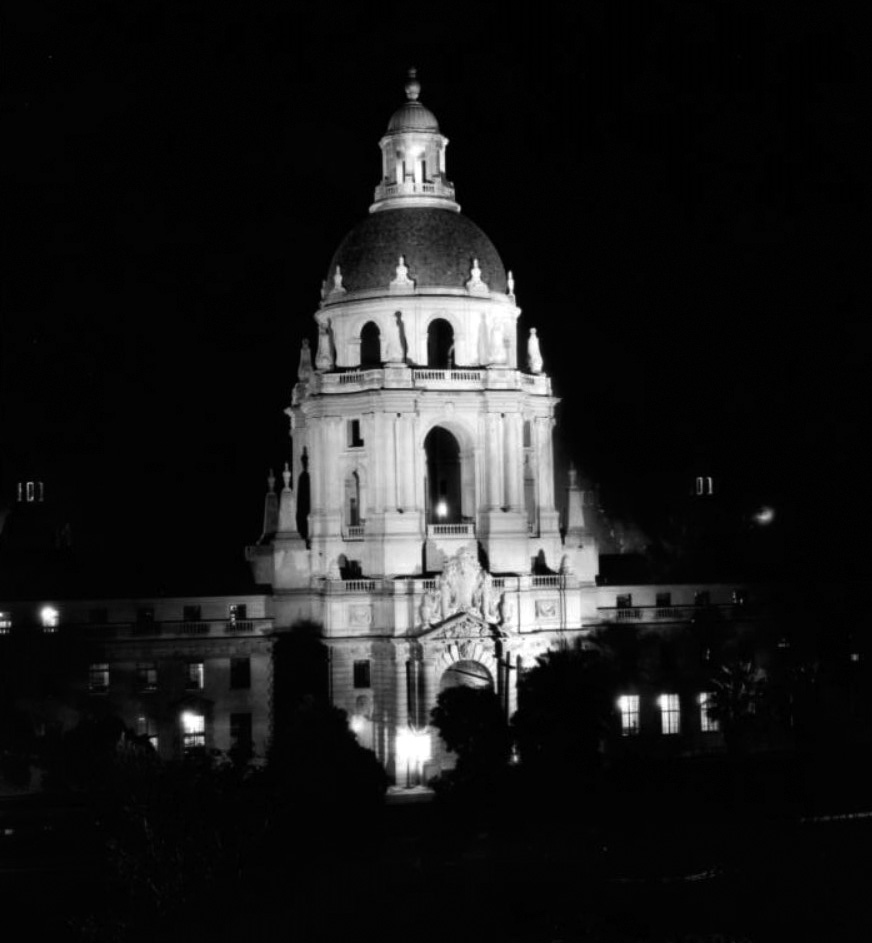 |
|
| (ca.1928)^ – Nightime view showing the large, lightly-colored City Hall building with a dome at the top of its center tower. A statue stands over the large doorway. The bright interior lights shine through the windows to the trees of the yard in the foreground. |
Historical Notes Pasadena City Hall served as the city hall of fictional Pawnee, Indiana, in the television show "Parks and Recreation." The dome is visible through the window of the main characters' apartment building in the television show The Big Bang Theory.^ |
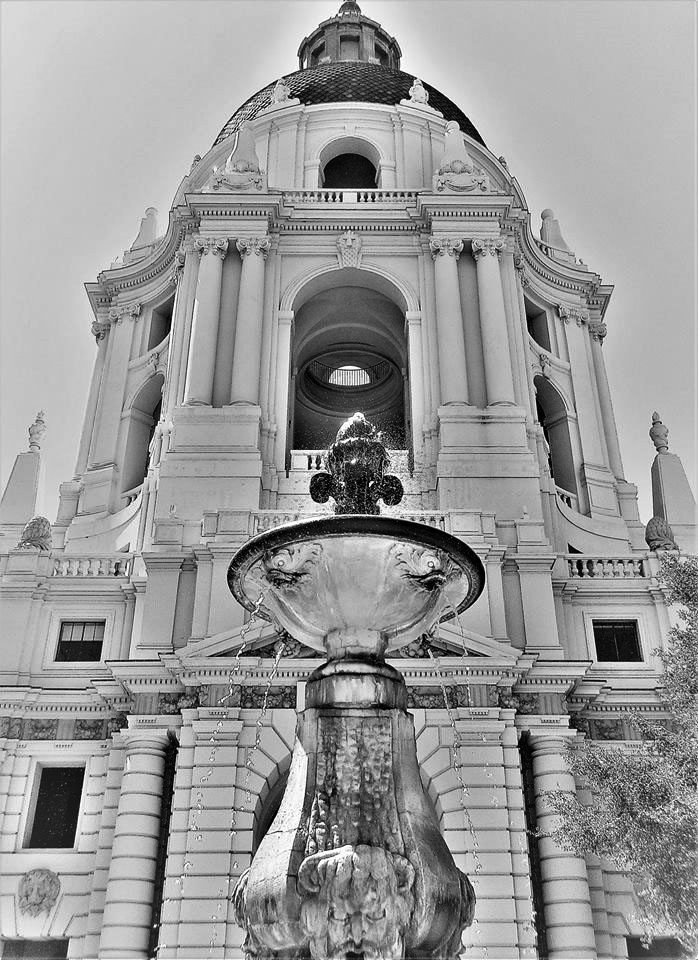 |
|
| (2019)^.^ - Looking up toward the top of Pasadena City Hall. Photo courtesy of Howard Gray |
Historical Notes On July 28, 1980 the Civic Center District, including Pasadena City Hall, was listed on the National Register of Historic Places. |
Civic Center District
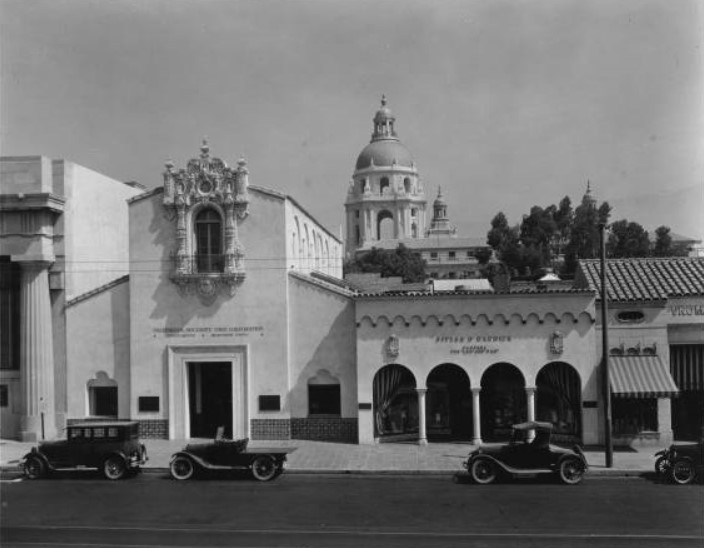 |
|
| (1929)**- The buildings on the north side of East Colorado Street give a sense of Pasadena's business district on the eve of the Depression. The storefront with the arches is the Pitzer and Warwick clothing store, boasting the slogan "For Lad and Dad." On the far right is Vroman's Bookstore. The building with the column on the left is First National Bank located at 301 East Colorado Boulevard. Pasadena's iconic city hall rises up in the background. |
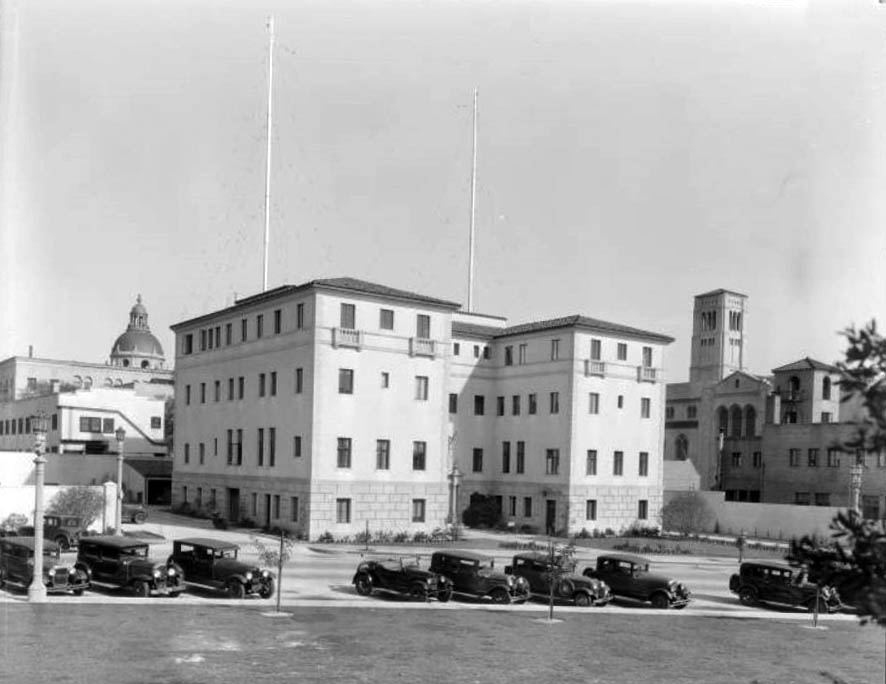 |
|
| (1931)*^* - Street view of the Pasadena Hall of Justice at 142 North Broadway. The building is large and multistory, and has a parking lot in which numerous automobiles are parked. |
Pasadena Civic Auditorium
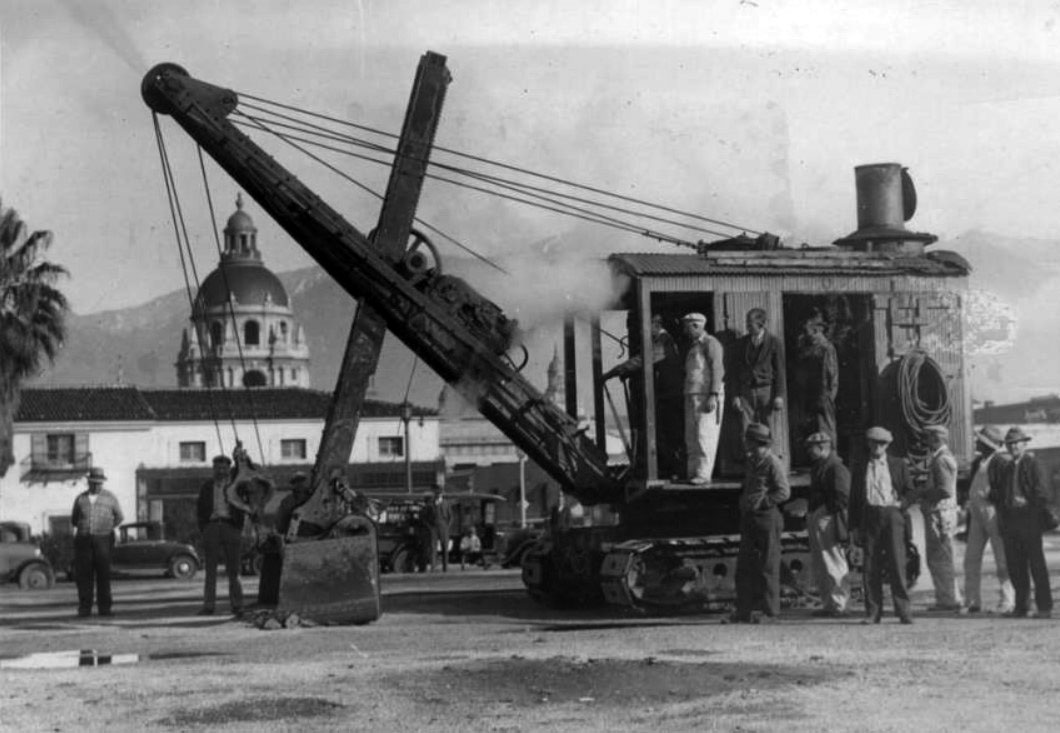 |
|
| (1931)*– View showing men standing around a steam shovel during the ground breaking of the Pasadena Civic Auditorium. City Hall can be seen in the background. |
Historical Notes In February, 1932, during the lowest ebb of the Great Depression, the new Pasadena Civic Auditorium was dedicated "to the citizens of Pasadena, whose efforts and sacrifices have made the erection of this beautiful and useful building possible." In the decades since its dedication, the Civic has hosted millions of patrons from several generations of Southern Californians. |
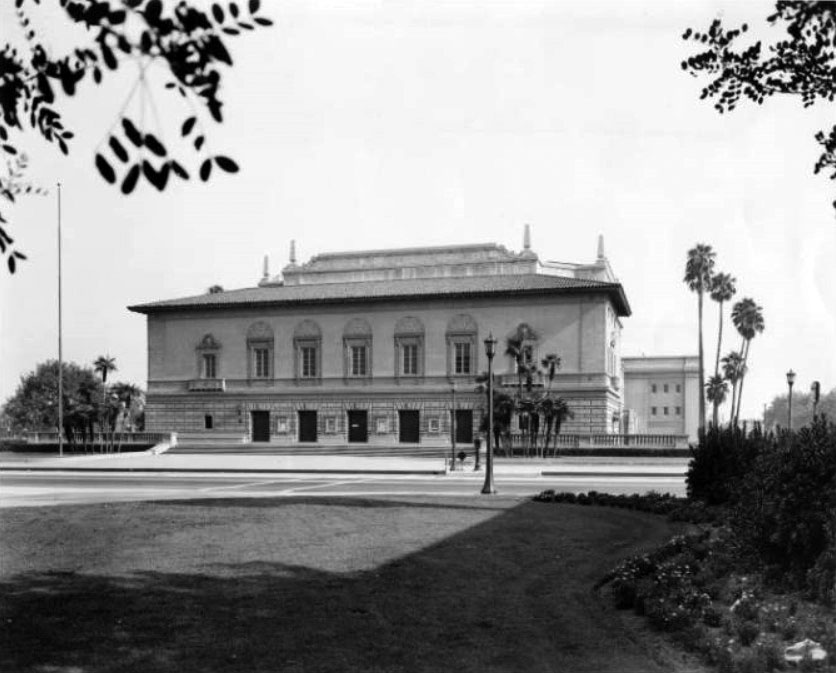 |
|
| (1930s)* – View showing the Pasadena Civic Auditorium surrounded by a well-manicured lawn and palm trees, located at 300 E. Green Street. |
Historical Notes The Civic Auditorium has been the center of Pasadena's Cultural life by hosting thousands of community events such as Rose Queen Ceremonies, graduations, benefit concerts, speeches by famous personalities, and countless programs for children. The live radio broadcasts of the big band dances from the Civic in the 1940s helped to spread the fame of Pasadena across the United States. |
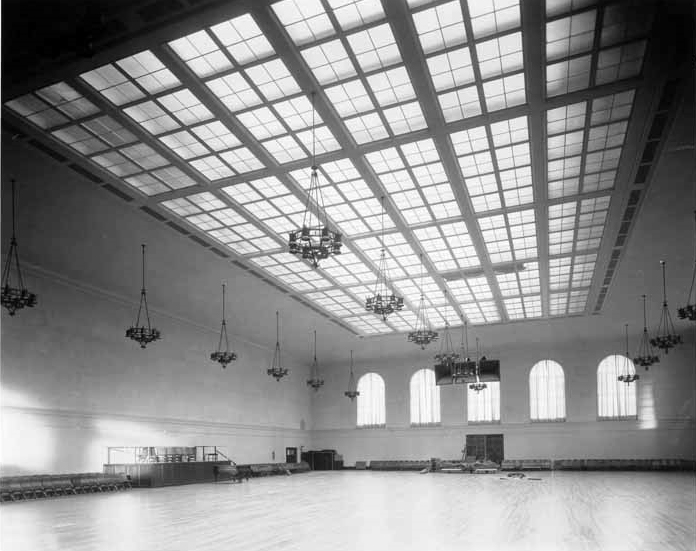 |
|
| (ca. 1932)* - View showing the Exhibition Hall of the Pasadena Civic Auditorium Building. |
Historical Notes The hall was originally constructed in 1931 as part of the civic center and the original Civic Auditorium and was used as an exhibit hall and ballroom. |
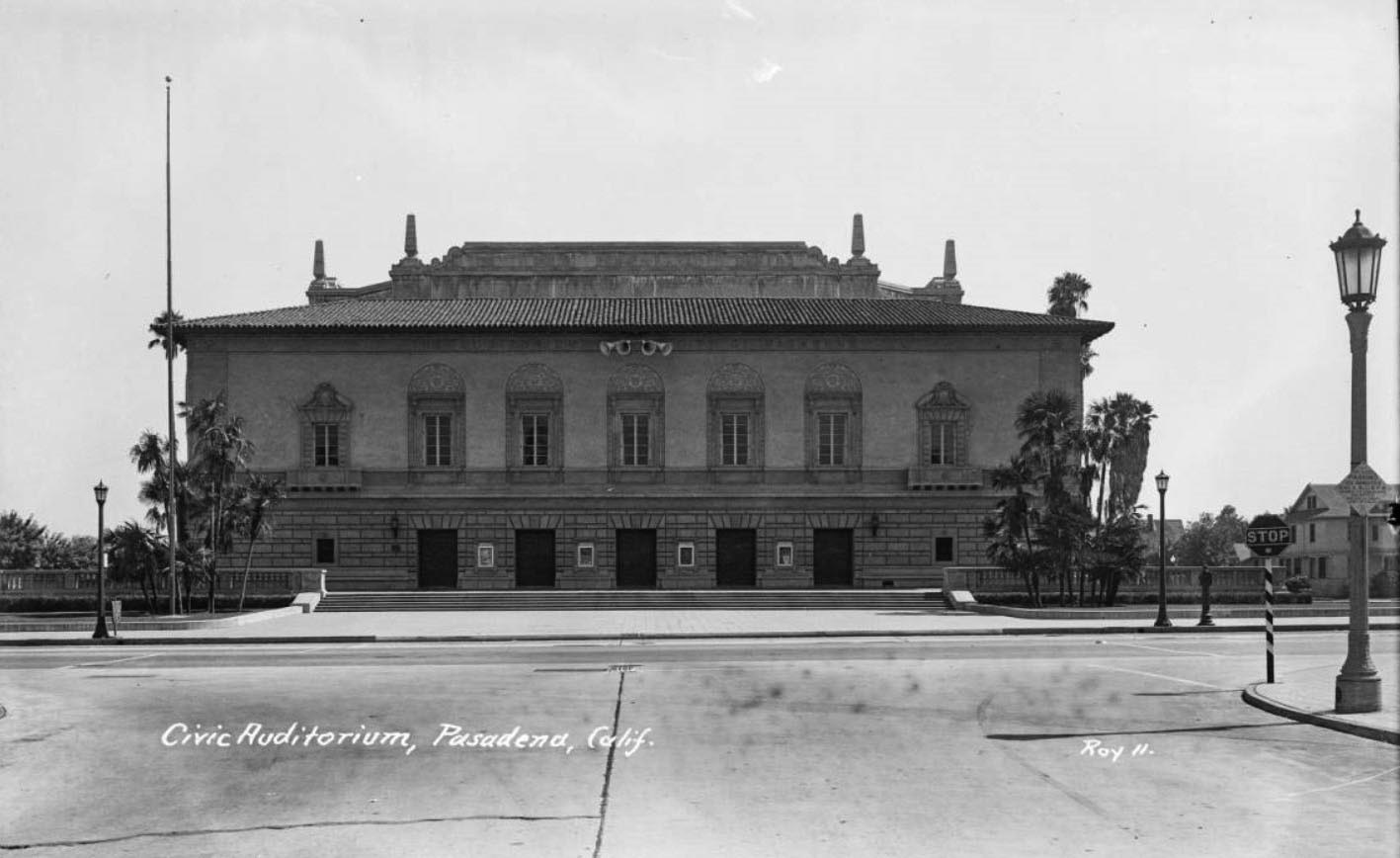 |
|
| (1940s)* – Postcard view showing the Pasadena Civic Auditorium, facing on Green Street, with palm trees planted near entrance. |
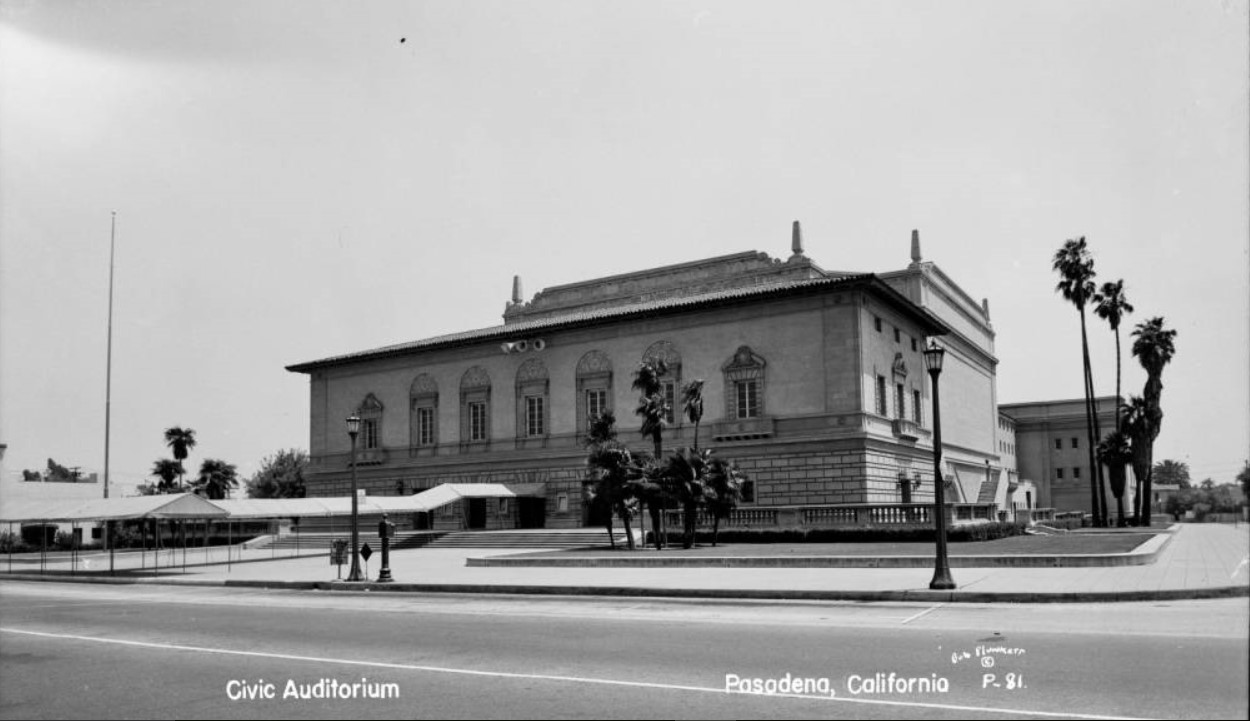 |
|
| (1948)* – Wide angle view of the Pasadena Civic Auditorium on Green Street in Pasadena. Palm trees are planted around the building, and a covered walkway leads to the steps. Click HERE to see contemporary view |
Historical Notes The hall became the Pasadena Ice Skating Center in 1976 until the center moved to a new location in the Convention Center courtyard in 2011. It is listed on the National Register of Historic Places. |
* * * * * |
Map of Pasadena Highlights
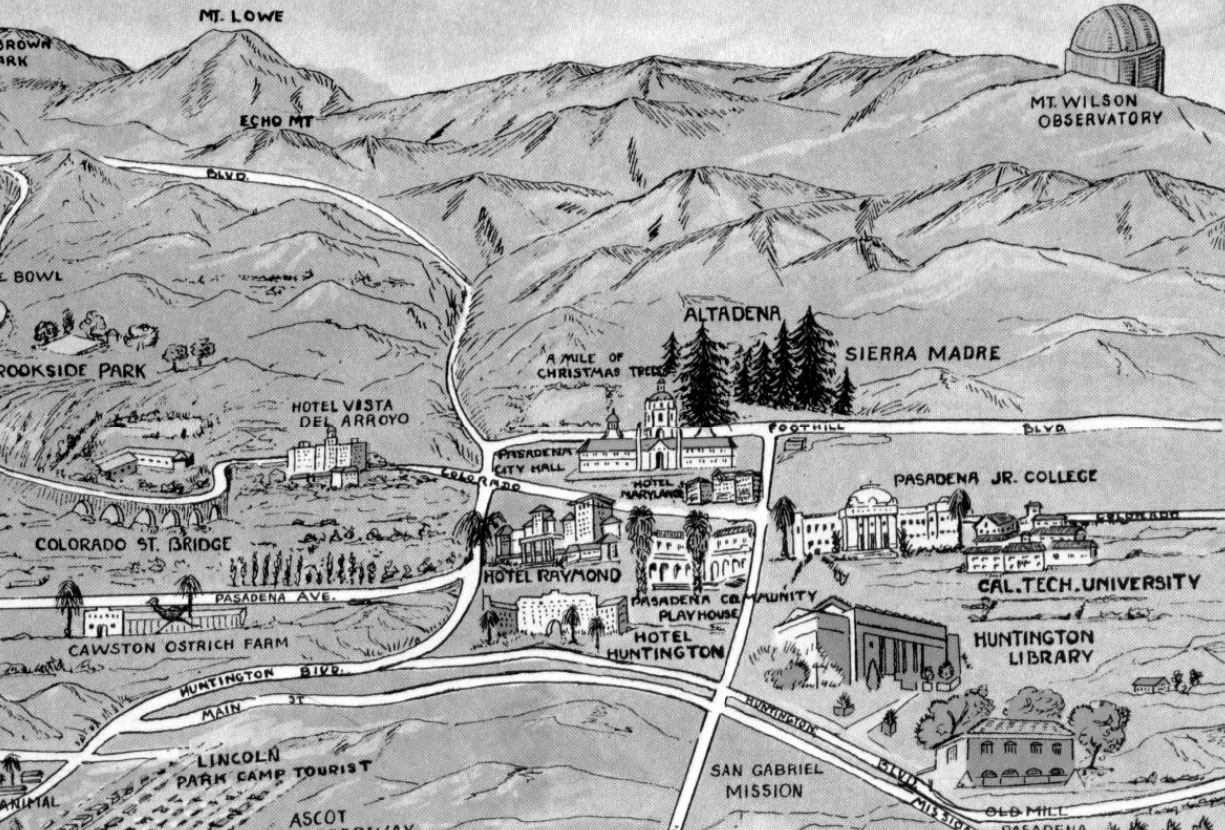 |
|
| (1932)* – Map showing Pasadena and surrounding area. Some of the highlights include (L to R): Cawston Ostrich Farm, Colorado Street Bridge, Hotel Vista Del Arroyo, Brookside Park, Mt. Lowe, Christmas Tree Lane, Pasadena City Hall, Hotel Raymond, Pasadena Playhouse, Hotel Huntington, Huntington Library, Cal Tech University and Mt. Wilson Observatory. Source: Library of Congress. |
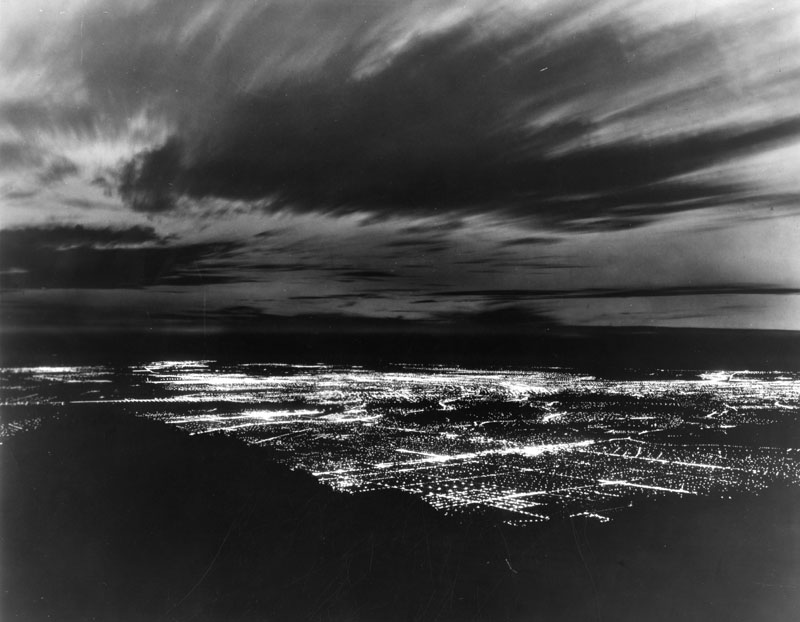 |
|
| (1929)* - Scenic night view of Pasadena and surrounding areas in the Valley, from Mount Wilson in 1929. |
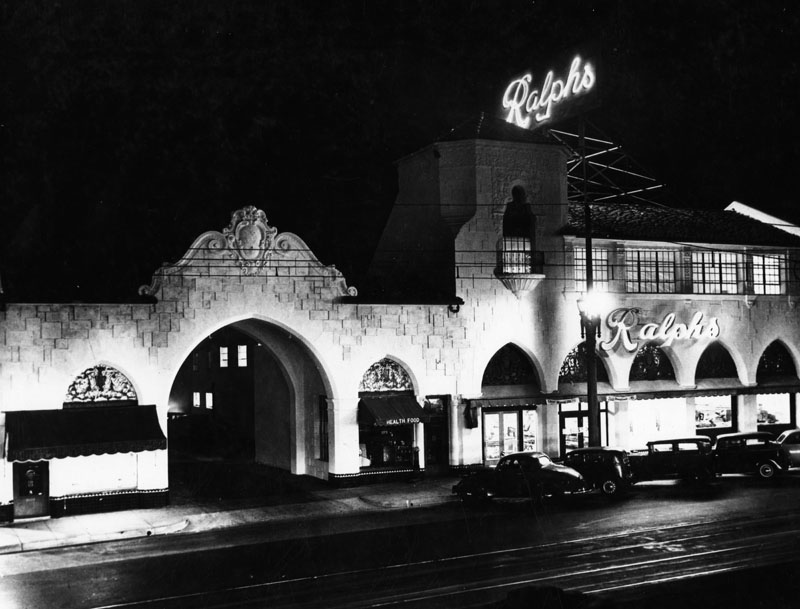 |
|
| (1929)* - Night view of the exterior of Ralphs Grocery Store in Pasadena, built in the 1920s. |
List of Awards Ralphs Grocery Company was founded in 1873 by George Albert Ralphs with the original store being located at Sixth and Spring Streets in Los Angeles. The company employed notable architects in designing its stores. Click HERE to see an 1886 photo of George Ralphs standing in front of his original store in the Early LA Buildings (1800s) Section.” |
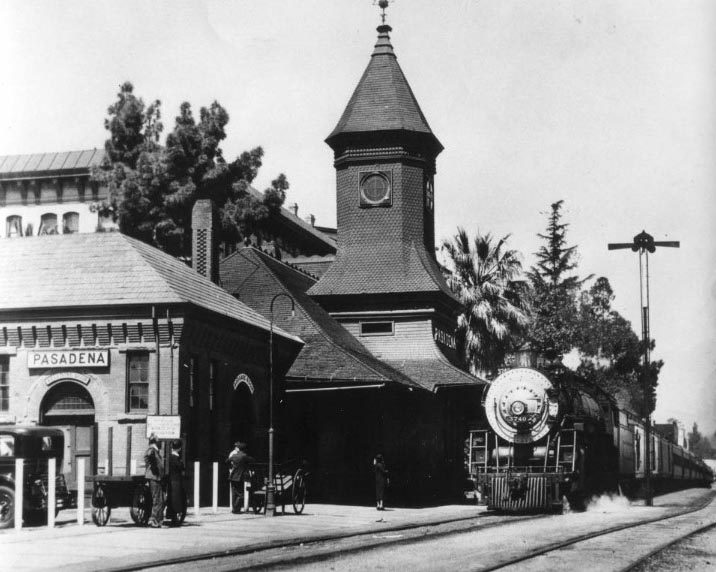 |
|
| (1929)** - View of the Santa Fe Railroad Pasadena Station, with train stopped in front. The Hotel Green is in the background (upper-left). |
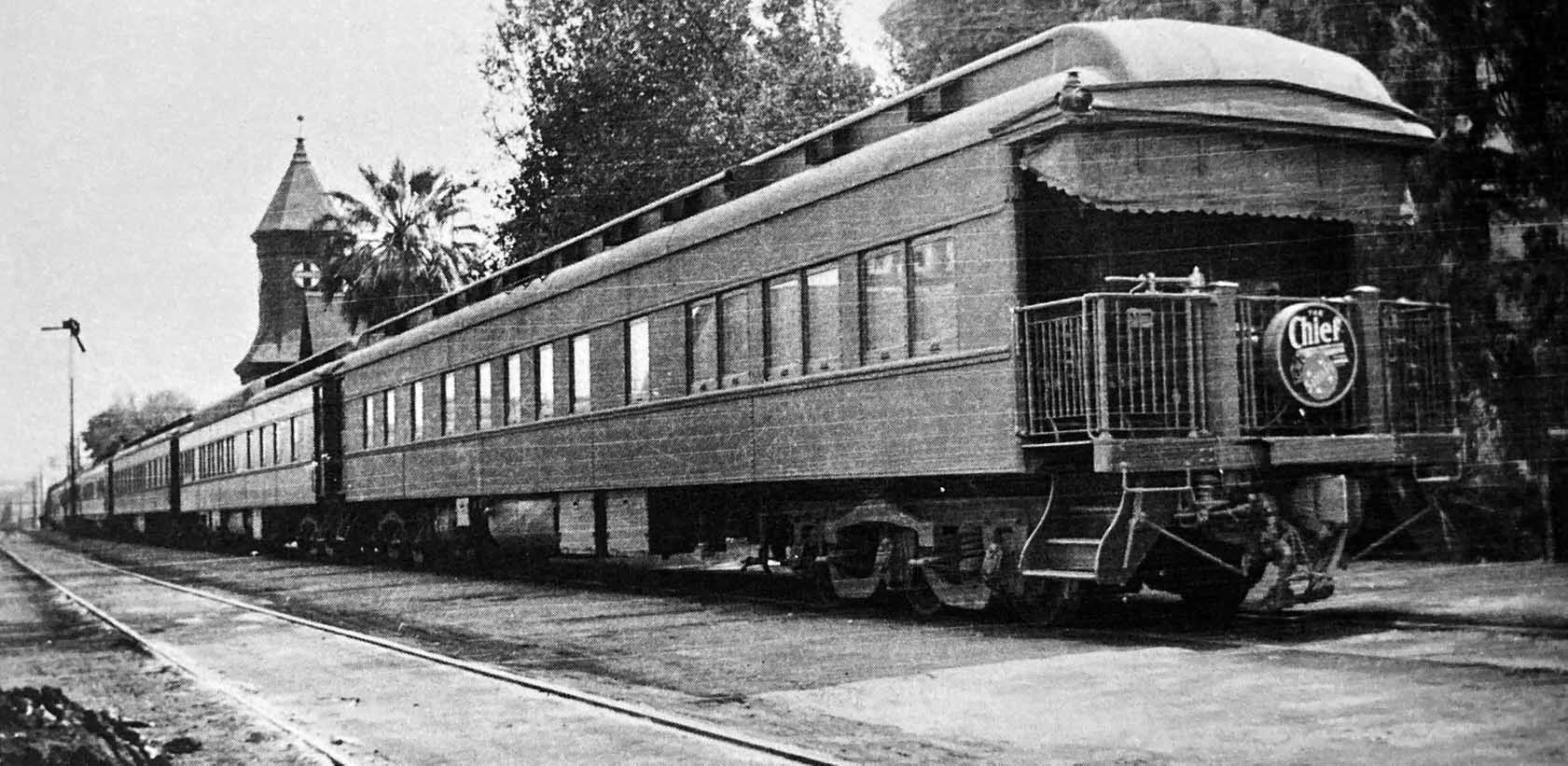 |
|
| (1920s)* - View of Santa Fe Chief observation car at Pasadena depot. |
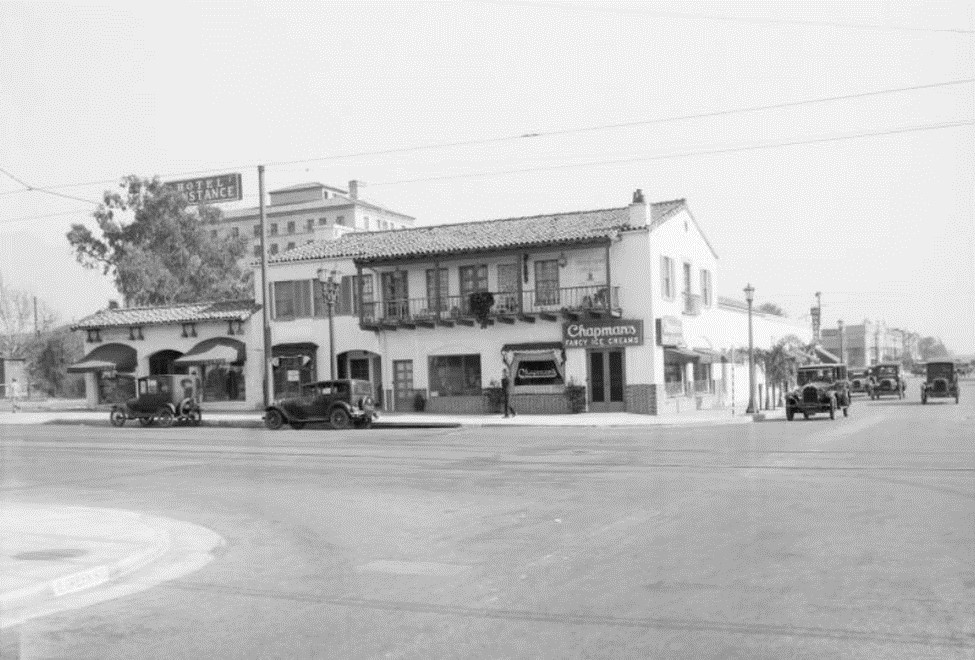 |
|
| (1929)#* - Street view of East Green at the corner of Green and Lake looking northeast. Chapman's Fancy Ice Creams is on the corner, with shops above and beside it, and the Hotel Constance is in the background. Cars are parked along the street. |
 |
|
| (1928)#* - Close-up view of Chapman's Ice Cream Store at 60 South Lake the northeast corner of Lake and Green. The shops above the ice cream parlor are the Spanish Shops Incorporated Importers. |
* * * * * |
Please Support Our CauseWater and Power Associates, Inc. is a non-profit, public service organization dedicated to preserving historical records and photos. Your generosity allows us to continue to disseminate knowledge of the rich and diverse multicultural history of the greater Los Angeles area; to serve as a resource of historical information; and to assist in the preservation of the city's historic records.
|
More Historical Early Views
Newest Additions
Early LA Buildings and City Views
History of Water and Electricity in Los Angeles
* * * * * |
References and Credits
* LA Public Library Image Archive
^*California Historic Landmark Listing (Los Angeles)
^#South Pasadena Middle School Home Page
#* Huntington Digital Library Archive
## Google Maps
++ Squareone.org: Pasadena Winter Garden
^^*LA Times Framework: Palomar Telescope
*^^Nuestra Señora la Reina de los Ángeles: losangelespast.com
***Pasadena Museum of History: Pacific Electric Railway Then and Now
**#Metro Transportation Library and Archive
+**Automobile in American Life and Society
++*Estately Blog: Colorado Street Bridge Postcard
+++Facebook.com – Los Angeles Heritage Railroad Museum
#+#Facebook: Hollywood's Garden of Allah novels, by Martin Turnbull
^++Pomona Library Image Archive
+^+Pasadena: A Business History: The Model Grocery
^+^Master Plan of Highways - County of Los Angeles
^*#Noirish Los Angeles - forum.skyscraperpage.com; Oak Knoll PE Line
*#*KCET: Colorado Street Bridge; L.A.'s First Freeways
*##Los Angeles Movie Palaces: Fox Pasadena
#^^Hometown Pasadena: Tower Theatre
#^#Pyroil - The Wonder Gas: theoldmotor.com
#*#Pasadena Adventure: walknridela.com
##*The Pasadena Civic - History
##+Waymarking.com: First Church of Christ, Scientist Pasadena
**^^Cinema Treasures: Florence - State Theatre; Tower Theatre
*^^*Pasadena: A Busines History
^***Facebook.com: I Grew Up in San Gabriel Valley: Colorado Blvd.
^^**Cruiselinehistory.com: Pasadena Santa Fe Station – Gateway to Hollywood
^^*#Facebook.com - Pasadena Digital History
^++^Facebook: Los Angeles Heritage Railroad Foundation
#^^*Pasadena Star News: Pasadena Civic Auditorium; Drone View of Pasadena City Hall; Pasadena Playhouse
#^^^The City of Pasadena - cityofpasadena.net: Central Library
##++Flickr.com: Boston Public Library
++##Facebook:AmericarTheBeautiful
**##Eating L.A. - Guinn's Coffee Shop and Drive-in
*^ Wikipedia: History of Pasadena; Tournament of Roses Parade; The Langham Huntington; Hotel Green; Rose Bowl Game; Pasadena City Hall; Old Town Pasadena; Los Angeles Terminal Railway; Richard H. Chambers United States Court of Appeals and the Vista del Arroyo Hotel and Bungalows; California Institute of Technology; William G. Kerckhoff; Van de Kamp's Holland Dutch Bakeries; Bank of Italy; Arroyo Seco Parkway; Pasadena; United Cigar Stores; Pasadena Star-News; Arroyo Seco; American Legion; Pasadena via Oak Knoll PE Line; Hupmobile
< Back
Menu
- Home
- Mission
- Museum
- Major Efforts
- Recent Newsletters
- Historical Op Ed Pieces
- Board Officers and Directors
- Mulholland/McCarthy Service Awards
- Positions on Owens Valley and the City of Los Angeles Issues
- Legislative Positions on
Water Issues
- Legislative Positions on
Energy Issues
- Membership
- Contact Us
- Search Index